We've refreshed our website design so things may look a little different if you've been here before. We'll be making more improvements soon so watch this space.

Northern Lights
The Northern Lights - also called the Aurora Borealis - are nature’s very own theatrical performance. It may be a surprise to you, but northern Scotland actually lies at the same latitude as Stavanger in Norway and Nunivak Island in Alaska, which means that you’re in with a good chance of spotting the ‘Mirrie Dancers’. In 2024, Expedia experts highlighted the UK as a hotspot destination for spotting the Northern Lights, specificially on the Isle of Skye between October and March!
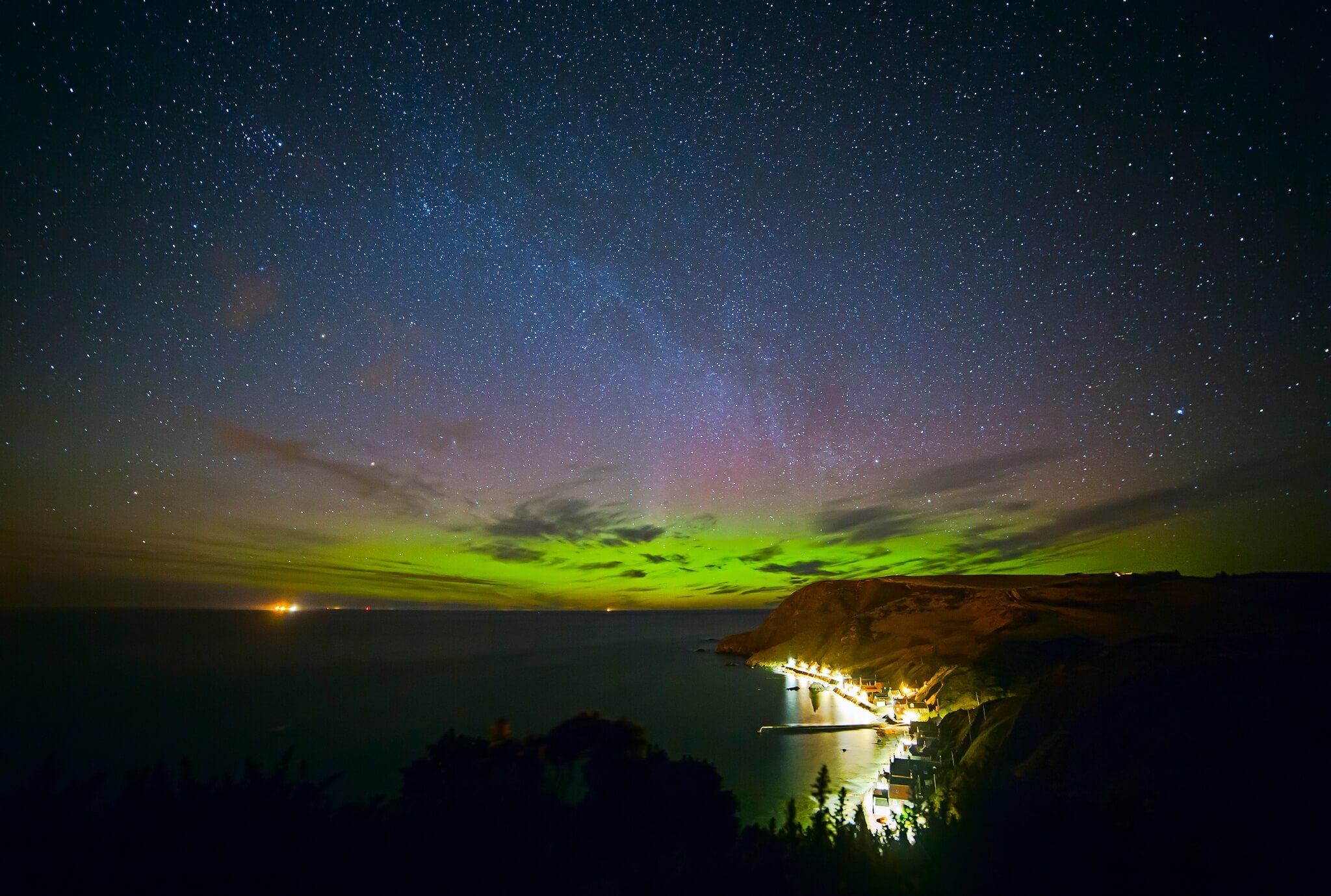
Northern Lights over Cullen bay
© VisitScotland / Discover Fraserburgh / Fiona McRae
When is the best time to see the Northern lights?
Aurora Borealis at Tarbat Ness Lighthouse
© Iona Spence
Autumn and winter seasons, with their long periods of darkness and the frequency of clear nights, are probably the best time of the year to experience the auroral displays. Nights need to be cold and the sky clear of clouds, with limited light pollution and increased solar activity. Staying up until the wee hours of the morning may also help.
Keep an eye on the Aurora Forecast which offers notifications on increased auroral activity by free text message alerts.
Find out more on the Aurora Watch UK website
Where can I see the Northern Lights in Scotland?
While the northern reaches of Scotland offer better chances of spotting the ‘Mirrie Dancers’, the aurora can be seen anywhere in Scotland when the right conditions are met and where the light pollution is at a minimum. Here’s a list of some of the best places to see this marvel:
Northern Lights at Gairloch
© Four Seasons Campers / Peter Sandground
In the Hebrides, the lights can be seen on Lewis, Harris and at the most northerly tip of Skye. The quirky Shulista Croft Wigwams are a cosy base for exploring the Trotternish Peninsula on Skye, which is home to no less than nine Dark Sky Discovery Sites, making it one of the best places in Scotland for stargazing, as well as hunting for the Northern Lights.
Find out more about the Shulista Croft Wigwams
Further north, you can also catch the lights in Shetland , Orkney and Caithness .
Places like Applecross , Lochinver and north of Ullapool are great spots on the far north west coast of Scotland to catch a glimpse of the Aurora Borealis.
Rannoch Moor , Perthshire and the Cairngorms are all places where the lights have been spotted.
The Northern Lights at Hilton of Cadboll Stone
© Mark Janes
The elusive Aurora Borealis can also be seen on the east coast. Sometimes you just need a bit of luck! When the conditions are right, the lights have been spotted in Aberdeenshire and the Moray Coast , Angus , Fife and East Lothian .
If an aurora is strong, it can occasionally be seen in the capital. Some of the best vantage points in Edinburgh include Calton Hill, Blackford Hill and Arthur's Seat. Staying up into the wee hours of the morning will increase your chances of a sighting.
One of the best places to view the Northern Lights is in Galloway Forest Park - the only Dark Sky Park in Scotland!
What causes the Aurora Borealis?
The Northern Lights viewed from Oban
© VisitScotland / Oban and Lorn Tourism Alliance / Sheila McIntyre
Named after Aurora (the Roman goddess of dawn) and Boreas (the Greek name for north wind), this amazing spectacle is caused by charged particles accelerated into the Earth's upper atmosphere along magnetic field lines. The energy to drive this display is provided by the sun, in the form of a 'solar wind'. The sun may be millions and millions of miles away, but it is the reason we see this extraordinary sight.
Aurorae come in all colours, shapes and patterns, setting the night sky alive with rainbows of light. The variations in colour are due to the type of gas particles that are colliding, from yellowish-greens, blues and purples, to fiery reds and oranges. The playful streaks that snake across the night sky evolve and change constantly, and can last minutes or merely seconds. One thing is for certain: the end result is always truly spectacular.
Capturing the Northern Lights
When the conditions are perfect and the sky glows with colour, your next thought might be night-time photography. Taking a great shot of the night sky is quite a skill - both a sturdy tripod and a wide-angle lens will improve your image quality.
For more tips, check out this photography guide
Your Northern Lights photos
Cookies are needed to see social media images from this place.
JavaScript needs to be enabled to see social media images for this place. You can turn this on in your browser settings.
Admire the twinkling skies overhead...
JavaScript needs to be enabled to watch this video. You can turn this on in your browser settings.
Scotland enjoys some of the darkest skies in Europe. You might even be lucky enough to spot the mesmerising Northern Lights!
Find experiences
JavaScript needs to be enabled to see this product search form. You can turn this on in your browser settings.
Other things you might like
Dark sky parks & stargazing in scotland.
Scotland's National Parks and Natural Heritage Sites
11 of the best beaches in Scotland
Forests & Woodlands
Hills, Mountains & Peaks in Scotland
Glens in Scotland

14 Iconic Scottish Views
Join our newsletter clan.
Get Scotland inspiration direct to your inbox. Don't miss the inside track from our Scotland experts on exciting trip ideas, unique attractions and hidden gems loved by locals.

The Best Places to See the Northern Lights in Scotland
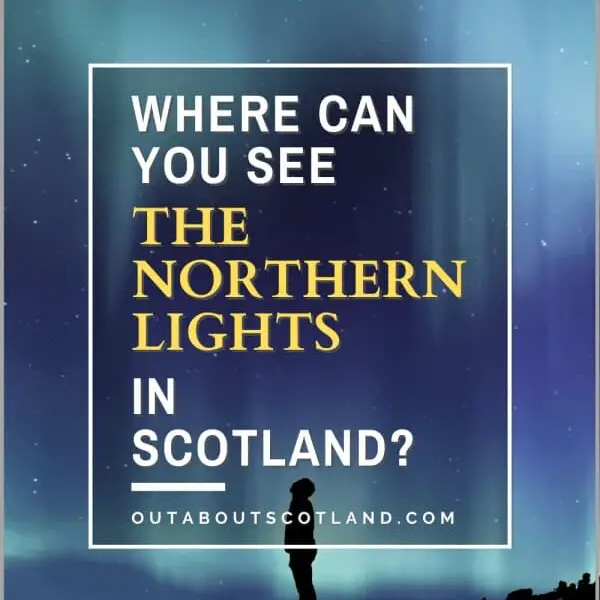
The aurora borealis is one of the most beautiful phenomena in the natural world. These dancing, skipping, multi-coloured lights are caused by charged particles from the sun colliding with the earth’s magnetic field, and they are most visible in northern countries like Scotland.
In this article, you’ll discover the best places to see the northern lights in Scotland as well tips to help you find them, advice for photographing them, and information on Scotland’s fabulous dark sky parks.
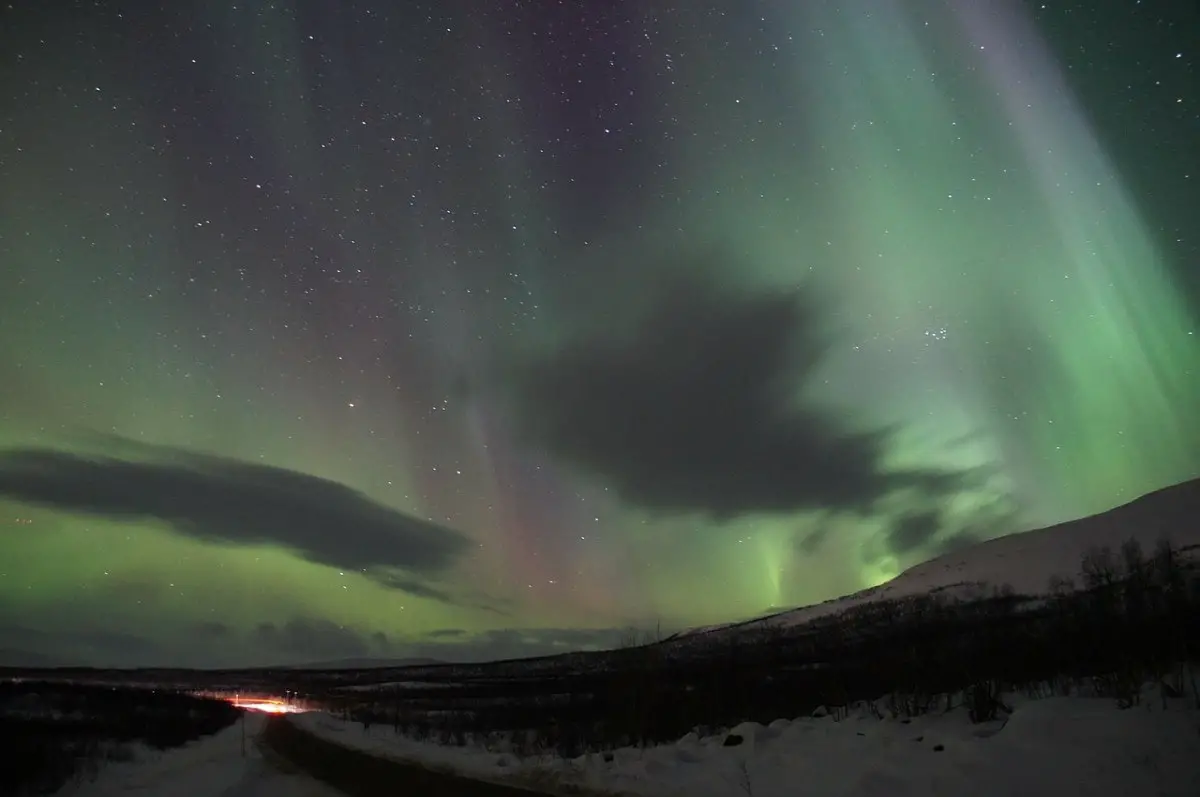
What Are the Northern Lights?
The northern lights – also known as the aurora borealis – is a naturally occurring spectacle that most people have heard of but few have actually seen. In Scotland we call these lights ‘Mirrie Dancers’ and they’re often seen in the remotest parts of the country during autumn and winter when the nights are long, cold and clear.
There’s a lot of science behind the northern lights, and having a wee bit of background knowledge about what causes them to appear can drastically improve your chances of seeing them. So what, exactly, are they?
To look at, the aurora borealis is a dancing light display in the sky comprised of shimmering bands of changing colours that range from green (the most predominant colour) to yellow, blue, and purple. Their intensity starts off as barely visible, but as the sky darkens, they become ever brighter until the flickering ribbons are replaced by intense coronas of shifting colours that are occasionally joined by arcs, rippling curtains, and shooting rays.
In actuality, activity on the sun’s surface over 92.94 million miles away is what is causing these lights. Vast solar storms are constantly erupting on the surface of our nearest star, which creates enormous clouds of electrically charged particles that travel out into the solar system.
Although the majority miss our planet, some collide and become captured by the earth’s magnetic field, which pushes them towards the north and south poles. As the particles accelerate, they slam into molecules in our atmosphere, which makes them heat and glow. The lines of the earth’s magnetic field then move the heated particles, producing those well-known wavy neon patterns in the night sky.
But what about the colours? Well, again, there’s some interesting science behind the phenomenon. The two main gases in our atmosphere are nitrogen and oxygen, and if you remember your science class at school, you’ll know that different gases radiate different colours when they’re heated.
That’s why the northern lights are usually seen as green and yellow, as oxygen produces those colours when heated, while blues and purples are caused by heated nitrogen. The quantity of these elements varies between the layers of our atmosphere, so as the solar particles hurtle towards us, they create different colours depending on which elements are heated up.
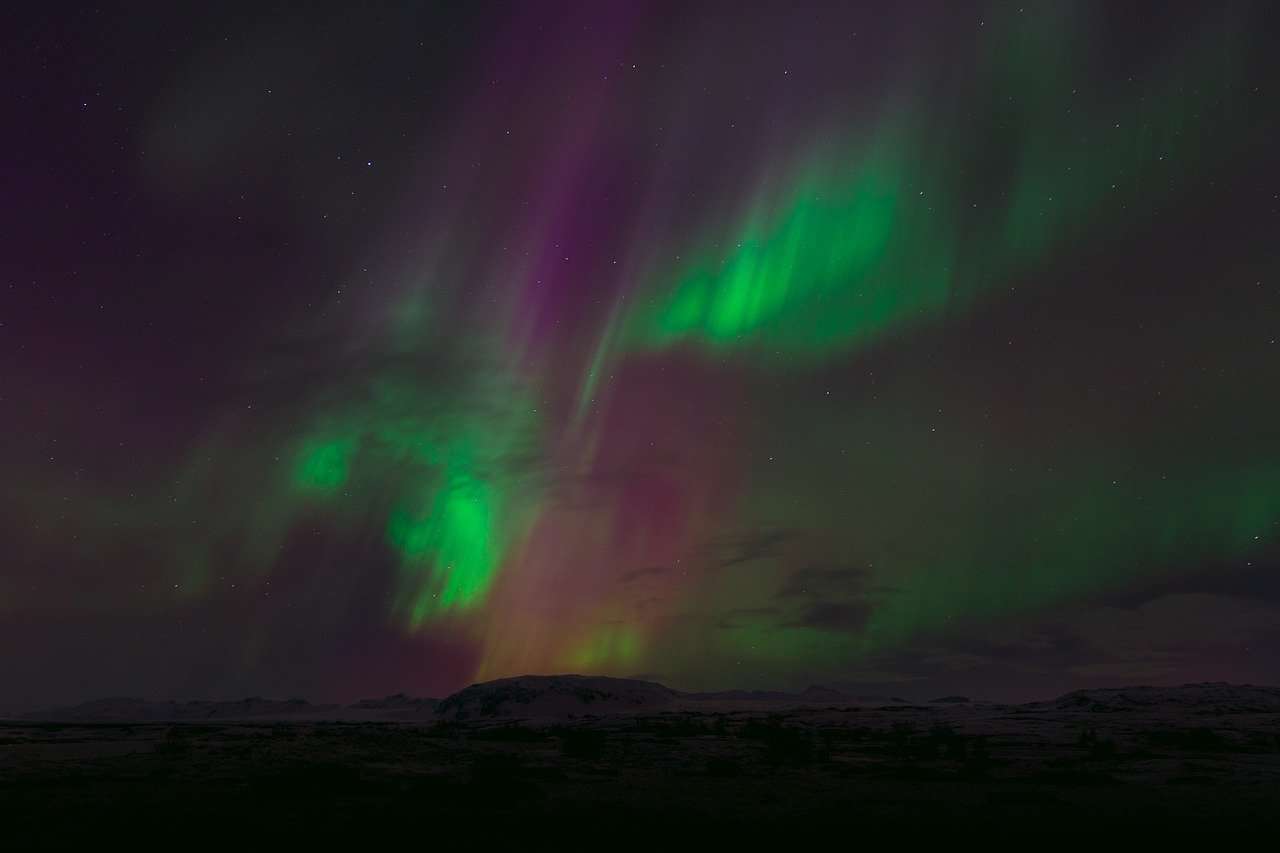
That’s the science bit over, now how to put that knowledge to good use?
First off, because the aurora borealis is concentrated at the poles they’re most visible at high latitudes which is why Scotland is such a good place to see them. The northern tip of our mainland lies at the same level as Stavanger in Norway, while our northernmost Shetland Isles are equivalent in latitude to Bergen, meaning your chances to see the lights will improve the further north you go.
Second, we are aware that the aurora doesn’t start until 80 miles (128.75 km) above the earth’s surface, so any low-lying cloud will completely block it out. Additionally, because it is so high up and faint, any nearby lights will almost entirely block it out.
Third, because the phenomena is completely dependent on solar activity we’ll have the best chance of seeing it if there are strong storms on the sun’s surface, which means we need an accurate solar forecast.
So that’s four variables that affect our ability to see the northern lights: how far north we are, how much light pollution there is, what Scotland’s weather is doing, and how much solar activity there is. I’ll cover the last two variables further down this page, but for now, let’s take a look at the best places in Scotland to see the northern lights, which are all great aurora-spotting locations with minimal light pollution.
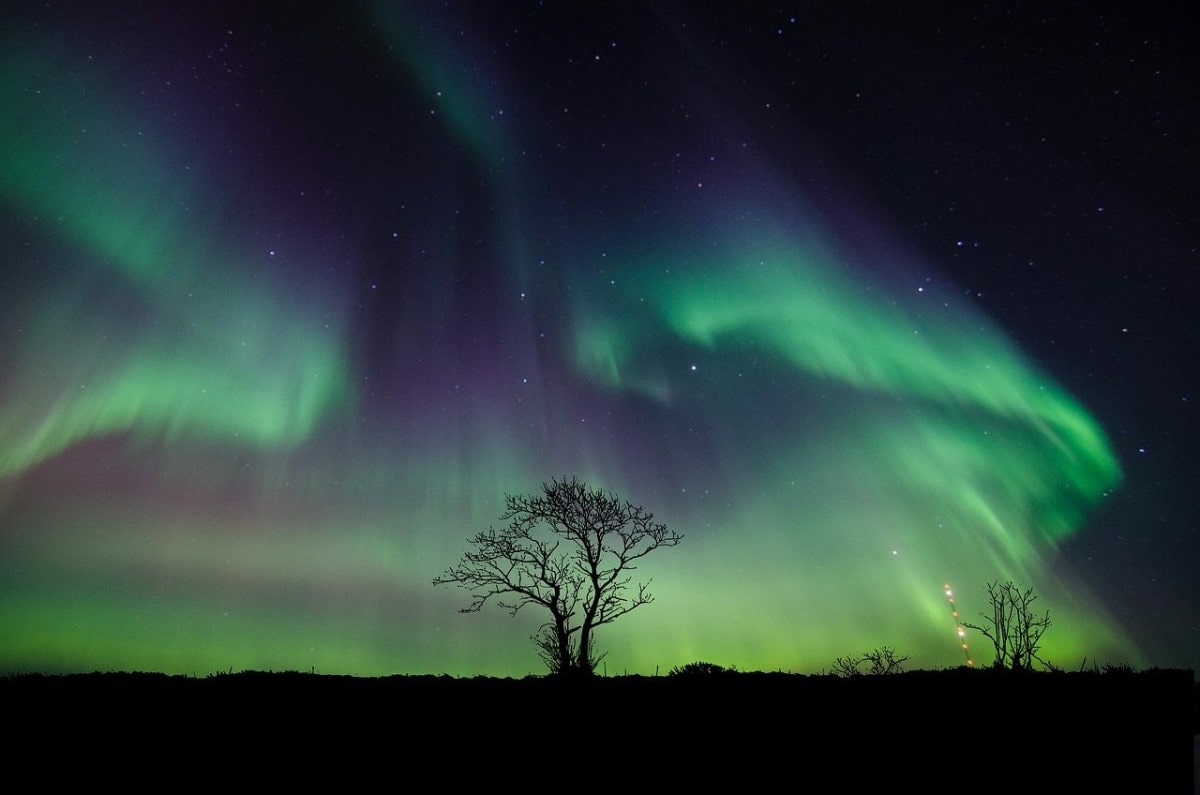
Caithness is a region of Scotland situated on the northernmost part of the mainland facing the Atlantic Ocean and the Pentland Firth. Due to its remoteness, Caithness is only lightly populated so it’s a great place to see the night sky – as long as you stay away from the two main towns of Wick and Thurso that is.
Although they’re not exactly the biggest towns in Scotland, they still have enough light pollution to wash out the aurora borealis, but it’s easy to leave the lights behind by driving west.
From the middle of the north coast all the way around to the west coast, there are only a few villages scattered about, meaning the skies are almost completely unobscured after sunset. Coupled with the fact there are few roads in that part of Scotland, you have the makings of a first-rate Northern Lights experience.
One spot I recommend for viewing the sky is Ben Hope , or at least the area surrounding it. Ben Hope is located in a stunning landscape that’s entirely devoid of human settlements so the sky is pitch black at all times of the year.
There’s a minor road running along the eastern bank of Loch Hope that allows easy access, and if you follow the Ben Hope trail a short distance, you’ll quickly find yourself in an elevated position that’s free from trees and has open views looking towards the west.
The Isle of Coll
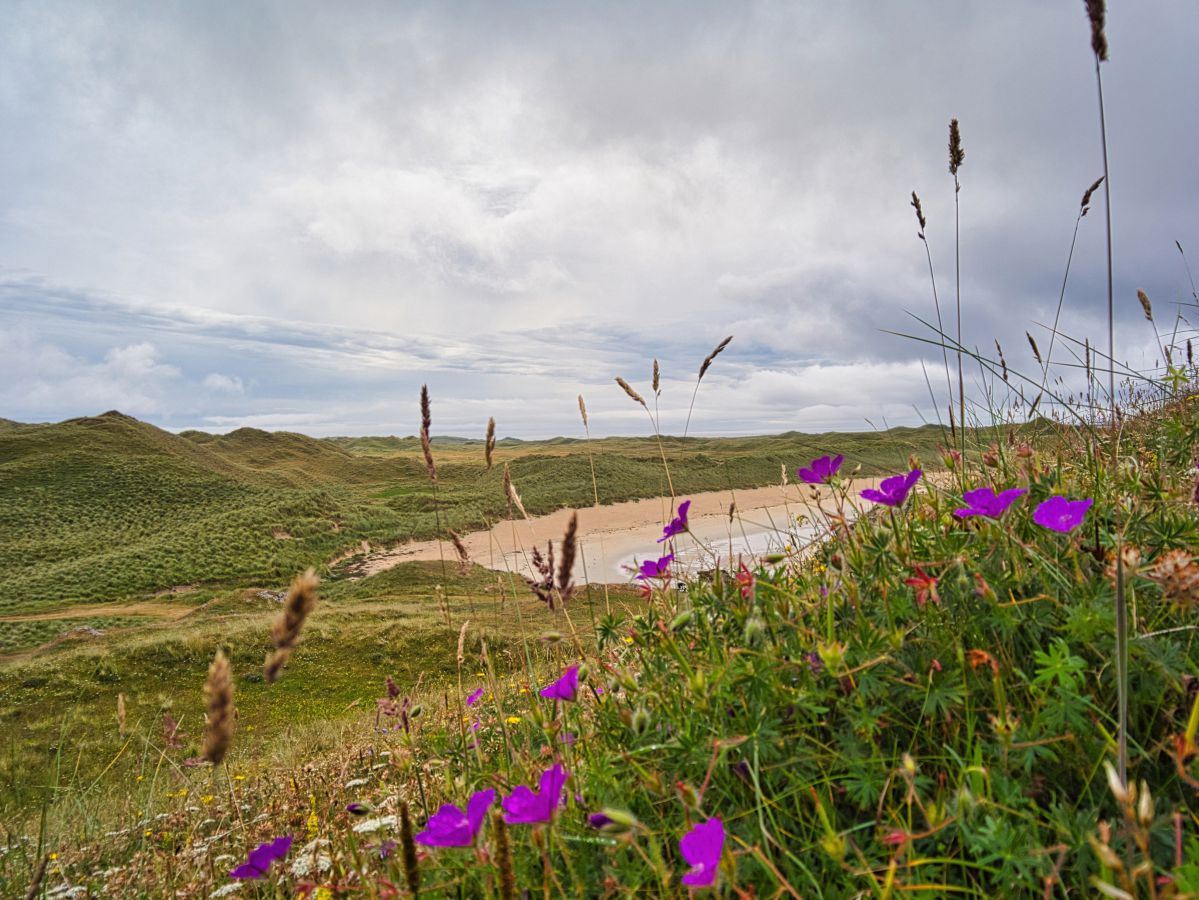
The west coast Hebridean Isle of Coll is one of Scotland’s best-kept secrets. This small island off the northern tip of Tiree sees far fewer tourists than its southern neighbour, yet it’s just as scenic, with lots of secluded beaches around its coastline and mile after of mile of heather-clad moorland in its centre.
Regular ferries from Tiree and Oban mean accessing this small island is easy (especially coming from Tiree where the sail takes less than one hour) although accommodation is sparse at best, requiring bookings to be made months in advance in order to secure a room.
Visitors to Coll will discover a wild and windswept landscape that’s eerily quiet, and also incredibly dark. In fact, Coll is so dark it was officially designated a Dark Sky Park in 2013 and is recognized as having some of the darkest skies in Europe – perfect for viewing the spectacular night skies in that region of Scotland.
Contributing to the lack of light pollution is the island’s insistence on having no street lights, and heading to the northwest tip of Coll takes visitors to an area that’s far from human habitation where the nearest street lamp is over 40 miles away!
While you can go pretty much anywhere on Coll to watch the aurora, the best viewing locations are the official night sky viewing sites at the Cliad football pitch, the Totronald RSPB nature reserve, and the hills overlooking Ariangour village.
However, having visited this beautiful island in 2023, I can personally vouch for overnight stays at the Coll Bunkhouse which runs stargazing weekend breaks that feature an indoor planetarium and expert-led courses on how to use a telescope.
Galloway Forest Park
This is the most southerly location on this list but don’t think that means there’s less of a chance to see the northern lights because Galloway Forest Park is one of the darkest places in Britain.
This vast forest lies on the west coast of Scotland (south of Ayr and west of Dumfries) in a region that’s relatively flat and lightly populated. While there are more villages here than you’ll find further north, it’s almost entirely composed of farmland, so very little – if any – light pollution manages to escape into the park.
Even if you don’t manage to see the aurora borealis there are fun times to be had in the forest thanks to an extensive network of mountain biking routes including the world-famous 7stanes trails. There are also three excellent visitor centres at Kirroughtree, Glentrool, and Clatteringshaws, so if you’re unsure where to head first you might like to visit one of the centres and ask the staff for advice.
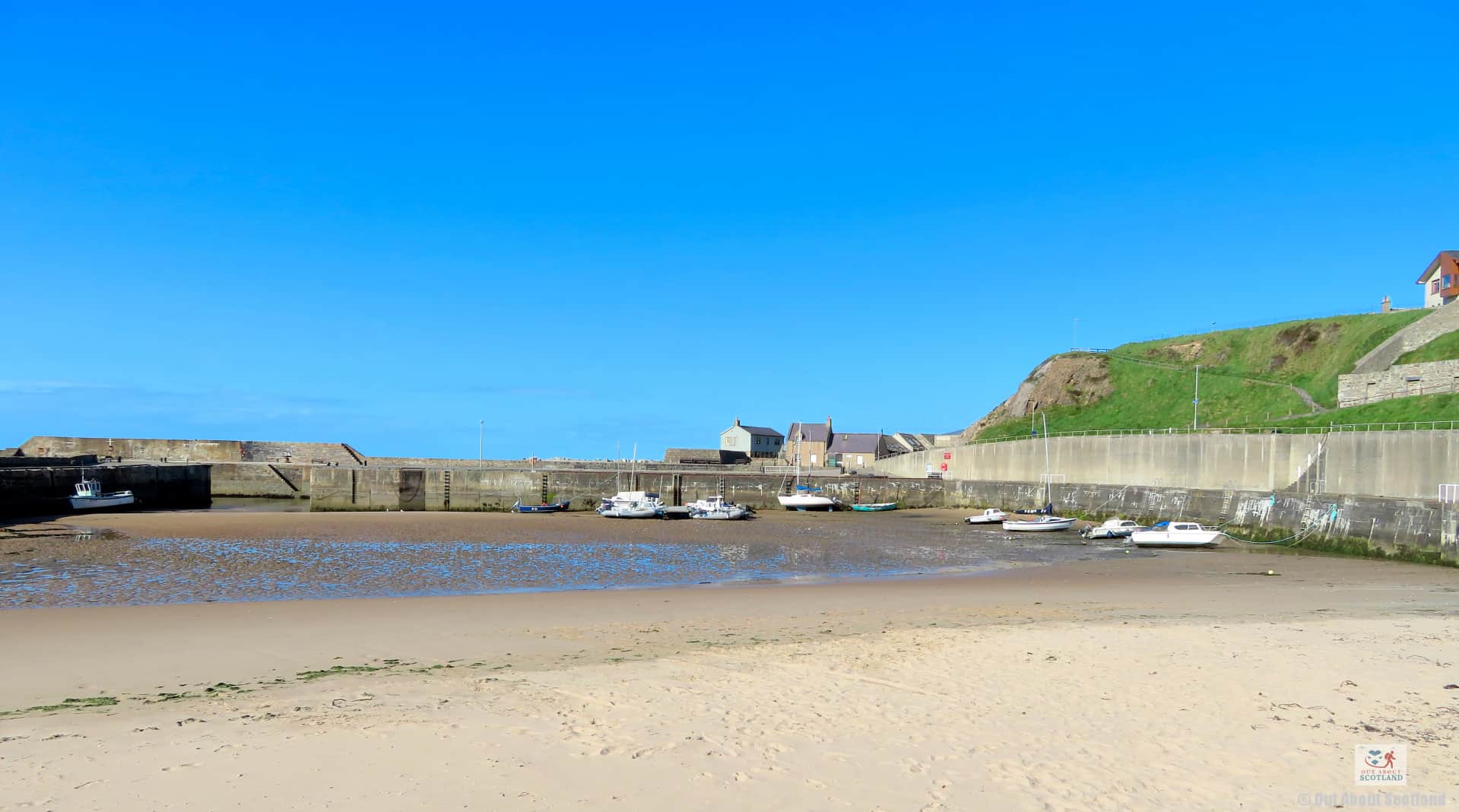
This region lies on the northeastern corner of Scotland between Banff and Nairn. The main benefit here is that there are lots of places to visit if you’re looking for a good family day out ( Portsoy , Cullen and Lossiemouth spring to mind) and it’s not heaving with tourists so you can explore the region in relative peace and quiet no matter the time of year.
Because Moray lies just outside the Highland Boundary Fault the coastal region is quite flat, so you get great views looking towards the North Sea. Coupled with just a light smattering of villages, it’s possible to find lots of areas with superb inky-black night skies.
Other than being so close to Speyside whisky, one of the highlights of Moray is its position close to Ngorms National Park, especially the area surrounding Tomintoul and Glenlivet, which is home to Scotland’s second–and the world’s most northerly dark sky park.
This area is widely regarded as one of the best in the world for stargazing and the Glenlivet Estate , in particular, is a fantastic place, not just for catching sight of the northern lights but also for its forests, mountain biking trails, riverside walks, castles, and distilleries.
The Outer Hebrides
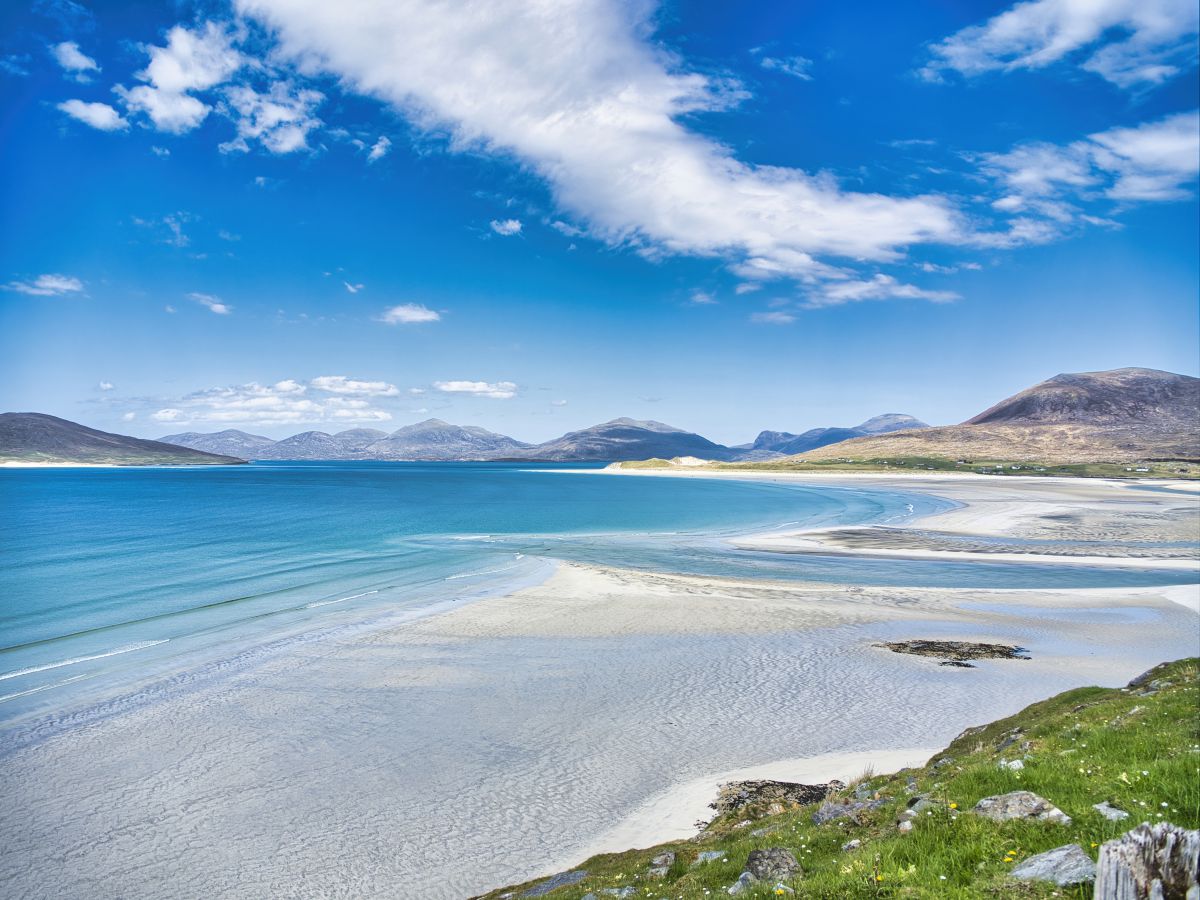
There are over 70 islands in the Outer Hebrides chain off the northwest coast of Scotland, and only 27,000 people live on 15 of them. These islands are some of the most beautiful in Scotland, especially Harris and Lewis, with their white-sand beaches, crystal-clear sea, and unspoiled landscape. As a place for watching the northern lights, Harris and Lewis take my number one spot.
Getting there isn’t particularly difficult either thanks to Stornoway airport which serves flights from Edinburgh and Glasgow, but if you’re heading south to Uist and Barra be aware the only way to get there is by ferry.
Pretty much anywhere in the Outer Hebrides is a great place for watching the northern lights, but the east coast is particularly good as the skyline is completely uninterrupted and there are roads (and ferries) allowing access to the rest of the island chain.
Shetland and Orkney
These two groups of islands lie to the far north of Scotland but they have regular ferry services from the mainland.
Shetland is an interesting enough place, but for me, Orkney pips it to the post as a tourist destination. There are over 5,000 years of history to discover on Orkney, including the ancient stone circles of Brodgar and Stenness as well as the unbelievably well-preserved ancient settlement of Skara Brae .
There’s also the small fact that Orkney can be reached in under an hour by ferry from the mainland (Gills Bay in Caithness to St. Margaret’s Hope on Orkney) as opposed to Shetland which has a 12-hour sail from Aberdeen, making Orkney much easier to hop over to with your car.
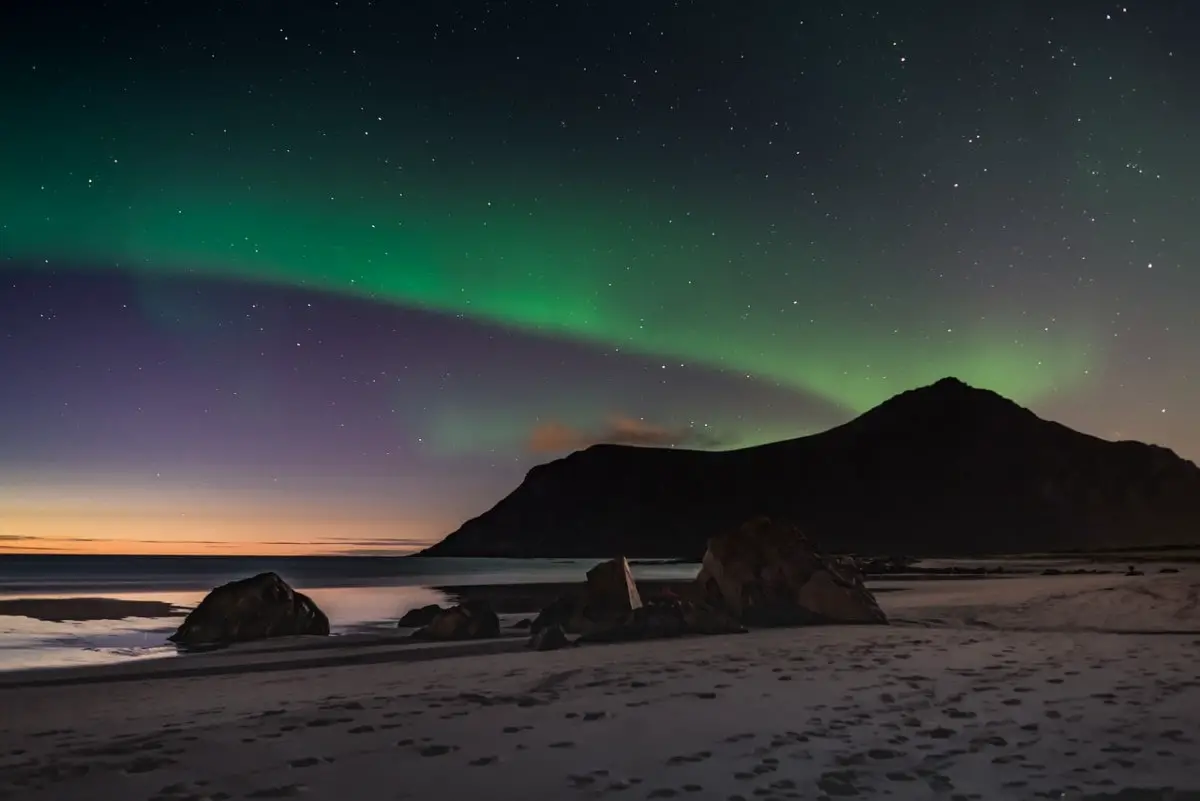
Shetland admittedly does have the largest prehistoric fort in Britain – Mousa Broch – and the islands are a third bigger than Orkney, but both are fantastic places for wildlife spotting and for bird watching they’re two of the best locations in the UK, let alone Scotland.
As far as seeing the northern lights goes, both islands are almost entirely treeless so if you can get to an elevated position you’ll have uninterrupted views in all directions. Plus, due to the fact there are only 22,000 people on each island group there’s very little light pollution.
The Isle of Skye
I have to admit I have a bit of a love/hate relationship going on with Skye . It’s a stunning place to be sure, and natural wonders like The Quiraing and The Storr are jaw-dropping, but this is one island that has sadly become a victim of its own success.
Visit at any time during peak season, i.e., May to September, and you’ll find it’s absolutely jam-packed with tourists, bringing with them all the problems of too many people in a small area.
That means it’s impossible to find accommodation unless you book months in advance, the roads are crammed with coaches, and all the most popular attractions are heaving with crowds. If you want to watch the northern lights in peace, Skye is not the place to go.
That being said, if you time it right and book your trip between autumn and spring you’ll find there are far fewer tourists and you’ll be able to enjoy the stunning landscape in (almost) peace and quiet.
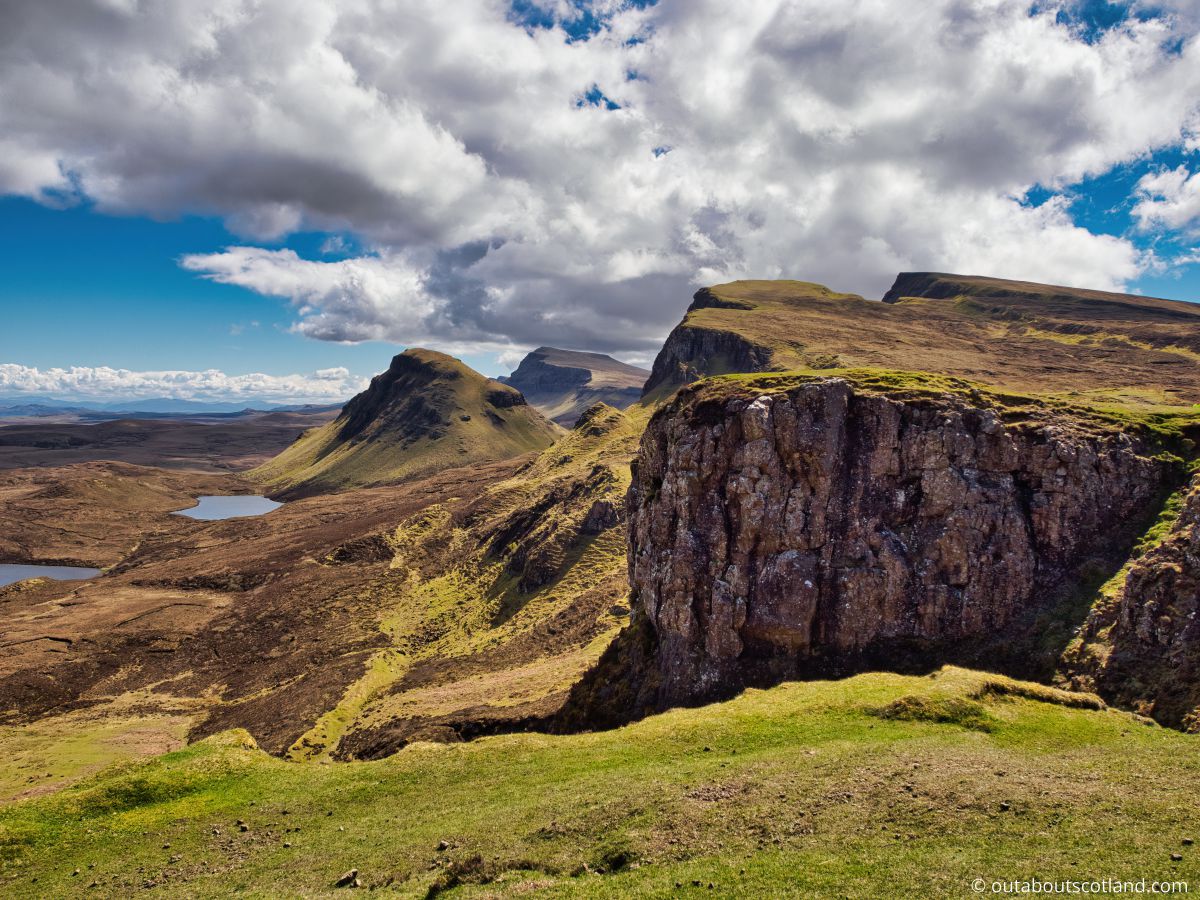
As a bonus, thanks to the Skye bridge at Kyle of Lochalsh, you can save a packet on ferry costs as well.
The northern tip of the island is highly recommended for viewing the northern lights as houses are few and far between, as is the western part of the island at Neist Point. In total, Skye is home to nine Dark Sky Discovery Sites which are places that are far from light pollution, provide good sight lines of the sky, and have good public access.
Remarkably, all nine of Skye’s Dark Sky Discovery Sites are designated as Milky Way Class, which is the darkest rating given whereby it’s possible to see the Milky Way with the naked eye. These sites are: Trumpan car park, Stein Jetty car park, Knockbreck Primary School car park, Kinloch Forest, Kylerhea, Camas na Sgiandin, and Clan Donald steadings.
Cairngorms National Park
The Cairngorms National Park is a breathtakingly beautiful area that covers over 1,748 square miles, making it the largest national park in Britain. It’s situated in the eastern part of the Highlands and is home to a diverse range of mountains, lochs, and wildlife.
As a place to get away from the hustle and bustle of everyday life, the Cairngorms is hard to beat.
Hikers will have an amazing time climbing peaks like Ben Macdui which stands at an impressive 1,309 meters, as well as other notable mountains including Cairn Gorm, Braeriach, and Lochnagar. The park is also home to several beautiful lochs including Loch Morlich , Loch an Eilein, and Loch Garten.
Loch Morlich is particularly popular with visitors because of its sandy beach and crystal-clear water and it’s a great place for swimming, kayaking, and paddleboarding – not something you’d expect to do in the middle of a mountain range!
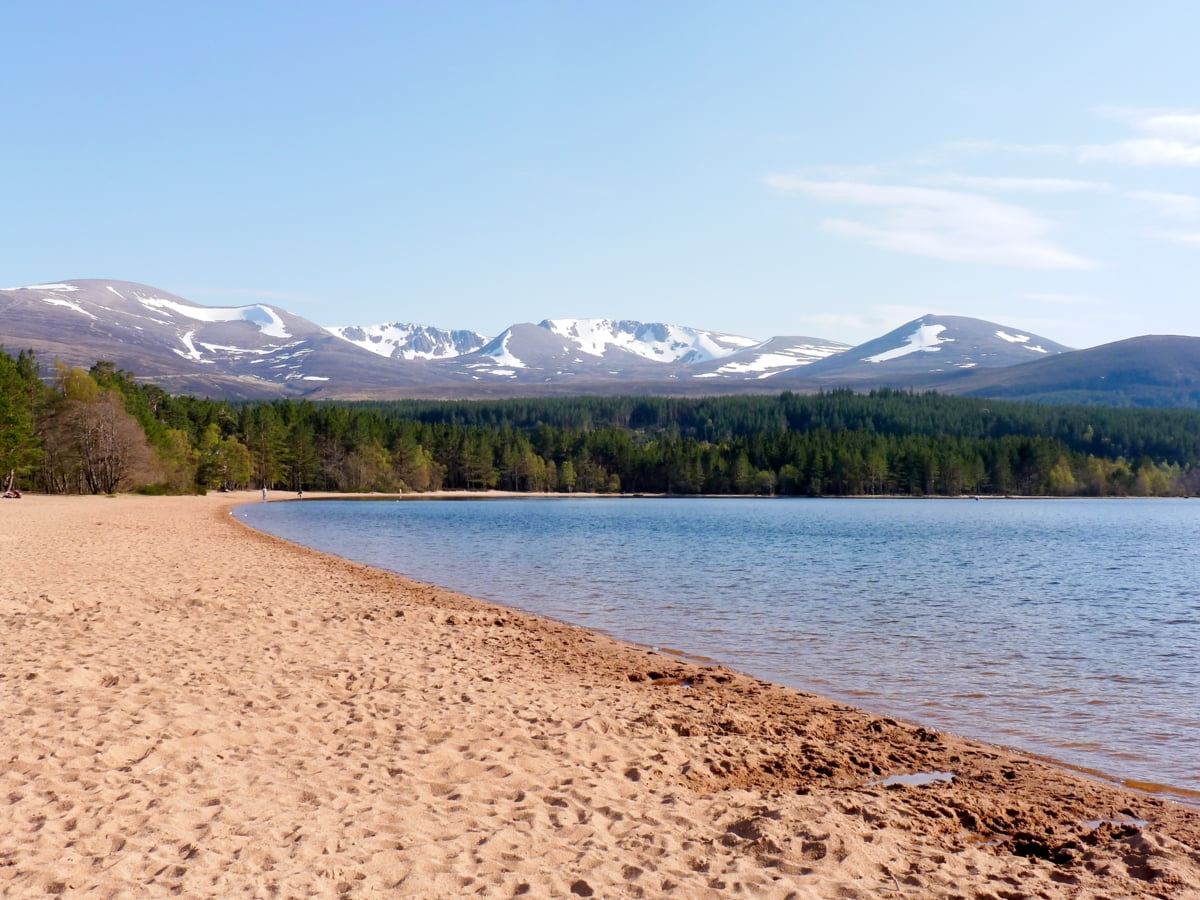
Those visitors that prefer wildlife watching will be in for a treat at the Cairngorms as it’s a stronghold for many of Britain’s rarest animals including the territorial capercaillie, pine martens , and Scottish wildcats. It’s also one of the only places in the country where you can interact with free-roaming reindeer, courtesy of the Cairngorm Reindeer Center in Glenmore Forest Park.
With regards to the Northern Lights, thanks to the thinly-spread human population it’s possible to experience the true inky blackness of space free from light pollution across the entire park, although there are a couple of places that are darker than most.
The Glenlivet Estate (Ballindalloch AB37 9EX) is a great location for watching the Mirrie Dancers, as is anywhere in the Abernethy National Nature Reserve (Nethy Bridge, PH25 3EF). Both of these areas have just a few villages nearby and have plenty of roadside spaces with unobstructed views of the sky.
An alternative location is the Muir of Dinnet National Nature Reserve. This reserve is located on the east side of the Cairngorms, so it’s easier to get to from Aberdeen, and if you walk around to the east side of Loch Kinord, you’ll have only a few hills blocking the view looking north.
Northern Lights Forecast
Monitoring solar activity is a science in itself, and many online resources monitor and compile data to predict the best times to see the aurora borealis. In fact, solar forecasts are now so advanced they can predict with a high degree of accuracy the chances of seeing the lights hour by hour.
Many of these online resources use data compiled by hobbyists so there’s often a minor difference between the forecasts, which is why I recommend taking a look at two or three to get an average prediction before heading out into the cold night air.
The most popular of these forecasts are:
- Aurora Watch UK
There are also apps you can download onto your mobile device that present forecasts about the northern lights in a format that’s easier to understand (i.e. less technical) than most of these websites. Two of the best apps are Aurora Borealis Forecast & Alerts and My Aurora Forecast .
For weather forecasts to avoid those infamously cloudy Scottish skies, you’re spoilt for choice, but my personal recommendation is to check the Met Office website as it’s usually pretty accurate.
What Is a Dark Sky Park?
Light pollution is an increasing concern for the environment for a number of reasons. Little more than 100 years ago you could walk outside at night and see the vast expanse of the Milky Way with its thousands of pinpricks of light, even in a city.
Today, unfortunately, the situation is very different and starlight is almost completely washed out in towns and cities. Even in the countryside, you’ll only see a tiny fraction of the stars in the night sky, and of course, trying to see the northern lights is almost impossible anywhere there are houses.
This constant overpowering man-made light has other negatives too, including its disruption to animals’ ability to navigate and the effects of sleep deprivation in humans due to a reduction in melatonin. Thankfully, environmental campaigners are fighting back, and there are now areas of the world that are protected from excess light pollution, two of which are the Cairngorms and Galloway Forest Park.
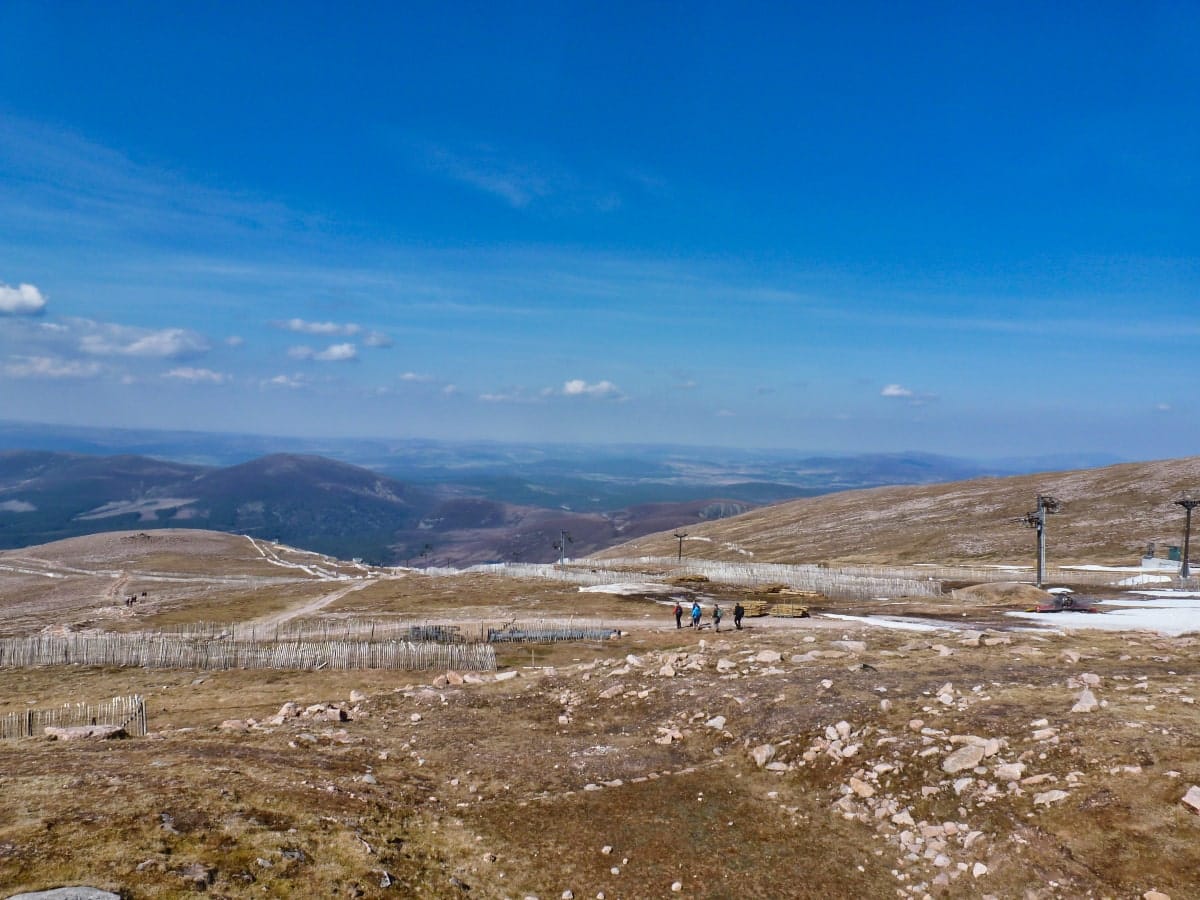
These two regions are designated as dark sky parks which means they have exceptionally dark skies thanks to the careful management of man-made lights.
Galloway Forest Park was the first place in the UK and the fourth in the world to be given this accolade as there are hardly any people that live in the 300 square miles of the forest. That means the sky is almost pure black when the sun retreats and over 7,000 stars and planets become visible to the naked eye.
If you’ve never seen the night sky when there’s no light pollution you’re in for a real treat if you visit one of Scotland’s dark sky parks. The number of stars you’ll see is nothing short of breathtaking and they’re the perfect place for stargazing and watching the aurora borealis come alive.
If you’d like to find out more about dark sky parks, head on over to the International Dark Sky Association website where you’ll find lots of information about the impact of light pollution on our planet as well as the work that’s being done to combat it.
Tips and advice for watching the Northern Lights
1. know the solar cycles.
The key to viewing the northern lights is knowing that the sun goes through different phases of activity, each of which is called a solar cycle. These cycles last, on average, 11 years, and they have stages that range from very quiet to very active. Quiet stages are referred to as solar minimum, and active stages are referred to as solar maximum.
As you’ve probably already guessed from the name, your best chance of seeing the northern lights is when the sun is at its solar maximum stage, as that’s the time when the most charged particles are flung out into space towards the earth.
It’s obviously good to know when these cycles occur but it basically boils down to the fact that the last cycle ended in 2019 and the current solar cycle will continue ramping up until it reaches solar maximum in July 2025.
After that, the sun will slow its activity levels again until the solar minimum is reached in 2030. While you might see the aurora in Scotland in the years surrounding the solar minimum, you’ll have the best opportunities in the years on either side of the solar maximum.
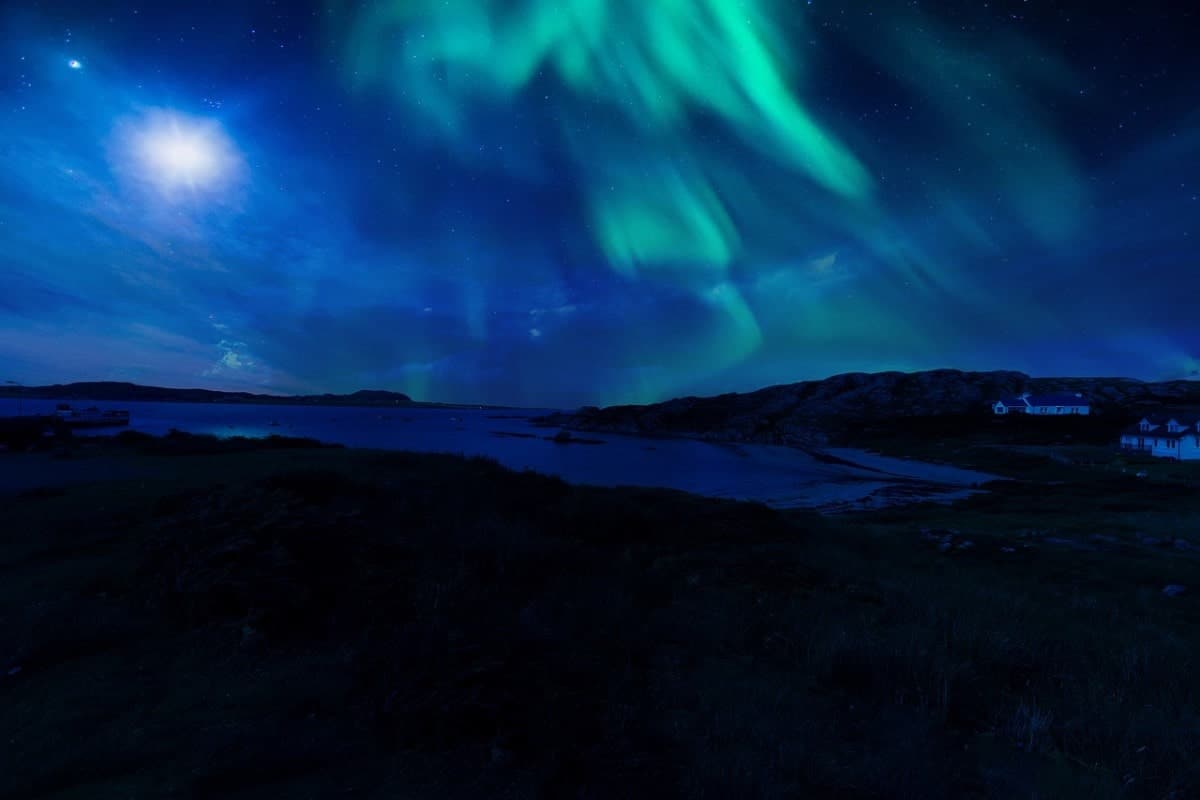
2. Understand the KP Index
If you look at any website dedicated to the aurora borealis or solar activity in general, there will almost certainly be a reading that indicates the likelihood of seeing the phenomena. This reading is called the KP index, and understanding it is essential to make the most of the many websites dedicated to the northern lights.
As mentioned earlier, the further north you go the more likely you are to see the northern lights because the charged particles thrown our way by the sun are concentrated at the poles.
The index ranges from 0 to 10 and it describes how strong the sun’s activity is. So if, for example, the KP index was 0 (the lowest level of activity) you would need to be close to the North Pole to see any lights. As the sun’s activity increases the KP index rises, with each increase in level indicating an extra 350 km in latitude south from the North Pole where you can see the northern lights.
Bear in mind the KP index rating of a location doesn’t change, and here in Scotland we have a rating of KP 5 for the northern mainland out to the Shetland Isles, and a KP rating of 6 for the tip of the northernmost mainland down to the Scottish Borders. So in a nutshell, the next time you check a solar activity forecast and you notice there’s a KP index of 5 or 6, there’s a good chance you’ll be able to see the northern lights in Scotland.
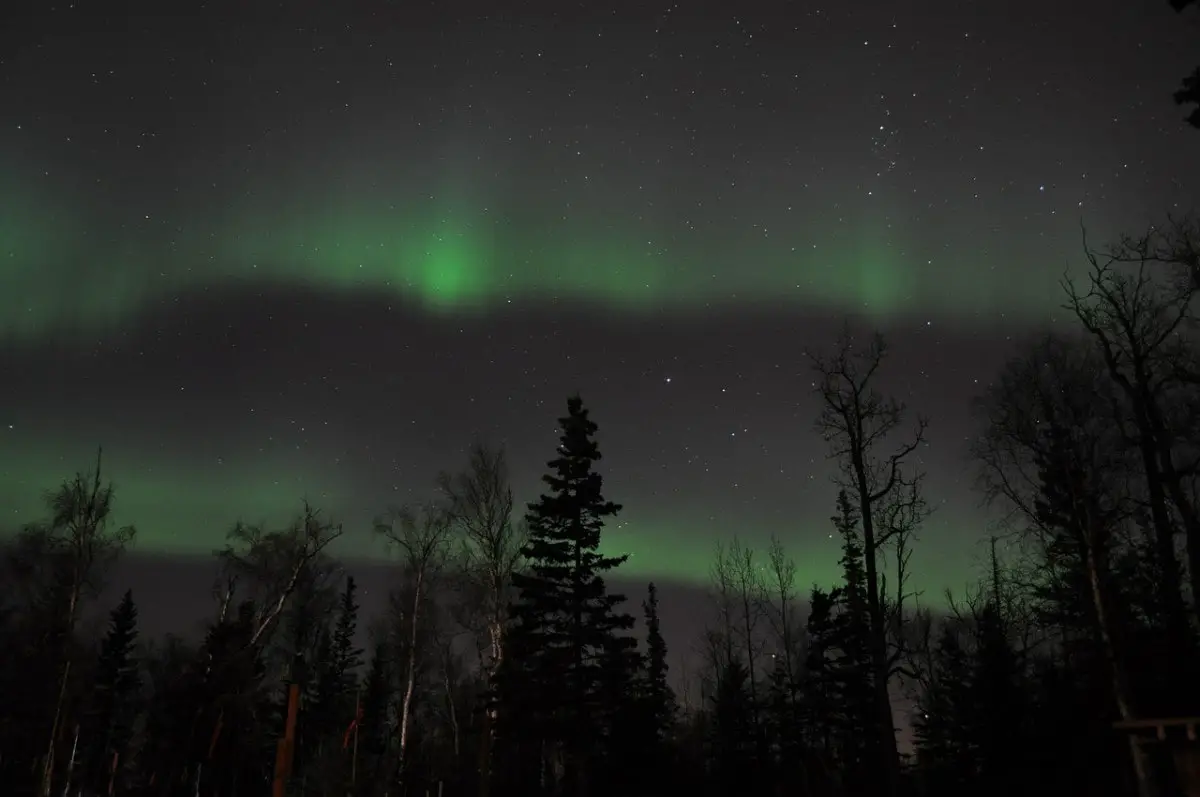
3. Maintain Your Night Vision
When the sun’s activity is strong, the aurora appears as bright, dancing ribbons of colour that fill the sky. In reality, however, for the most part, the lights are quite faint and get fainter the further south you go. That’s the reason I mentioned dark sky parks earlier in this article, as even the slightest amount of light pollution can completely ruin your chances of seeing the lights when the KP index is low.
One of the biggest advantages you can give yourself, other than finding a viewing spot as far north as possible and as far away from towns and cities as possible, is to make sure you don’t lose your night vision. It can take up to an hour for your eyes to fully adjust to the dark, but they will lose the adaptation within a couple of minutes of being exposed to bright lights, so there are a couple of points to keep in mind when you’re aurora-hunting.
First off, do not look at your phone screen unless you absolutely have to, and even then only if you’ve set the brightness down to a bare minimum. Even the lowest setting can be too bright for your eyes once they’ve adjusted, but there are light-dimming sheets (Amazon link) that you can place over the screen to cut down on all that annoying screen glare.
Likewise with torches, they’ll ruin your night vision within a few minutes of use, so I recommend not switching them on unless you absolutely have to.
That being said, premium torches come equipped with red filters that don’t affect your eyes, so if you’re serious about seeing the northern lights and you’re heading out into the middle of nowhere, you’ll find a red light torch (Amazon link) an invaluable tool.
How to Photograph the Northern Lights
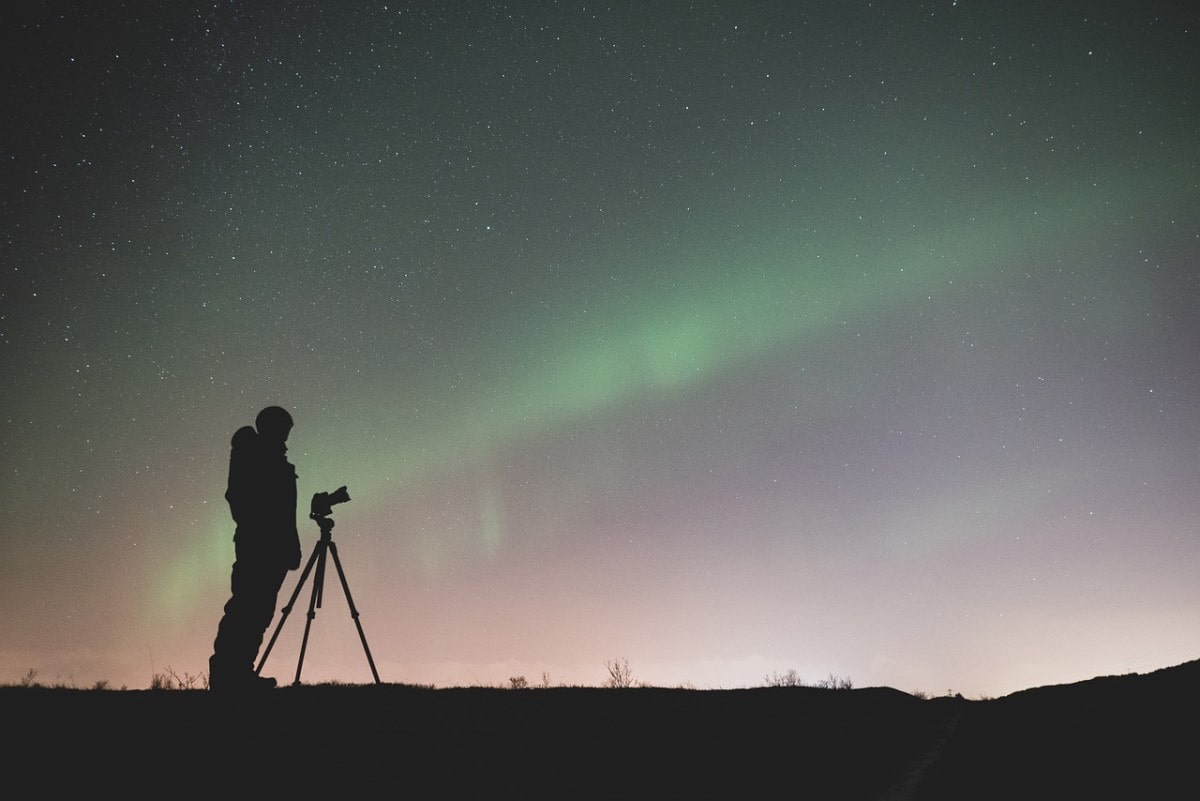
It’s all very well to go to the trouble of roaming the wilds of Scotland in order to see the aurora, but wouldn’t it be nice to take a few photos of the experience as well? You may well think it’s an impossible task for a novice photographer, but if you’ve got a little know-how under your belt, you’ll be able to take Instagram-worthy shots that will amaze your friends and family.
But before you whip your camera out, you need to be aware of a few things. First, it’s going to be nighttime (well, obviously…), and that means it’s going to be cold, so you’ll need to make sure you’re wearing warm clothes which include gloves, preferably fingerless so you can operate your camera.
Second, you should forget about trying to capture the aurora with your phone because the tiny sensor will struggle with long exposures and the noise will almost certainly ruin the shot. While top-end phone cameras are getting better year by year, they still can’t compete with even a cheap mirrorless camera.
Although you’ll get the best images with a full-frame sensor, I use a Micro Four Thirds (MFT) camera and still manage to take decent photos. Note that all the following camera specs are based on MFT so you’ll need to double the numbers for full-frame gear.
As far as the lens goes I use a 10 mm F2 from Laowa (20 mm F4 full-frame equivalent) but if you have an even faster lens then all the better. Photographing the night sky is all about getting as much light into the sensor as possible so I recommend using at least an F2.8 aperture.
If you don’t want to spend £300+ on a premium lens I can confirm the 7artisans 7.5 mm F2.8 (Amazon link) also does a good job.
You’ll notice both these lenses are very wide-angle, and there’s a good reason for that. For astrophotography, there’s a rule about how long you can keep the shutter open before the rotation of the earth makes the stars blur, which is:
500 / lens focal length = Exposure time.
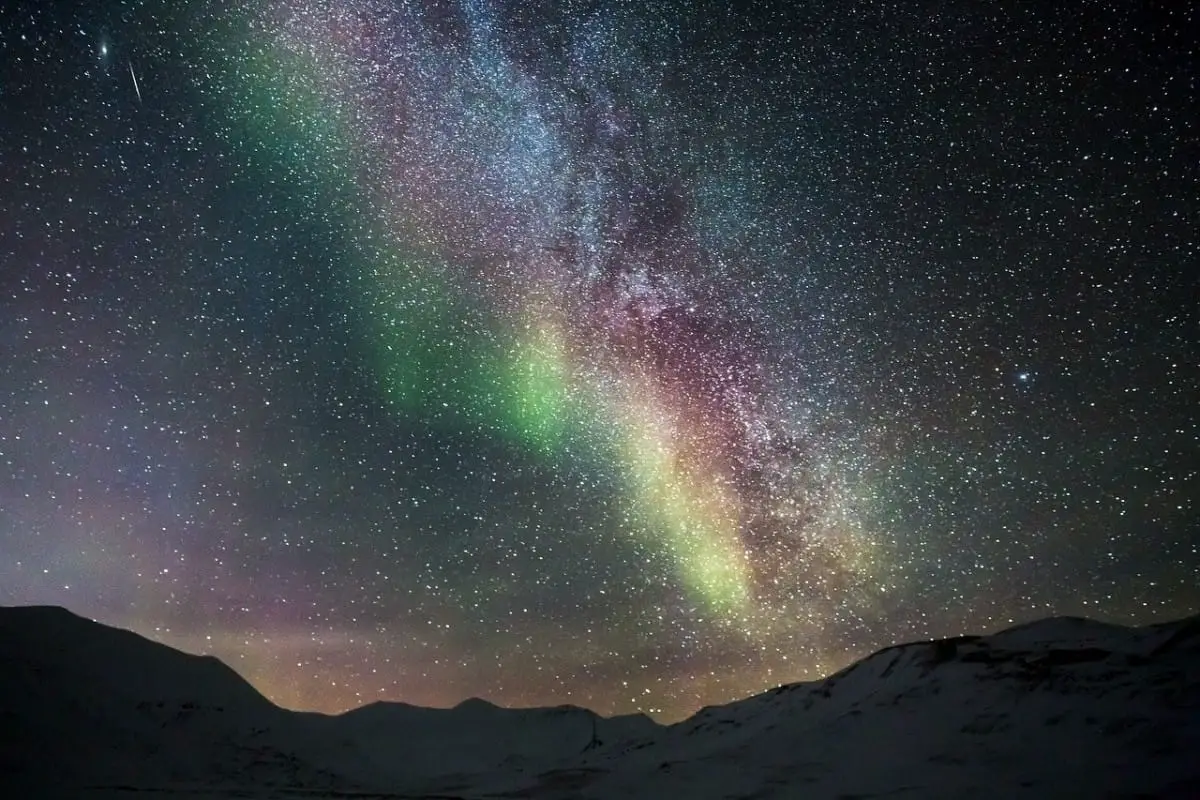
This is for full-frame, so if you have an MFT camera you’ll have to double the focal length. A quick bit of math with my Laowa 10 mm lens gives us 500 / 20 = a maximum of 25 seconds, whereas a 25 mm MFT lens (50 mm FF equivalent) would only allow a maximum 10-second exposure, i.e., 500 / 50 = 10.
A long exposure is great for stars, but the aurora is constantly moving, so you need to balance the two. As a rule of thumb, anything from 2 to 10 seconds should be enough to pick up lots of detail in both the aurora and the stars.
The last thing to consider for the lens is to open it up to its maximum aperture to allow the most light in and set the focus to infinity so that everything will be in focus, from the foreground to the background.
To set up your camera, attach it to a tripod and adjust the angle till you find a scene you like the look of. The old two-thirds composition rule works great for shots of the night sky so try to fill the upper 2/3 of the frame with the sky and the lower 1/3 with the ground.
Next, level the left/right tilt of your camera using the on-screen inclinometer or a bubble level. You can buy bubble levels from Amazon for a few quid, but you’ll need a torch to see them in the dark, which is why I prefer to use the camera’s built-in indicator.
Set your camera’s ISO to a setting that’s as high as possible without creating a noisy mess. You’ll probably want to do a bit of research online for your specific camera, but for my Olympus EM1 I tend to use ISO 1600. You should also set your camera to capture RAW, as you’ll have much more flexibility in editing compared to shooting JPEGs.
Finally, set your camera to fire on a timer which will help reduce the vibration when you press the shutter button. A 5-second delay should do the job nicely.
Note that these recommendations are really just guidance to use as a starting point for your nighttime photos, and for your first few shots, you might like to play around with the ISO and shutter speed till you work out what works best for your set-up.

Frequently Asked Questions
What is the best time of day to see the northern lights in scotland.
Being a natural phenomenon the northern lights appear randomly in Scotland, but you’re more likely to see them when the sky is darkest. Due to its high latitude, Scotland has short nights in summer and in places like the Shetland Isles it barely gets dark at all.
The following times of day in Central Scotland are an indication for when it’s dark enough to see the northern lights.
September Sun rises 5.22am Sun sets 7.11pm October Sun rises 6.20am Sun sets 5.52pm November Sun rises 7.23am Sun sets 4.37pm December Sun rises 8.23am Sun sets 3.49pm January Sun rises 8.47am Sun sets 3.53pm February Sun rises 08.11am Sun sets 4:51pm March Sun rises 7.08am Sun sets 5.51pm
Can you see the northern lights in Edinburgh and Glasgow?
It’s very unlikely to see the northern lights in Edinburgh or Glasgow, although that isn’t to say it never happens. If the aurora is particularly strong, it can be seen over the capital city when there is little moonlight, but only in those elevated areas that are away from street lights.
The best locations for seeing the northern lights in Edinburgh are Calton Hill, Blackford Hill, and Holyrood Park.
The northern lights are very rarely reported in Glasgow but they might be visible away from the city centre in places like Pollock Country Park
What time of year is best to see the northern lights in Scotland?
Solar activity can create the aurora borealis at any time of the year, but your ability to see it is dependent on how dark the sky is. Therefore, in Scotland, it’s best to view the lights in autumn and winter (from September to March) when the nights are longest and the skies are darkest.
Can you see the northern lights with the naked eye?
You can see the northern lights with your naked eyes, but only in conditions where there is very little ambient light and virtually no light pollution. It is almost impossible to see the northern lights during the day as sunlight will completely wash out the colours of the aurora.
Related Posts
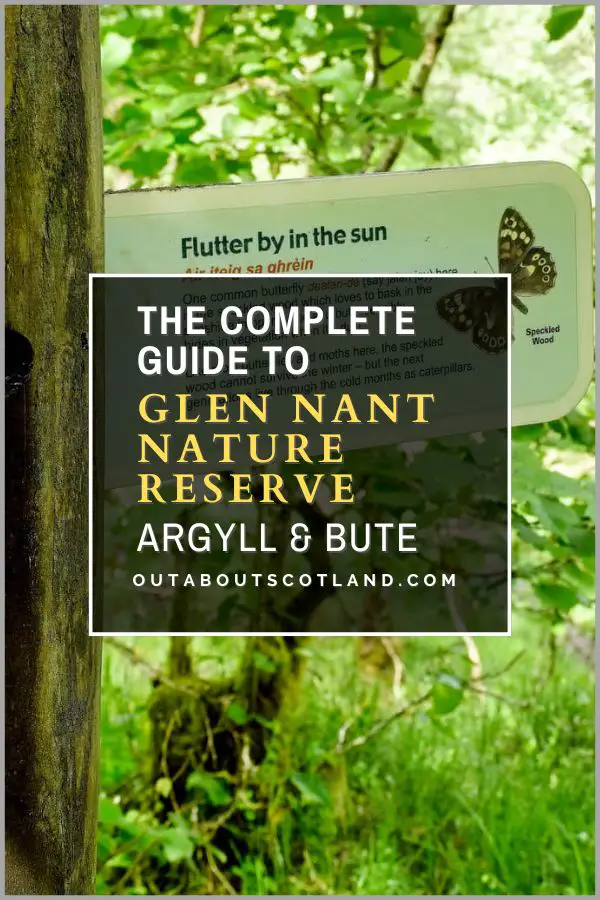
Glen Nant Visitor Guide
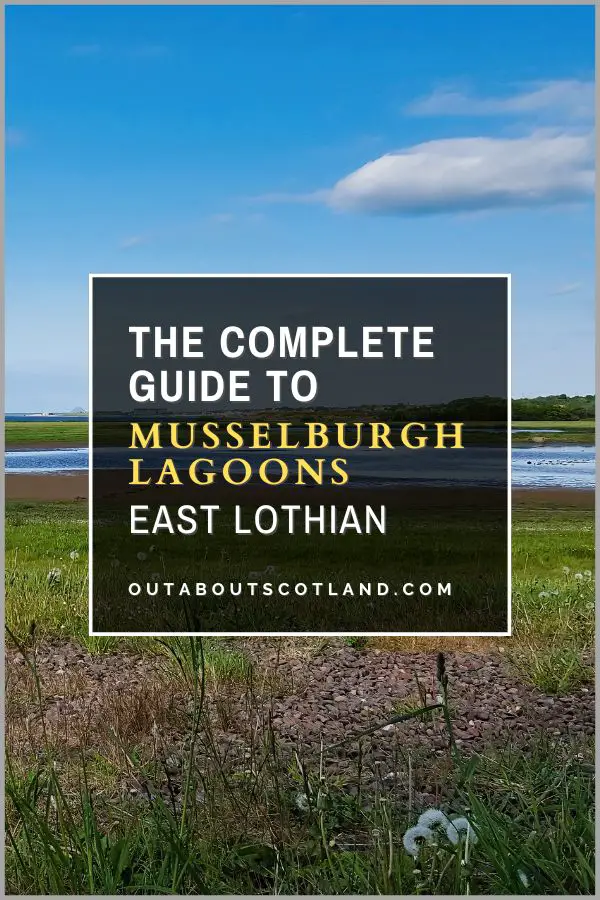
Musselburgh Lagoons Visitor Guide
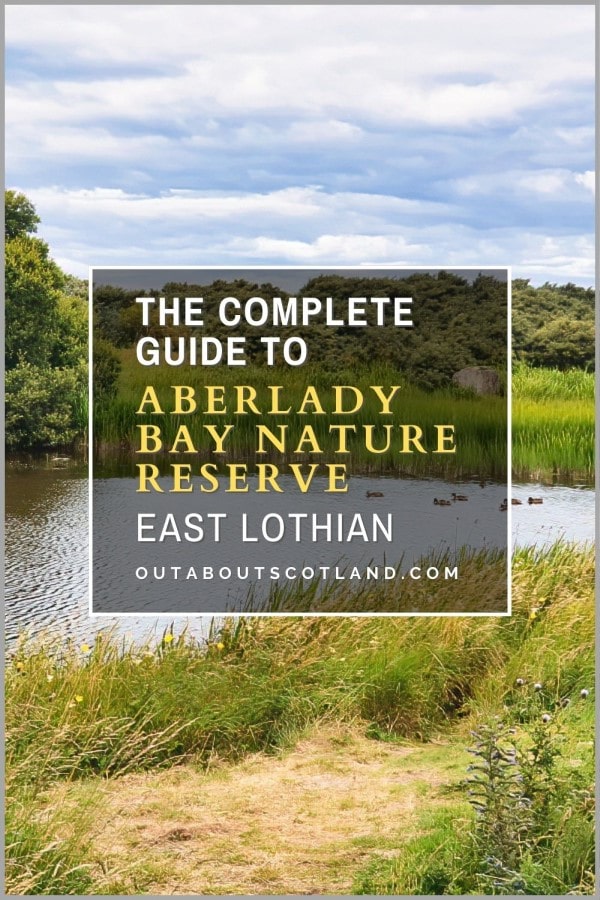
Aberlady Bay Visitor Guide
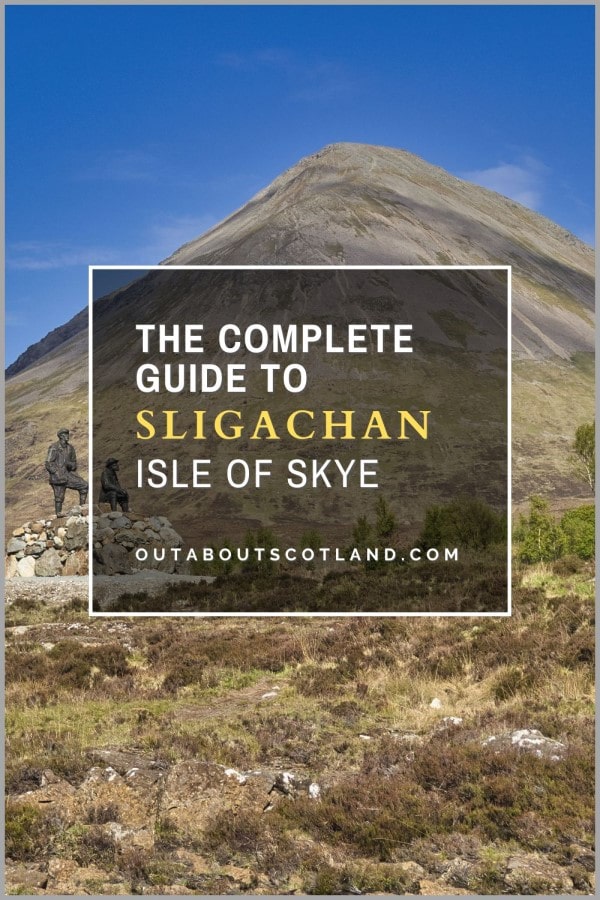
Sligachan Visitor Guide
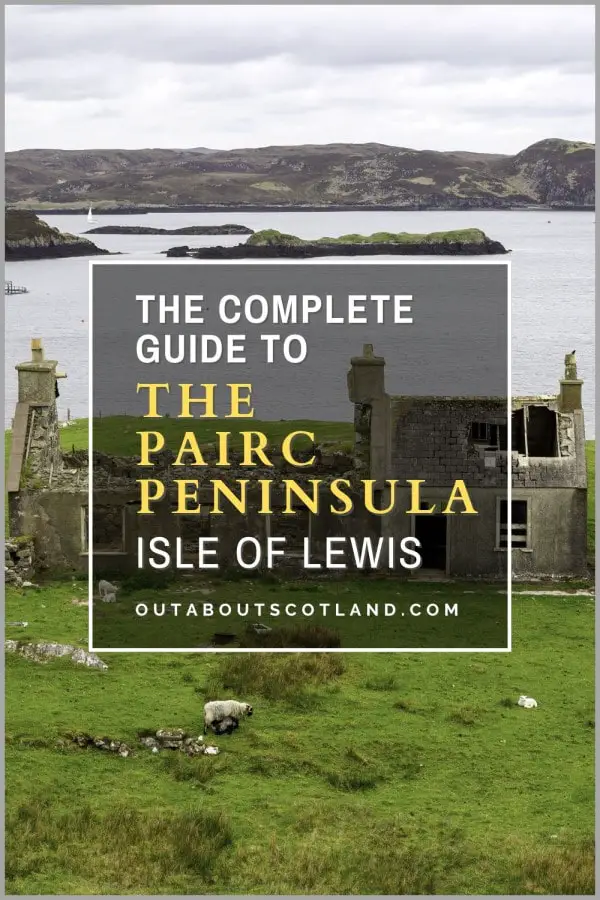
Pairc Peninsula Visitor Guide
Craig Neil is the author, photographer, admin, and pretty much everything else behind Out About Scotland. He lives near Edinburgh and spends his free time exploring Scotland and writing about his experiences. Follow him on Pinterest , Facebook , and YouTube .

Northern Lights in Scotland: Tips & 13 Places to See Them
- Northern Lights in Scotland: Tips & 13 Places to...
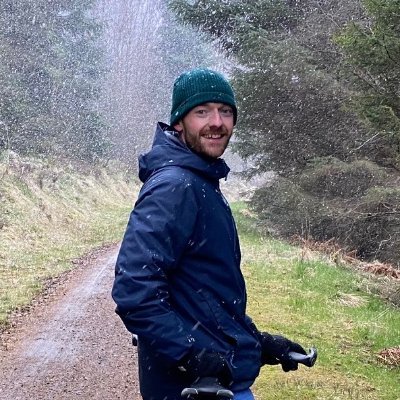
In this illuminating article, we’ve brought you everything you need to know about seeing the northern lights in Scotland.
We’ve covered when to go, how to see them, and Scotland’s 13 best spots for experiencing nature’s most famous light show.
The northern lights are often visible in the nation. They are also known as the ‘Mirrie Dancers’ (which means ‘merry dancers’) in Scotland. But to stand a chance of spotting them, you need to know when and where to go.
So pack some sandwiches, bring some binoculars, and get prepped to stay up late. Tonight, Budget Travel Plans are taking you to see the northern lights!
Table of Contents
Can You See the Northern Lights from Scotland?
In short, yes.
But before you get all excited, here’s a bit of a reality check: in Scotland, you’ll need to be pretty lucky to see them. For that reason, don’t book a trip to Scotland if your sole goal is spotting the northern lights. But if you want to combine an outside chance of seeing the northern lights with lots of hiking, exploring and adventuring in a lovely place, then Scotland is perfect.
If spotting the northern lights is your primary Euro-trip goal, I recommend heading to Norway, Sweden, Finland, or Iceland.
When Is the Best Time to See the Northern Lights in Scotland?
Usually, the best months are the darkest months. In Scotland, that’s November, December and January, but October and February can be pretty good too.
The northern lights, of course, are best seen in the middle of the night. Though they can appear at any time, they’re usually at their best and brightest some time between 10 pm and 2 am. So brew up a big batch of coffee, and settle in for a late night.
Where Is the Best Place to See the Northern Lights in Scotland?
Broadly speaking, you want to get as far north as you possibly can. The closer you are to the North Pole, the better chance you have of seeing the northern lights.
But no matter which area of Scotland you visit, you should always venture to the most remote, unpopulated parts of that area. Less light pollution means darker skies, which means you have a much better chance of seeing the northern lights.
For example, if you’re on the Isle of Skye (where there’s a good chance you might see the northern lights, but more on that later), don’t expect to see them in the centre of Portree.
To find the darkest skies in Scotland, seek out the nation’s so-called Dark Sky Discovery Sites (which are large areas with no light pollution). Here’s an excellent map of them all.
Another of my favourite resources for spotting the northern lights is AuroraWatchUK , which has a helpful list of all the best times to see the northern lights in Scotland (and other parts of the United Kingdom). There’s even a specific section for Shetland, the absolute best place in Scotland for seeing the northern lights (but we’ll get to all that soon).
Quick tips to see the northern lights in Scotland:
- Arrive early, an hour or two before you expect to see the northern lights. If you give your eyes lots of time to adjust to the dark, you’ll be able to enjoy and experience the northern lights much more.
- Get some long exposure shots on your camera to let in more light. Don’t be surprised if your photographs make it look better than the real thing, you sneaky little trickster.
- Avoid times when there’s a full moon. More light from the moon means a brighter sky, which means less chance for the northern lights to stand out.
Alright, now that we have all of that stuff out the way, here we go, the 13 best places to see the northern lights in Scotland . We’ve covered islands, mainland spots, southern surprises, and plenty more.
The Shetland Islands

Because they’re the most northern part of the UK (and therefore closer to the North Pole than any other part of the region), the Shetland Islands are pretty much always going to be the #1 choice if you want to see the northern lights in Scotland.
Yeah, it’s a remote place, but if you’re serious about spotting the Mirrie Dancers, it’s where you want to be.
The Shetland Islands are a big set of islands off the eastern part of Scotland’s northern coast. They’re around 130 miles (210km) from the mainland, so they’re pretty far north.
The best places for spotting the northern lights are the remote areas in and around North Roe, Haroldswick, and the strangely-named Gloup. But in truth, any quiet, unlit area on Shetland is a much better bet than any other part of Scotland.
The Orkney Islands
The Orkney Islands are plonked between the Shetland Islands and the Scottish mainland, making them the second-best place to see the northern lights in Scotland.
The best places to see the northern lights on Orkney are the remote spots in and around Hollandstoun, the Brough of Birsay, Start Point Lighthouse, the Broch of Gurness, Inganess Bay, and Wideford Hill.
Or for something massively unusual, wander over to the Ring of Brodgar, a bizarre stone circle surrounded by remote lochs. If you see the northern lights here, it’ll be one of the strangest (and probably best) experiences of your life.
The Trotternish Peninsula
The Trotternish peninsula is the northern ‘finger’ of the incredible Isle of Skye —so the most northern parts of this peninsula are the most northern parts of the entire island.
Anywhere on the Trotternish peninsula is a good option, but Shulista Croft Wigwams (basic but welcoming glamping lodges right on the island’s northern tip) are our top pick. Even if you don’t see the northern lights here, it’s a lovely place to be—it’s one of our favourite places to stay on the whole of Skye .
The northwest of the island is also a pretty choice. Find a quiet, dark spot close to Dunvegan, and you’re in with a good chance of seeing the northern lights.
Lewis and Harris

Part of the Outer Hebrides archipelago, oddly-named Lewis and Harris is the most oversized island in Scotland and sits north of the much-more-popular Isle of Skye.
There are many popular spots for seeing the northern lights along the northwestern coast of Lewis and Harris, between Barvas and Port of Ness. Go anywhere between those two places, and you’ve made a good choice.
Tiumpan Head and Bosta Beach are also good options. But for a genuinely surreal experience, head to the Callanish Standing Stones, a bizarre Neolithic ritual site that predates Stonehenge. Seeing the northern lights here is incredible.
Close to Lewis and Harris, you could also try looking for the northern lights on both Uist and Barra, two other parts of the sprawling Outer Hebrides.
The Isle of Coll
You probably haven’t heard of this place.
West of the Isle of Mull and south of all the other islands we’ve featured so far, the Isle of Coll is a tiny little place, but it’s fantastic for stargazing and northern-lights-spotting.
The folks who live on this island have repeatedly rejected the Scottish government’s offers of artificial street lighting. This means deep nights of sleep, cozy nights, and massive chances of seeing the northern lights. The entire island has an official dark sky status —and because only around 200 people live there, it’s tranquil, peaceful and alluring.
Even if you don’t see the northern lights on the Isle of Coll, you’ll still fall in love with the place.
Caithness
Alright, we’re finally moving away from all the islands and onto the Scottish mainland.
Caithness is the northeastern region of mainland Scotland, making it one of your best options if you can’t be bothered to trek to one of the islands.
The best places to see the northern lights in Caithness include Noss Head, Duncansby Head, and Dunnet Head. All three are cliffy locations with unlit lighthouses.

Bordering Caithness, and stretching to the most northwestern parts of mainland Scotland, you have Sutherland, an immense region with many barren stretches.
Lochinver, Gairloch, Ullapool, Durness and Tarbet are all great places to base yourself if you want to see the northern lights in Sutherland. Stay in any of them, and wander to any remote, unlit spot, and you’re in with a good chance.
Rannoch Moor
Situated in the central part of western Scotland, vaguely between Fort William and Oban, Rannoch Moor is popular for hiking, animal spotting and birdwatching.
And because it’s so vast and dark (known as one of the last-remaining genuine wildernesses in Europe ), it’s also a great place to see the northern lights.
It’s not as far north as most other places we’ve featured on this list. But because it’s so flat, you get great views of the sky no matter which part you visit. Find yourself a spot you like, plop yourself down, and hope for the best—you have your choice of around 50 square miles (130 square kilometres).
Galloway Forest Park
Alright, this place isn’t very far north, sitting around 140 miles (225km) south of the most southern stretches of Rannoch Moor.
But because it was the first officially-designated Dark Sky Park in Scotland (and the fourth in the entire world!), the stars look much brighter here than in most other places on the planet. And that makes it an excellent choice for possibly seeing the northern lights.
People flock here to star-spot from all over the globe.
Even if you don’t see the northern lights, you’ll probably see more stars than you’ve ever seen, a decent consolation to appease your potential disappointment.
If you’re keen to stay in the south of the nation, and you don’t want to venture very far north, it’s the best place to see the northern lights in Scotland.
Cairngorms National Park
Cairngorms National Park is another region with an officially-designated Dark Sky Park.
Northeast of Galloway Forest Park, between Perth and Inverness, you have the Cairngorms.
The Cairngorms is the most prominent national park in the UK, with many dark sky areas. But the official dark sky area is known as the Tomintoul and Glenlivet International Dark Sky Park , and measures in at a hefty 88 square miles (230 square kilometres).
Any part of that dark sky region is an excellent place to see the northern lights.
The Fife Coast
Okay, let’s move away from the hills and mountains and towards the seaside.
One of Scotland’s most underrated coastal regions, the Fife coast runs in a big half-circle from just north of Edinburgh to south of Perth. It’s a good choice if you don’t want to head up to the Highlands in your pursuit of seeing the northern lights in Scotland.
To see the northern lights on the Fife coast , go to any of the remote bays and beaches between Crail and St Andrews. The tiny peninsula of Out Head, just north of St Andrews, is my personal favourite.
The Aberdeenshire Coast
The Aberdeenshire coast runs from Findhorn to the south of Aberdeen, along the most eastern part of mainland Scotland.
Some of the best places to see the northern lights along the Aberdeenshire coast include Balmedie Beach, Aberdour Beach, Spey Bay, and the beach between Findhorn and Burghead (part of excellent Roseisle Country Park).
Calton Hill and Arthur’s Seat (in Central Edinburgh)
Our last entry on this list is also our most leftfield one.
Let’s be honest. There’s very little chance of seeing the northern lights in Edinburgh. But if you’re in the capital city, and you can’t (or don’t want to) visit any other part of Scotland, these two city-centre hills are your best bet.
If the northern lights are super bright, and the sky is super clear, there’s an outside chance you might see them from the top of both Calton Hill and Arthur’s Seat.
Final Thoughts and Further Reading
There you go, you little star-spotters—everything you need to know about the northern lights in Scotland and the 13 best places to see them.
If you want to know anything else about venturing around Scotland, check out our articles:
- Fairy Pools on the Isle of Skye
- Where to Stay in Skye
- How to get to Skye
- 5-day Isle of Skye Itinerary
- 12 things to do in Skye
- Best time to visit the Isle of Skye
- 16 best campsites on the Isle of Skye
- Exploring Skye’s Fairy Glen
- 19 Pubs on the Isle of Skye
- 23 Restaurants on the Isle of Skye
- 9 Beaches on the Isle of Skye
- Coral Beach on Skye
Thanks for reading, and we’ll see you next time!
???? Ready to Jet-Set on a Budget? ✈️ Maximize your savings with these travel essentials: ✈️ Sky-high Savings: Book budget-friendly flights with Skyscanner . ???? Rest Easy: Find the perfect accommodation on Booking.com or Hostelworld . ???? Travel Light: Store your luggage securely with Bounce . ???? Stay Connected: Grab affordable eSIMs from Airalo or SimOptions . ???? Unforgettable Adventures: Find tours and experiences with GetYourGuide . ????️ Travel Worry-Free: Stay protected with travel insurance from SafetyWing !

Leave a Comment Cancel reply
Save my name, email, and website in this browser for the next time I comment.

Paul McDougal is a handsome and hilarious travel writer originally from the UK. He likes hitchhiking, working remotely, and having absolutely no idea what’s going on.
Related Articles

12 Things to do in Fife, Scotland

Ilha Grande Hiking: Pico do Papagaio

Best Time to Visit Uzbekistan

Featured Articles
Best of canada, best of england, best of new zealand.

- Adventure Activities
Northern Lights in Scotland | 9 Best Places to See the Aurora Lights
- 6 minute read
- July 12, 2023

Prepare to be amazed, adventurers ! Get ready for a once-in-a-lifetime experience as we take you on a thrilling journey to witness the mesmerizing Northern Lights in Scotland. Imagine a sky painted with enchanting colors, as if a magical artist decided to put on a show just for you!
In Scotland, you’ll find not just one, but nine incredible places where the Aurora Lights shine their brightest. It’s like discovering a hidden treasure map leading you to the most breathtaking views of this natural wonder. From mystical islands to majestic national parks, each location offers its own unique spectacle, guaranteed to leave you in awe.
So, grab your binoculars and join us as we uncover the secrets of the Northern Lights in Scotland’s nine best places. Get ready for a journey filled with wonder, beauty, and unforgettable memories.
About Northern Lights in Scotland
The Northern Lights are a dazzling light display that occurs when charged particles from the Sun interact with the Earth’s atmosphere. These charged particles, predominantly electrons, and protons, are driven toward the Earth’s magnetic poles by the planet’s magnetic field.
As the particles collide with atmospheric gases, energy is released in the form of shimmering lights, painting the night sky with magnificent colors. The most common color is green, caused by the interaction with oxygen molecules, but hues of red, yellow, blue, and purple can also appear.
What is the Best Time to See the Northern Lights in Scotland?
The best time to see the Northern Lights in Scotland is during the winter months, from October to March. This period offers longer and darker nights, which provide optimal conditions for spotting the Aurora Borealis. The extended darkness allows the faint lights of the Northern Lights to become more visible against the night sky.
Top 9 Places Where to See the Northern Lights in Scotland
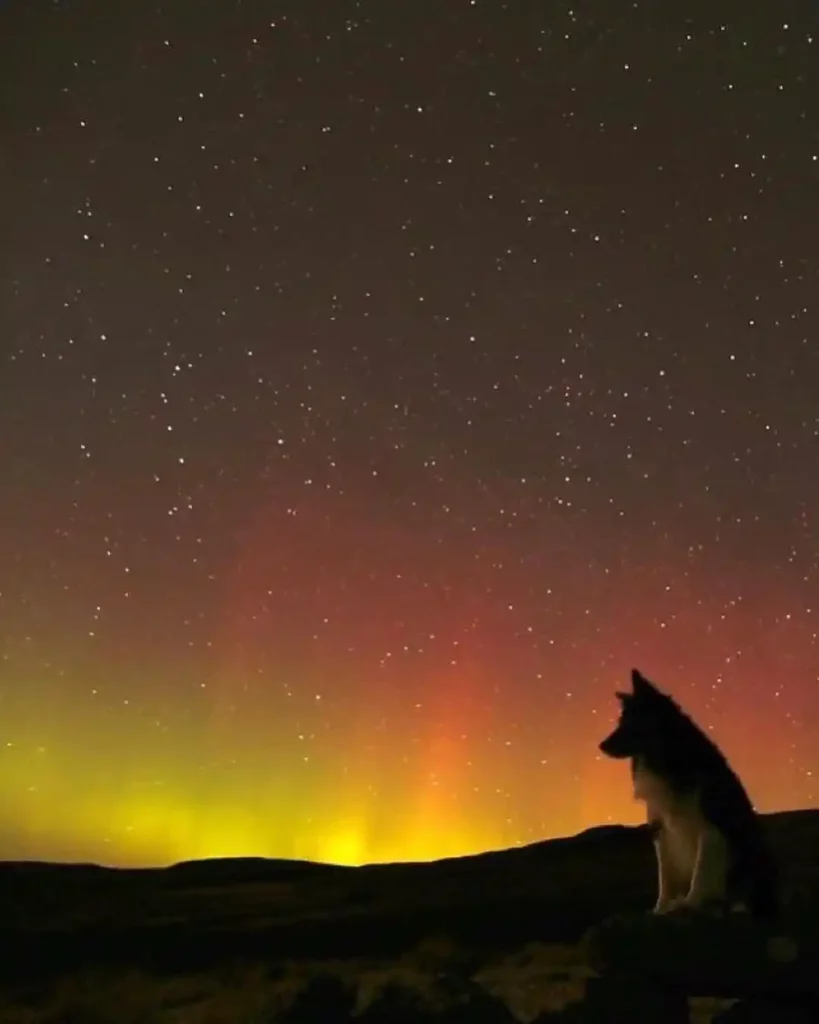
1. Isle of Skye: Where Magic Meets the Aurora
The Isle of Skye is renowned for its breathtaking landscapes and mystical charm. This remote island is an ideal location to witness the Northern Lights in all their glory. Imagine the ethereal dance of lights against the backdrop of dramatic mountains, fairy pools, and rugged coastlines. The Isle of Skye offers a magical experience that will leave you in awe.
2. Shetland Islands: A Northern Lights Haven
The Shetland Islands, located to the northeast of mainland Scotland, provide a perfect vantage point to witness the celestial spectacle of the Northern Lights. With their remote location and minimal light pollution, the Shetland Islands offer an excellent opportunity to immerse yourself in the enchanting dance of colors across the night sky.
3. Caithness and Sutherland: Wilderness and Wonder
For those seeking a truly wild and untouched Northern Lights experience, Caithness and Sutherland are the ideal destinations. These remote regions in the far north of Scotland boast vast open landscapes, rolling hills, and stunning coastlines. Immerse yourself in the untouched wilderness as you marvel at the celestial wonders unfolding above you.
4. Aberdeenshire: Coastal Charm and Celestial Delights
Aberdeenshire, with its charming coastal towns and picturesque countryside, offers a unique combination of coastal beauty and celestial wonders. Find a secluded spot along the coast, away from urban areas, and witness the Northern Lights painting the sky with their magnificent colors. The rugged cliffs and sandy beaches create a picturesque setting for this awe-inspiring spectacle.
5. Edinburgh: The Capital of Northern Light Scotland
While the bustling capital city of Edinburgh may not be the first place that comes to mind for viewing the Northern Lights, it does offer occasional sightings of this breathtaking phenomenon. If you happen to be in Edinburgh during a particularly active period for the Aurora Borealis, head to Calton Hill or Arthur’s Seat for a chance to witness this celestial marvel above the city skyline.
6. Cairngorms National Park: Nature’s Spectacle
Cairngorms National Park, located in the heart of the Scottish Highlands, is not only a paradise for outdoor enthusiasts but also a prime location for viewing the Northern Lights. The park’s vast expanses of untouched wilderness and towering mountains provide a stunning backdrop for the dancing lights of the Aurora. Experience nature’s spectacle in this remarkable national park.
7. Angus and Dundee: City Lights and Celestial Magic
Angus and Dundee may be known for their vibrant city life, but they also offer a unique opportunity to witness the magic of the Northern Lights. Head away from the city center to the rural areas, where the skies are darker, and you’ll be treated to a celestial display that beautifully complements the city lights below.
8. Isle of Lewis and Harris: Where Skies and Seas Collide
The Isle of Lewis and Harris, located in the Outer Hebrides, is a place of rugged beauty and stunning coastal vistas. This remote island offers a front-row seat to the captivating dance of the Northern Lights. Picture the lights reflecting on the calm waters surrounding the island as you lose yourself in this mesmerizing display.
9. Orkney Islands: Remote Serenity and Celestial Wonders
The Orkney Islands, situated off the northeastern coast of Scotland, are known for their ancient history and picturesque landscapes. These islands also provide an excellent opportunity to witness the Northern Lights. With their pristine beaches, ancient standing stones, and rugged cliffs, the Orkney Islands offer a serene setting to experience the celestial wonders above.
Things to Do
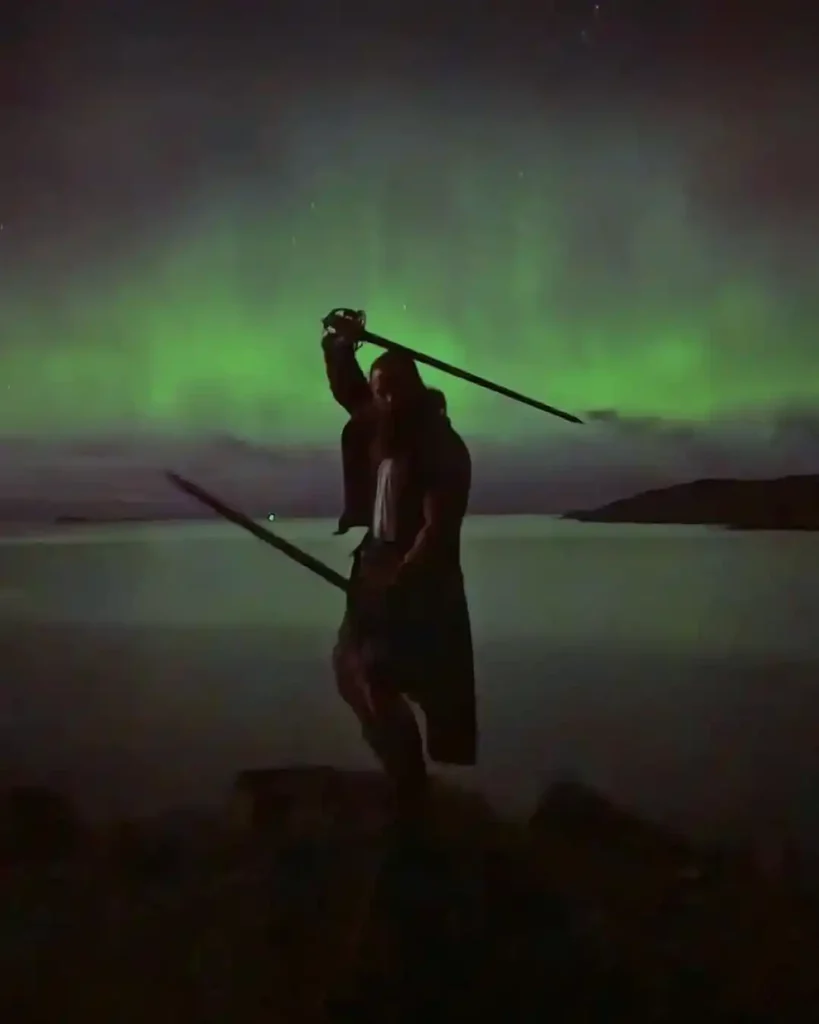
When planning your Northern Lights adventure in Scotland, consider the following things to make the most of your experience:
- Dress warmly and in layers to stay comfortable during cold nights.
- Bring a tripod for steady photography of the Northern Lights.
- Check the weather forecast and choose clear nights for better visibility.
- Stay patient, as the Northern Lights can sometimes be elusive and require waiting.
Things to Avoid
- To ensure a successful Northern Lights viewing experience, avoid the following:
- Avoid areas with high light pollution, such as major cities.
- Do not forget to check the local weather conditions before heading out.
- Avoid disturbing the natural environment and respect any guidelines or restrictions in place.
Accommodations and Facilities
Accommodations
- Remote Lodges : Scotland is home to charming lodges situated in remote areas, away from light pollution and bustling cities. These lodges provide cozy and comfortable accommodations, often with breathtaking views of the surrounding landscapes. Imagine snuggling up by a fireplace and gazing out at the dark sky, waiting for the Northern Lights to make their appearance.
- Hotels and Resorts : Many hotels and resorts in Scotland cater to travelers seeking an aurora-filled experience. These establishments offer comfortable rooms, and amenities, and often have knowledgeable staff who can provide information about the best times and locations for viewing the Northern Lights.
- Bed and Breakfasts : For a more intimate and personalized experience, consider staying at a bed and breakfast. These charming accommodations offer a cozy atmosphere and a chance to connect with local hosts who may share their insights and tips for observing the Northern Lights.
- Campgrounds and Glamping : If you’re an adventurous soul, camping or glamping (glamorous camping) in Scotland can be a unique way to experience the Northern Lights. Many campgrounds and glamping sites provide facilities such as heated pods or yurts, allowing you to enjoy the beauty of nature while staying comfortable.
- Observatories : Some regions in Scotland have dedicated observatories equipped with telescopes and viewing platforms specifically designed for observing celestial phenomena. These facilities provide an ideal setting for stargazing and Northern Lights sightings, often with knowledgeable staff on hand to provide guidance and information.
- Visitor Centers : In popular Northern Lights viewing locations, visitor centers may offer educational exhibits, interactive displays, and informational sessions about the Aurora Borealis. They can provide valuable insights into the science and folklore surrounding this natural wonder.
- Aurora Viewing Points : Certain areas in Scotland have designated aurora viewing points, equipped with benches, shelters, and sometimes even heated huts. These locations are strategically chosen for their unobstructed views and are ideal for setting up cameras and tripods to capture stunning photographs of the Northern Lights.
Conclusion
When planning your Northern Lights adventure in Scotland, choosing the right accommodations and facilities can greatly enhance your experience. Whether you prefer a cozy lodge nestled in the wilderness, a hotel with knowledgeable staff, or a unique camping experience, Scotland offers a variety of options to cater to your preferences.
Additionally, observatories, visitor centers, and dedicated aurora viewing points provide facilities that can enrich your understanding and enjoyment of the Northern Lights. So, book your stay and prepare to be captivated by the celestial dance of the Aurora Borealis in Scotland.
How much did you like Our detailed insider Northern Lights in Sweden: All you need to know before Your Visit? Review Also, please share these Blogs with your friends on social media.
Related Post:-
- Northern Lights in Greenland
- Northern Lights in Sweden
- Northern Lights in Iceland
- Northern Lights in Finland
- Northern Lights in Norway
Northern Lights in Scotland FAQs
when is the best time to see the northern lights in scotland.
The best time to see the Northern Lights in Scotland is during the winter months, from October to March, when the nights are longer and darker.
Are the Northern Lights visible every night in Scotland?
No, the visibility of the Northern Lights depends on various factors such as solar activity, weather conditions, and light pollution. It’s not guaranteed to see them every night.
Do I need special equipment to see the Northern Lights?
While not necessary, bringing a good quality camera and tripod can help you capture the beauty of the Northern Lights in photographs.
Can I see the Northern Lights from the major cities in Scotland?
While it’s possible to see the Northern Lights from cities like Edinburgh and Dundee on rare occasions, it’s generally recommended to head to more remote locations with darker skies for better visibility.
Are there guided tours available for Northern Lights sightings in Scotland?
Yes , there are several tour operators in Scotland that offer guided Northern Lights tours, providing expert knowledge and maximizing your chances of witnessing this natural spectacle.

Meet David Hoper, a passionate travel Blog writer with 7+ years of experience in travel content. Through his exemplary storytelling and engaging narratives, he shares his experiences and brings destinations to life. With a keen eye for detail and a love for exploration, he has cultivated a diverse portfolio of travel blogs that inspire and inform readers worldwide.
In this article:

Post written by: David Hoper
Leave a reply.
Your email address will not be published. Required fields are marked *
Save my name, email, and website in this browser for the next time I comment.

Adventure Activities Northern Lights: Top 5 Places to See Northern Lights in Canada 2024

- July 13, 2023
Adventure Activities Explore Best Northern Lights Tour in Fairbanks (Alaska) in 2024
You may also like.

Top 15 World’s Most Unique Hotels In The World
- 16 minute read

Northern Lights in Lapland (Finland): All You Need to Know Before Visiting

Skimboard Sizing Chart: The Ultimate Guide to Choosing the Right Board
- 5 minute read
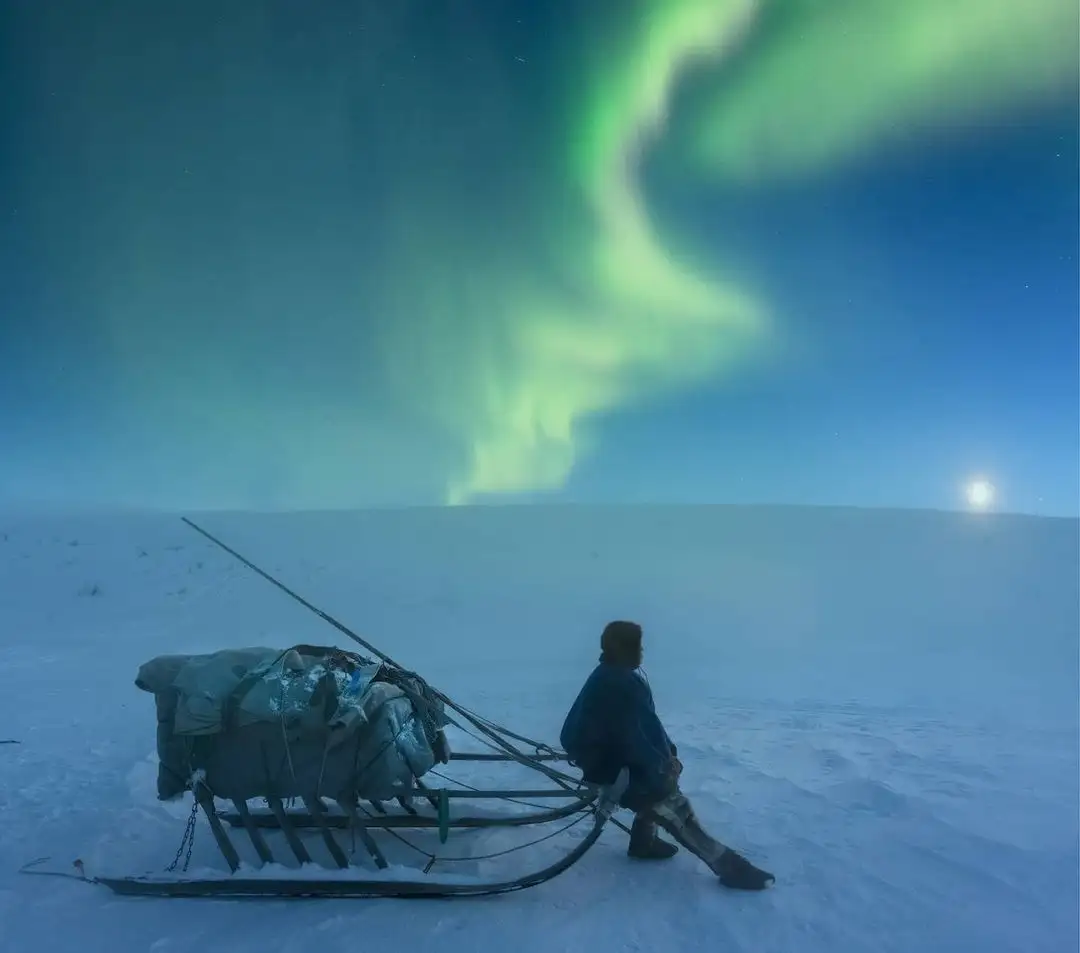
Russia Northern Lights: Top 9 Places to See the Aurora Lights
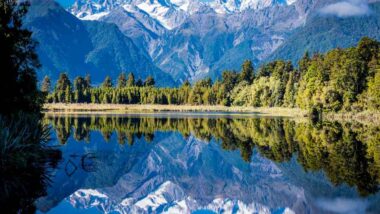
Seasonal Guide: Best Time to Visit New Zealand for Your Dream Trip
- 13 minute read
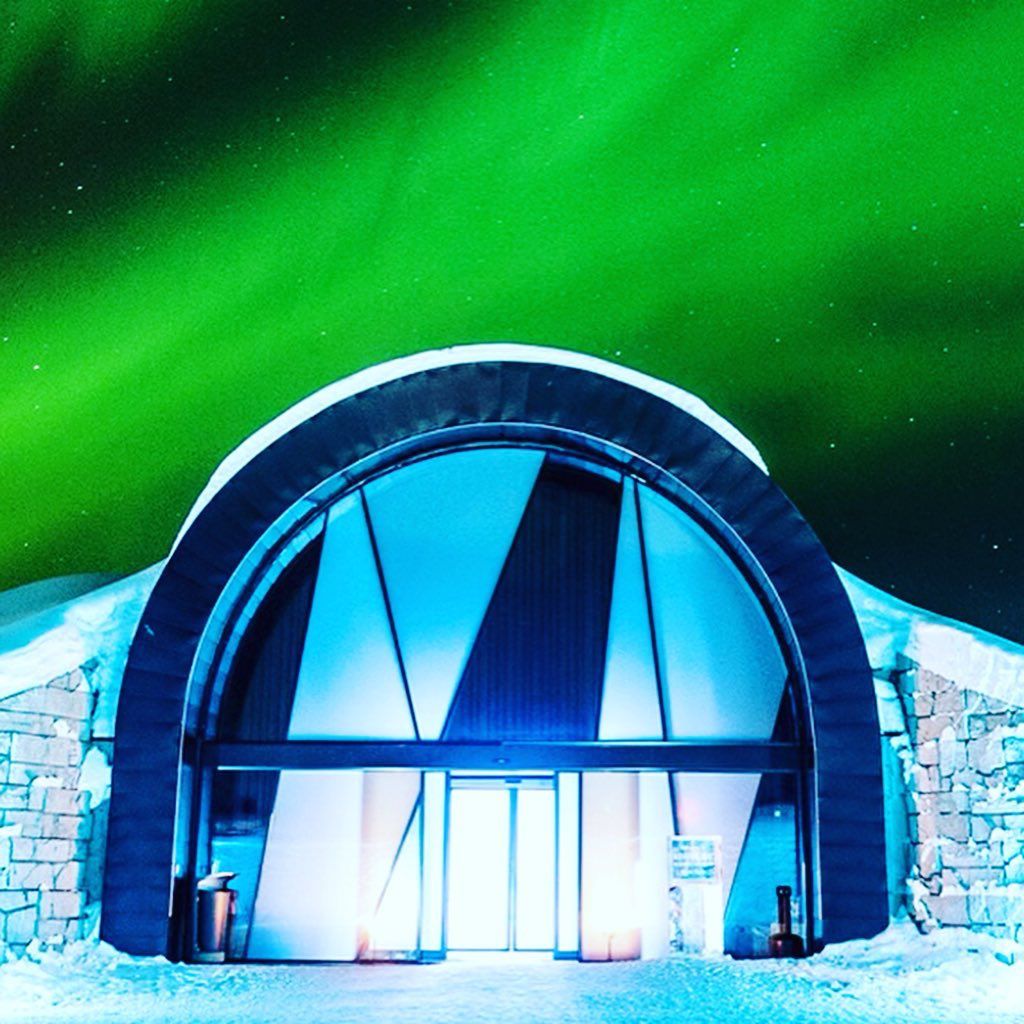
Northern Lights in Sweden 2024 | Everything You Need to know before Visit
- 7 minute read
Our Latest Instagram Posts
@amazingworld.travel8.
- 01463 240467
- [email protected]
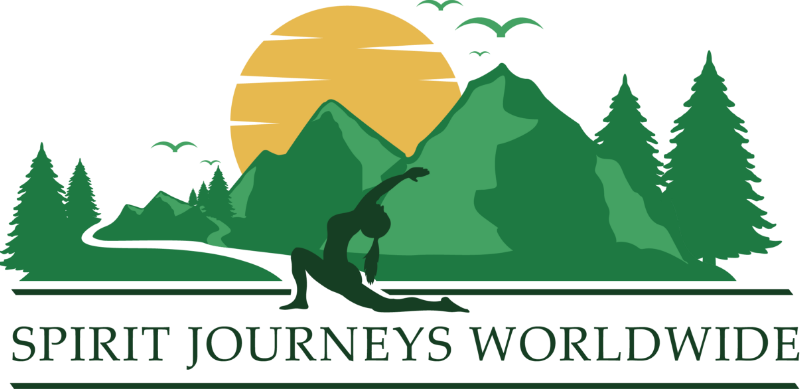
Northern Lights Tour
Book a tour.
- Price On Request
- 7 days / 6 nights
What’s Included
Destination, short description, tour includes, price does not include, tour itinerary.
Day 1 in Inverness(-/-/-)
Arrive in Inverness at your own leisure. Check into your hotel and relax.
The rest of the day is free for you to enjoy and explore the Highland Capital at your own leisure.
Overnight Inverness
Included :Accommodation
Day 2 History Tour of Inverness Area (B/-/-)
Culloden Battlefield
You will be visiting the award-winning Culloden Battlefield visitor centre. With over 1,200 dead in just one hour, Culloden was a short but bloody battle. It was the last to be fought on British soil. Now all the family can experience and understand so much more about the events leading up to, during, and after the battle.
Fort George It was built to pacify the Scottish Highlands in the aftermath of the Jacobite rising 1745. Replacing a Fort George in Inverness constructed after the 1715 Jacobite rising to control the area. The current fortress has never been attacked and has remained in continuous use as a garrison.
Overnight in Inverness
Included : Accommodation and Breakfast
Day 3 (B/-/-)
Day 4 Inverness to Wick (B/-/D)
Today we will leave the Highland Capital and make our way North towards the Dark Skies of Caithness.
On Route we will stop at Royal burgh of Tain and Dornoch. There will be plenty of opportunities for photos on the route.
Overnight in Wick
Included : Accommodation, Breakfast and Dinner
Day 4 Wick (B/-/D)
You will explore Wick at your own leisure. If you are a whisky lover, you can optionally visit the Old Putney Whisky Distillery for a spot of Whisky tasting.
In the early evening, we are heading on a search of the Northern Lights. Do not forget to wrap up warm so you are nice and cosy. We will take you to the popular spots where you should most likely see the lights.
Overnight Wick
Day 5 Wick to Scourie (B/-/D)
You will be travelling along the most Northerly coast over to Scourie. The crofting village of Scourie, once a Clan Mackay stronghold, lies at the centre of the parish of Eddrachilles in North West Sutherland. Scourie is another popular base to see the Northern Lights.
Overnight in Scourie
Day 6 Scourie (B/-/D)
On this day, you can enjoy the area at your own leisure. In the evening you will be heading from your accommodation with a flask of hot chocolate and travelling in search of seeing the Aurora Borealis ( Northern lights).
Day 7 Scourie to Inverness(B/-/-)
On day 7 you will depart the west coast of Scotland and travel back to Inverness. On a route back you will visit Ullapool and Rogie Falls.
Included : Breakfast
When you arrive to Inverness , you will depart Inverness at your own leisure.
If you would like to extend your holiday, getting touch with us and we can arrange this for you.
Location Map
Test test test, tour images, essential details.
7 days/ 6 nights searching for sights of the beautiful Northern Lights in Scotland. This is a great experience that can be booked by individuals, couples, or families with children. It can get chilly at night, bring some warm clothes, a flask for a warm drink, and compy footwear.
Additional Information
Suitable for solo, suitable for couples, suitable for children, suitable for groups, suitable for students, suitable for business, suitable for wheelchairs, discover more adventures, other tours.

Yoga twilight Tour of Taj Mahal

Yoga Retreat on the Backwaters & Beaches of Kerala

Walk the West Highland Way

Uganda Gorillas, Chimps & Wildlife Lodge Safari-7 days

Uganda Gorilla Trekking Safari Adventure- 8 Days

Two day Loch Ness Monster 66 tour
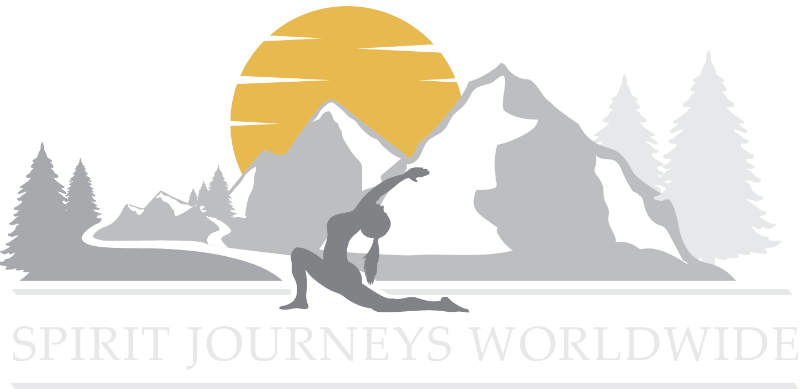
Discover transformative adventures with Spirit Journeys LTD’s travel tours, where immersive experiences and cultural encounters await.
- Inside UK 01463 240467
- Outside UK (+44) 1463 240467
- SJ Travel Centre, Unit 3 Fairways Retail Park, Inverness, IV2 6AA
- Search For a Tour
- Choose your Destination
- Types of Travel
- Read Our Blogs

- Privacy Policy
- Cookie Policy
- Booking Terms & Conditions
- COVID-19 Policy
- Code of Conduct
Copyright 2024 Spirit Journeys. All right reserved
Find tours based on your interests, find your perfect tour.
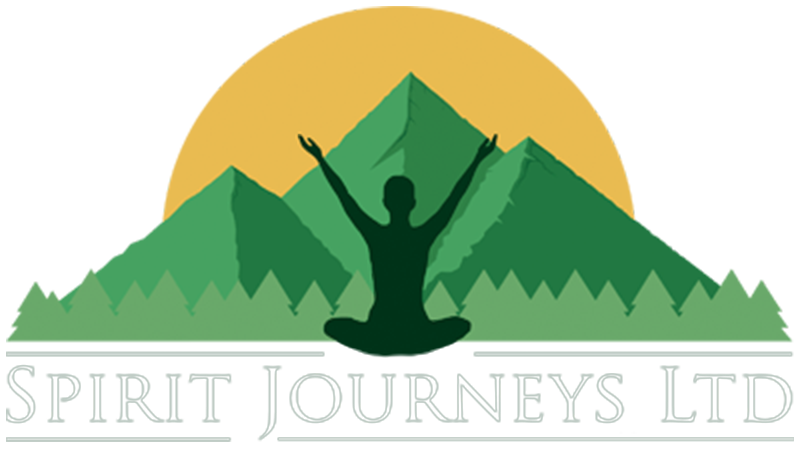

Where to See the Northern Lights in Scotland (and Top Tips For Spotting Them)
Hunting out the Northern Lights in Scotland? Read on to discover the top spots for spotting the Aurora Borealis.
I love Scotland – it’s a seriously underrated destination. And, as somewhat of an Aurora enthusiast, I love that you can (sometimes) see the Northern Lights from the very northern fringes of the country.
One thing I’ve learned on my many trips to the Highlands is that, if you travel to Scotland in autumn or winter, you might just be fortunate enough to see the Northern Lights.
Though, for full disclosure, I’ll tell you that it’s not as easy as spotting the Northern Lights in Norway or Iceland . But I love a challenge, and I’m here to show you that it certainly can be done. So wrap up warm and cross those fingers.
Read on to discover my top tips for spotting the Aurora Borealis in Scotland.
PS: Want to delve into how to plan a Northern Lights Trip? Watch this video!
Watch on YouTube
Are the northern lights visible in scotland.
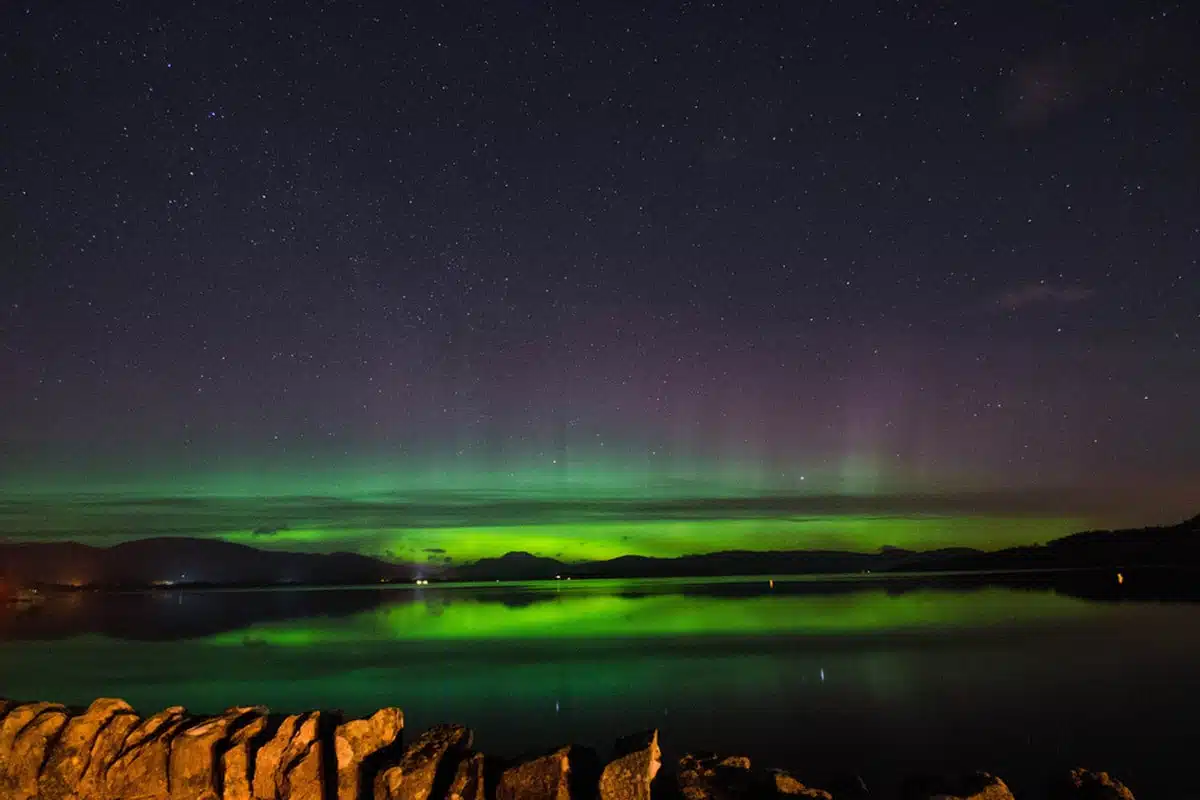
Short answer: Yes.
Long answer: It’s tricky and timing is everything, but it’s very possible to spot the Aurora Borealis in Scotland if you’re in the right place at the right time between late September and late March.
The country is far enough north to provide an excellent chance to see the Aurora Borealis and has several places where you can see them. So stick around as I share my top tips, my fellow Northern Lights hunter.
Where To See the Northern Lights in Scotland
Alright, I’ve teased you enough. Let’s get into the top places to spot the stunning colours dancing across the sky.
Shetland Islands
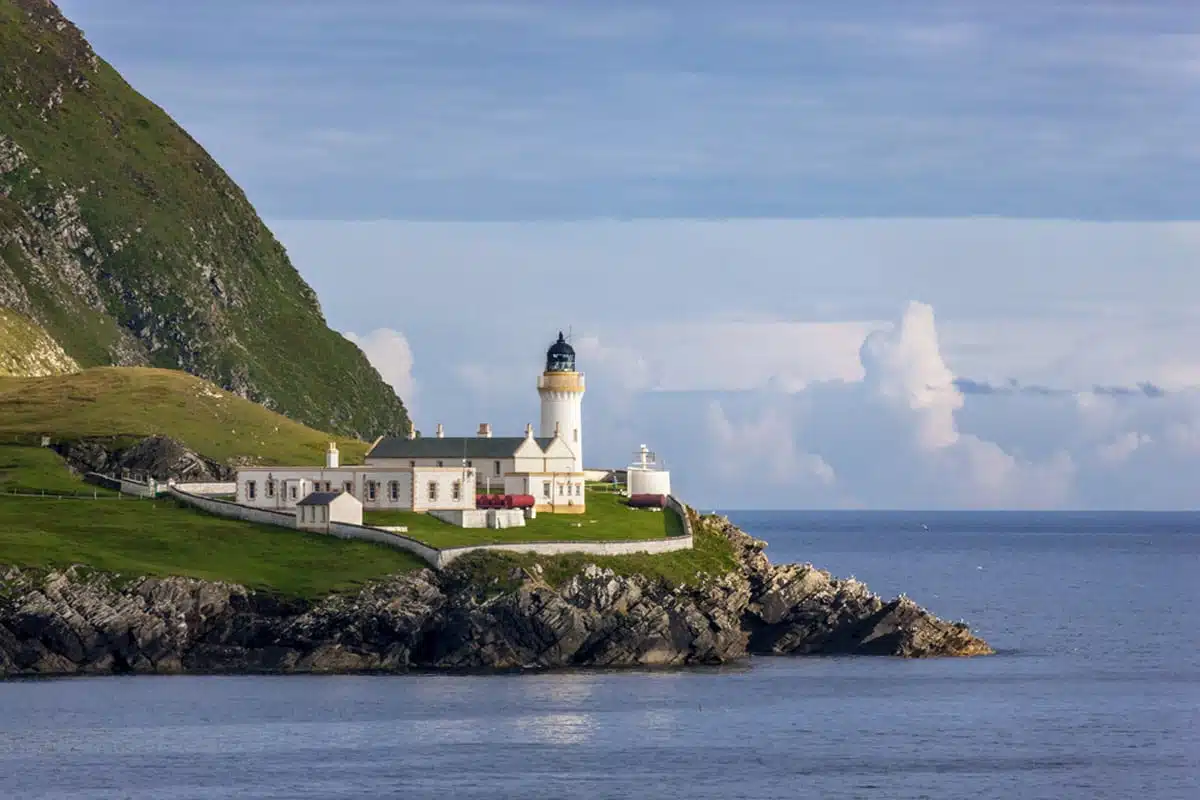
Given that your chances of viewing the lights increase as you travel farther north, it should be no surprise that the Shetland Islands offer one of your most incredible opportunities to view the kaleidoscopic phenomena.
Locals attest that you can see the auroras several times throughout the winter, with a mixture of low-level displays and one or two more stunning ones.
Outer Hebrides/Isle of Lewis and Harris
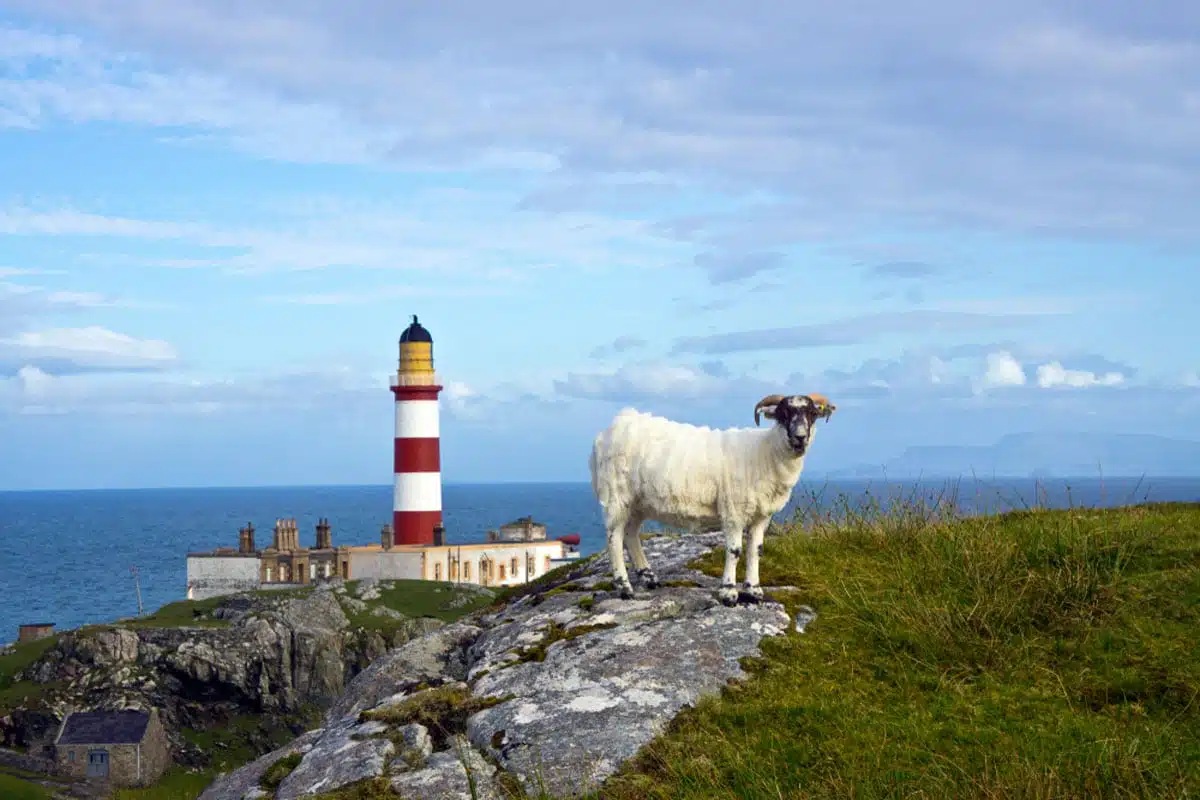
The Outer Hebrides are a different group of islands I recommend considering for observing the Northern Lights in Scotland. This Atlantic Ocean archipelago in the northwest boasts stunning, isolated islands far from light pollution.
Take advantage of a visit to the Isles of Lewis and Harris if you’re going to the Outer Hebrides. The sky is dark and there’s minimal light pollution in this area, making for ideal conditions for a potential glimpse of the Northern Lights.
There are many secluded beaches on the Isle of Harris, while Lewis’s flat, open countryside offers expansive, deserted vistas ideal for scenic views.
Orkney Islands
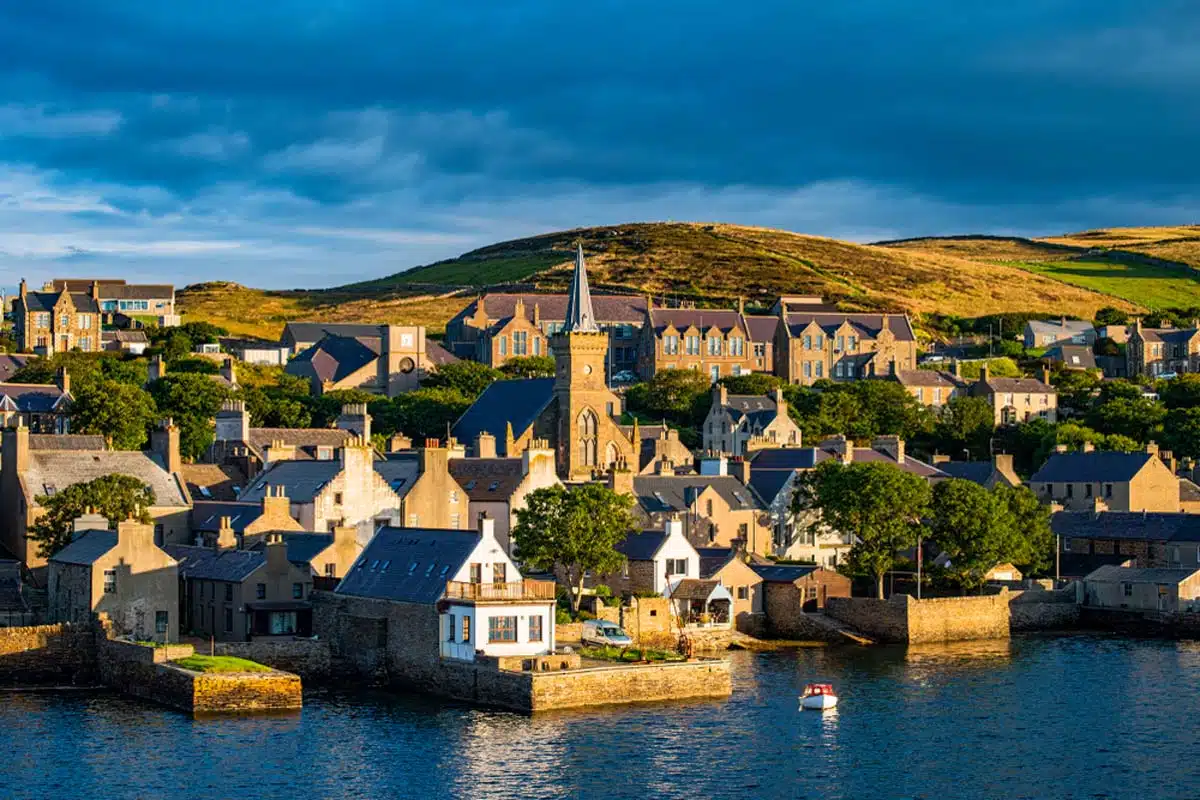
Yeah, yeah, you might be bored of all the islands by now, but they really are going to give you your best chance at spotting the phenomenon.
The Orkney Islands is a group of 70 islands that sit at a prime location for observing the Aurora Borealis in Scotland. The seashore at Birsay, the beach at Dingieshowe, and the summit of Wideford Hill are some of the most fantastic spots to observe the lights. Wrap up warm, it gets seriously cold here.
Isle of Skye
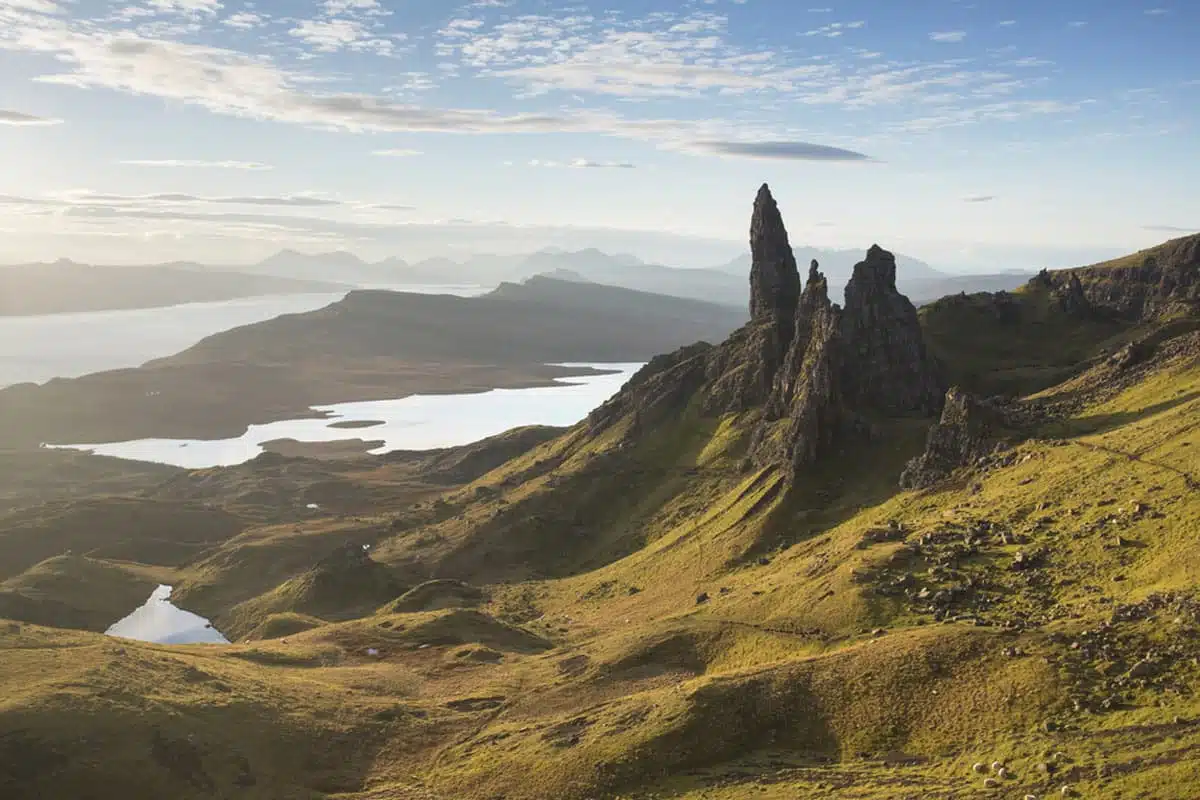
Skye is popular all year round in Scotland with locals and tourists, but travelling to Skye in the fall or winter means fewer crowds and better chances of catching the Northern Lights.
Though, some spots of Skye are better suited for viewing the Northern Lights than others because the island’s high mountains often obscure the sky regions — where they are most likely to be visible.
Rubha Hunish’s northernmost point offers a great chance of seeing the lights dance across the limitless ocean. Glendale, where you will also find the renowned Fairy Pools, is an excellent place where you can occasionally see the lights.
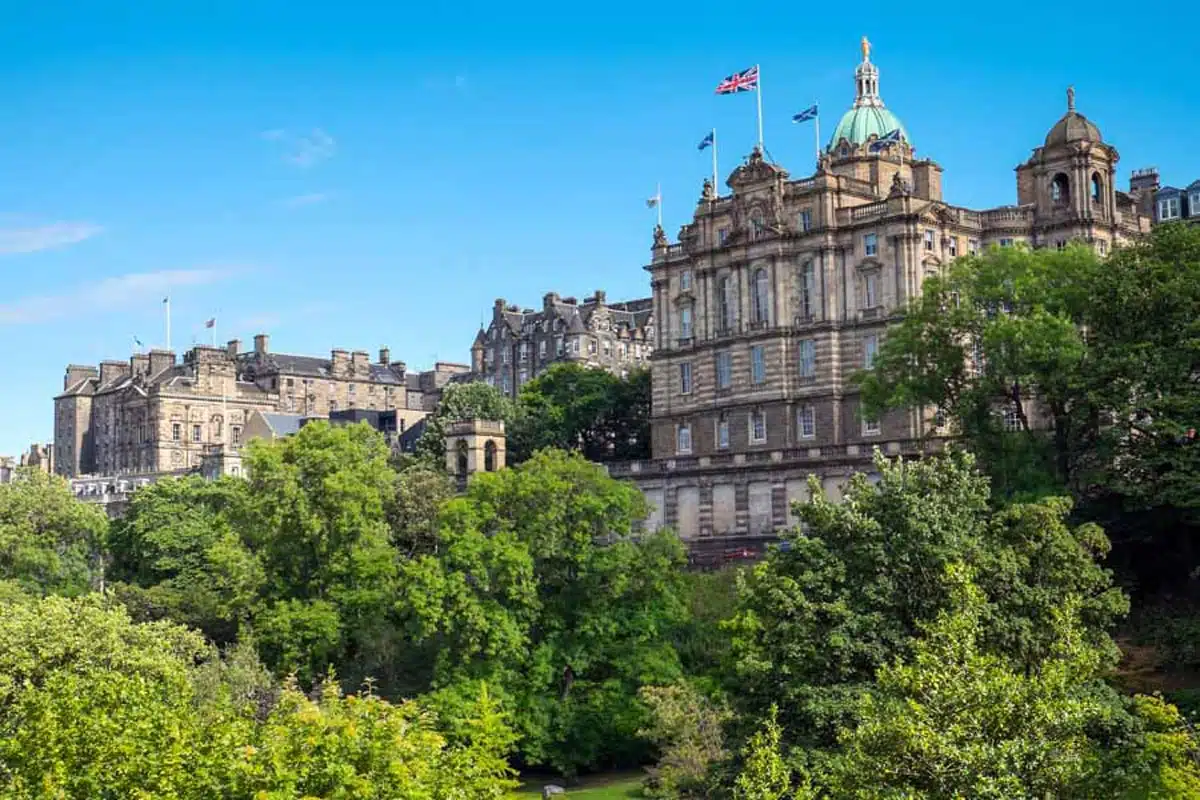
Before you get too excited, this is RARE. However, technically you can spot the Northern Lights in Edinburgh, the Scottish capital.
You’ll need an excellent vantage position to see the Northern Lights in Edinburgh. Take a stroll to a higher elevation, such as Calton Hill, for a breathtaking view of the metropolitan skyline.
Other incredible spots to see the lights are Blackford Hill and the fabled Arthur’s Seat, accessible via a winding, steep staircase – an excellent climb, either way.
Aberdeenshire and Moray Speyside
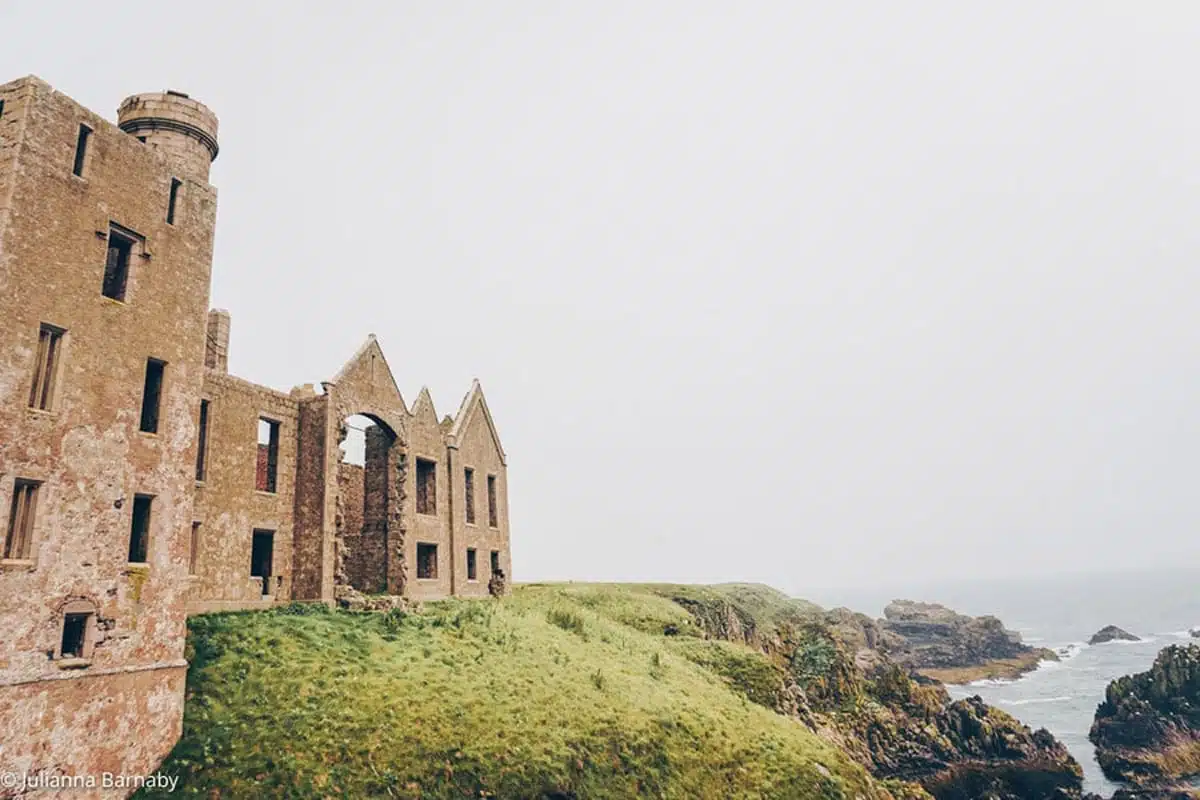
When the northern horizons have nature’s light show in the winter, it draws aurora seekers to the Moray Coast’s starry skies.
Both Nairn and Portknockie make excellent bases for the night, while the Moray Astronomy Club’s Sigma organisation occasionally hosts open aurora viewing events ideal for learning more about this unique phenomenon.
Since this region of Scotland experiences less rain than the west does, there may be a clear sky at night to view the Northern Lights.
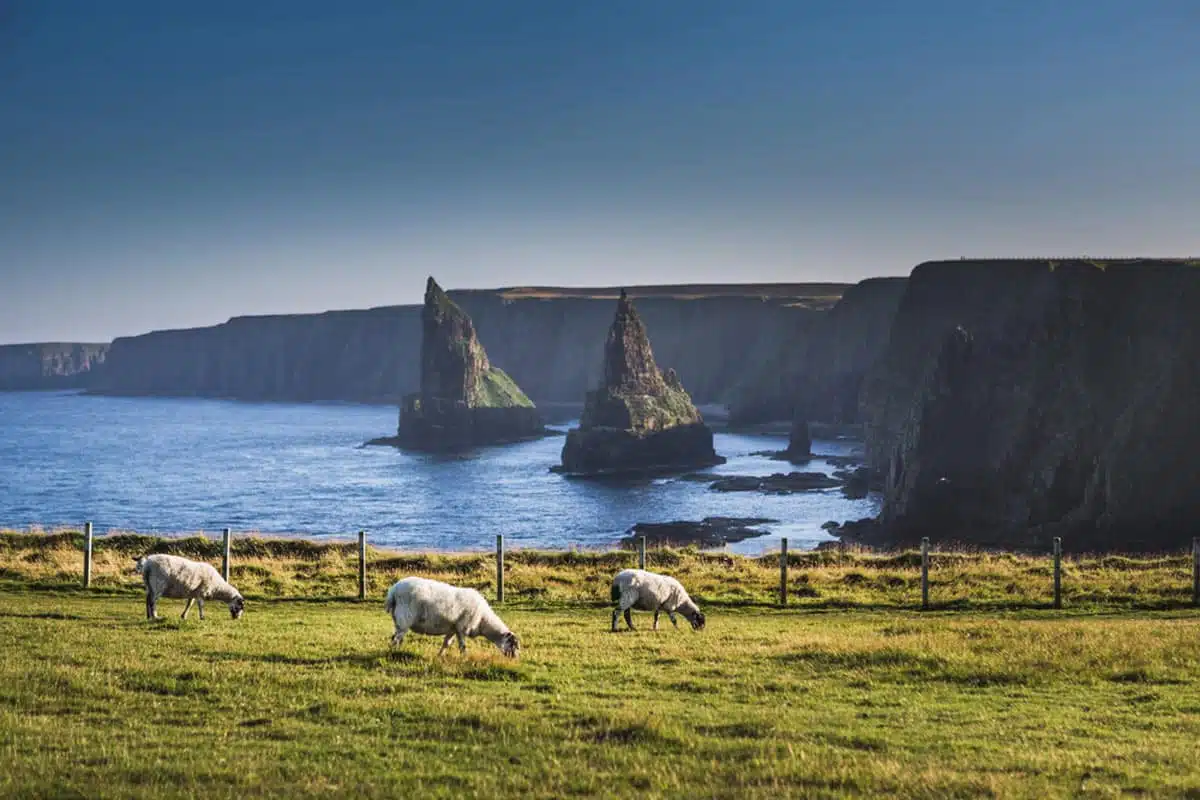
The historic Scottish county of Caithness, located at the northernmost edge of the mainland, has very low light pollution. And, if you haven’t learned by now, this makes it one of the best sites in Scotland to view the Northern Lights.
There are many locations to go aurora hunting in this region, including the charming lighthouse at Noss Head. Around Dunnet Head, Thurso Harbour, and Duncansby Head are other incredible locations to see the dancing lights.
The Cairngorms
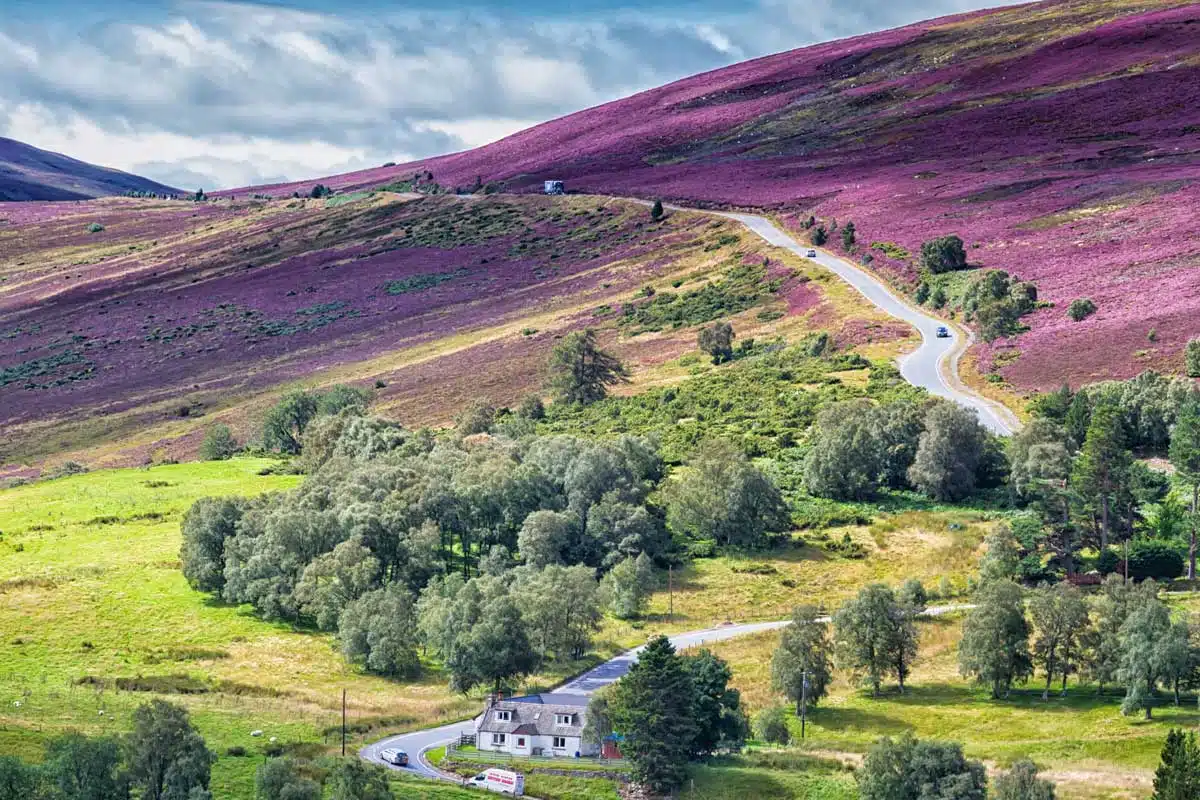
Alright, so The Cairngorms might not be the first place you think of for an aurora trip, but do not underestimate it.
The UK’s largest National Park might just be one of the best places to spot the Northern Lights – as long as you choose a location away from trees and the sharp inclines of the many mountains in the region, with as much of the sky visible as possible.
You can find the ideal viewing conditions in the national park; try looking north from the Cairngorm Mountain parking lot, or visit the Glenlivet Estate, which is well-known for its dark-sky events.
Psst… After you’ve spotted the lights, travel to Royal Deeside to see some castles.

Galloway Forest Park
Galloway Forest Park is the only Dark Sky Park in Scotland. It was the first park in the UK to gain this status in 2009 meaning it is free from any light pollution disrupting the view of the night sky.
In recent years, an increasing number of people have reported seeing the aurora borealis in Galloway Forest Park, despite its southerly location in Scotland compared to others in this list.
This stunning spot in south west Scotland was initially famous for its beaches and forests that contain endless miles of hiking and biking trails, while on a good day you can see across to Ireland. Potentially spotting the Northern Lights is a relatively new and additional bonus that makes this gorgeous spot even more attractive.
Isle of Mull
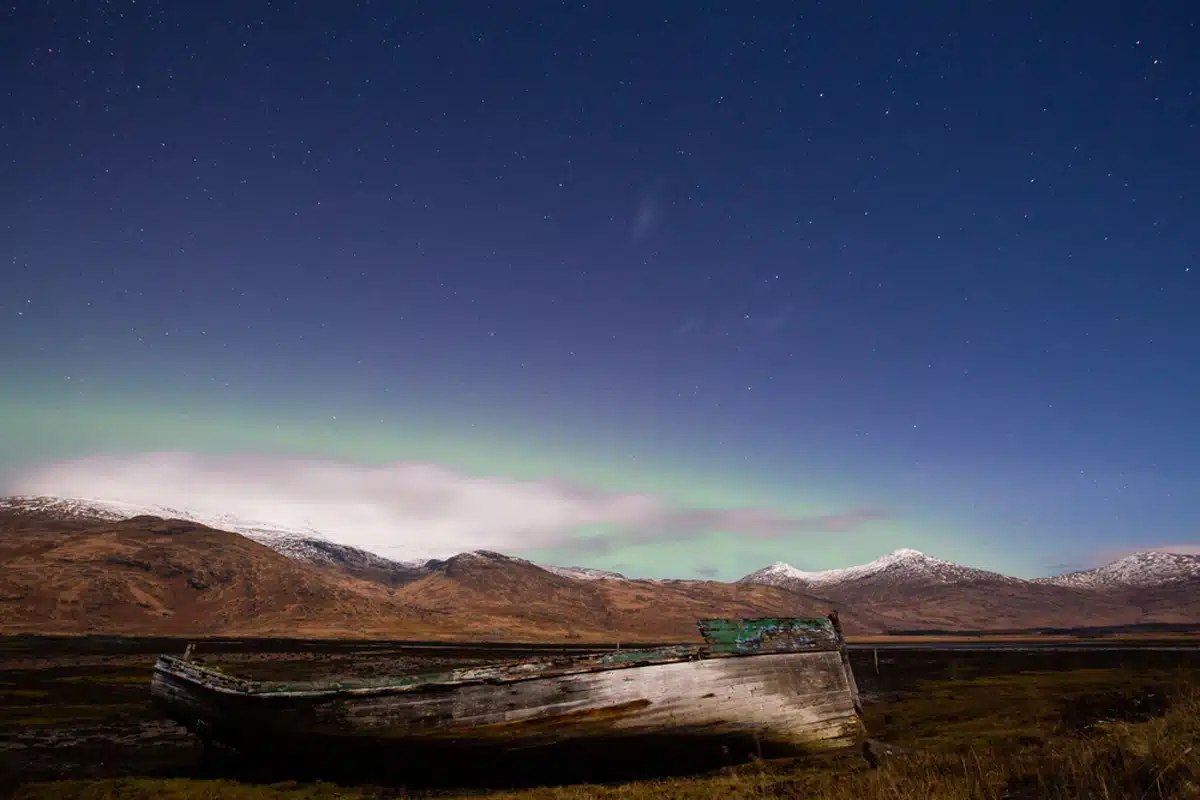
Located in the Inner Hebredies, the Isle of Mull is a wonderful spot to see the Northern Lights. Just off the west coast of Mainland Scotland, a short ferry ride away from Oban, this gorgeous island has the ideal conditions to spot the Northern Lights.
With a small population and little light pollution, the regular clear dark skies make it the perfect spot for star gazing, and with it, seeing the Nothern Lights. If you’re staying in the town of Mull, it pays to head out to the countryside to stay away from artificial lights.
Tobermory is one of the best spots, combining stunning views out to sea at Claiach Point with the clear skies sprawling out ahead of you just waiting for the spectacular light show to begin.
Meanwhile, on mainland Scotland, Torridon is another awesome spot to capture the Northern Lights in all their splendour. Home to an incredible landscape mixing snow-capped mountains, rolling green hills, and rugged coastline, Torridon is an oasis of beauty in its own right.
Yet, its lack of light pollution means that Torridon has some of Scotland’s clearest skies, while its remote location makes it really easy to spot the dancing colours of the Northern Lights across the sky.
This is a great spot for you to capture the Northern Lights on photos at their absolute best, particularly if you can get them reflecting off one of the crystal lakes.
Kildonan Mountains
The Kildonan Mountains is one of mainland Scotland’s most northerly spots and is surrounded by beautiful landscapes complete with undulating green hills, and rocky coastlines that the unrelenting Atlantic Ocean continuously batters.
The mountains are also one of the best spots to see the Northern lights across the ocean, with snow-capped peaks and hillocks very much in view.
With the mountains very much isolated from any surrounding towns or villages, light pollution is non-existent, while the spectacular landscapes add an absolutely breathtaking backdrop to the stunning colour formations of one of nature’s most glorious treasures.
Best Time of Year to See the Northern Lights in Scotland?
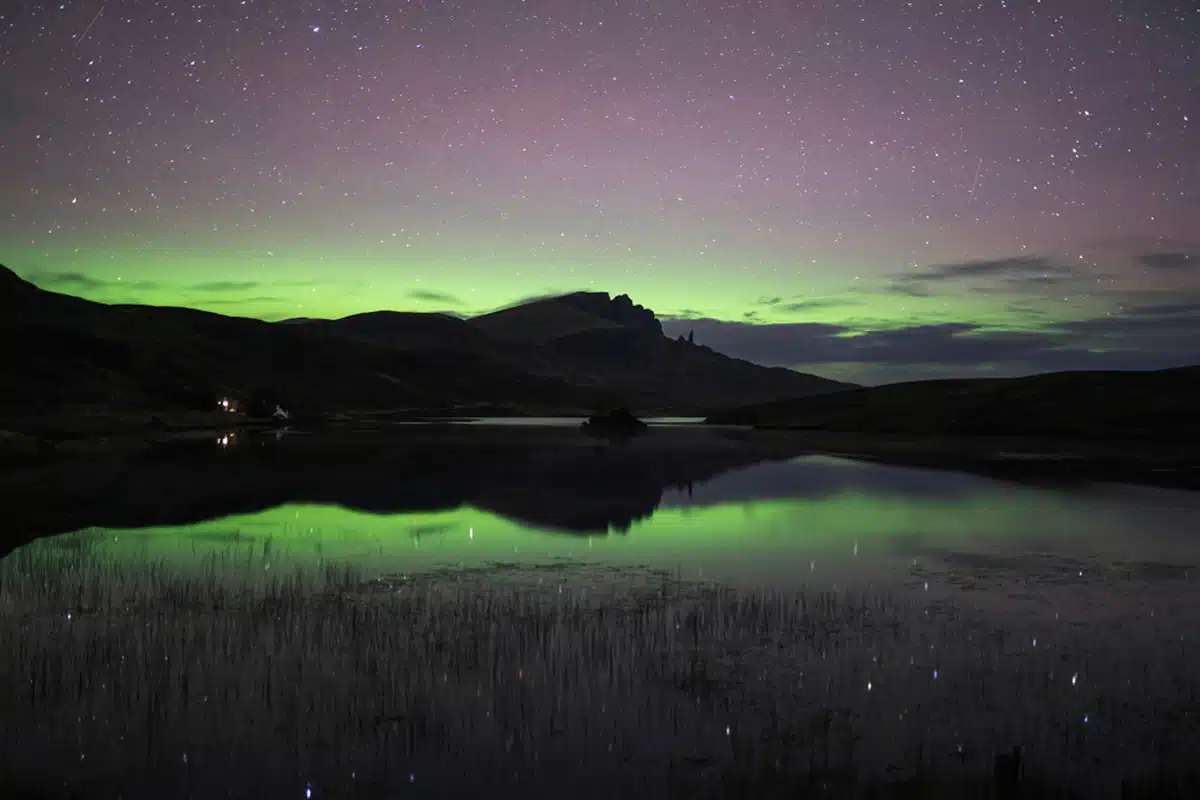
December through February is the best time to see the lights in Scotland as they are the darkest months. You need more than just a pitch-black night, though – only under conditions of active solar activity will you be able to observe the Northern Lights.
If you want a more solid chance to glimpse the Northern Lights in all the glory, I recommend a trip to the Arctic Circle in Scandinavia. Spotting the Aurora Borealis in Iceland or Norway is a treat.
Practical Tips
- Keep an eye on the weather forecast, as you will need a clear night sky to see the aurora. Use this UK tracker to check.
- I don’t want to sound like your nagging Grandma, but seriously, wrap up warm. It can be cold at night, even in the summer. Also, pack snacks and drinks, as you may be there for a while.
- This one isn’t crucial unless you’re looking to flex on the ‘Gram – make sure you have a good camera with a tripod to capture the lights.
- Be patient. It may take a while to track down the lights, but once you see them, it’ll all be worth it.
- And lastly, enjoy! If you are lucky enough to see the lights in Scotland, be sure to soak in the full experience.
Northern Lights Scotland: Read Next
- Best Time and Places to See Northern Lights in Norway
- Spotting the Northern Lights in Iceland
- How to See the Northern Lights: Top Tips for Seeing the Aurora Borealis
- Top Things to do in Scotland
Love This? Save and Share on Pinterest
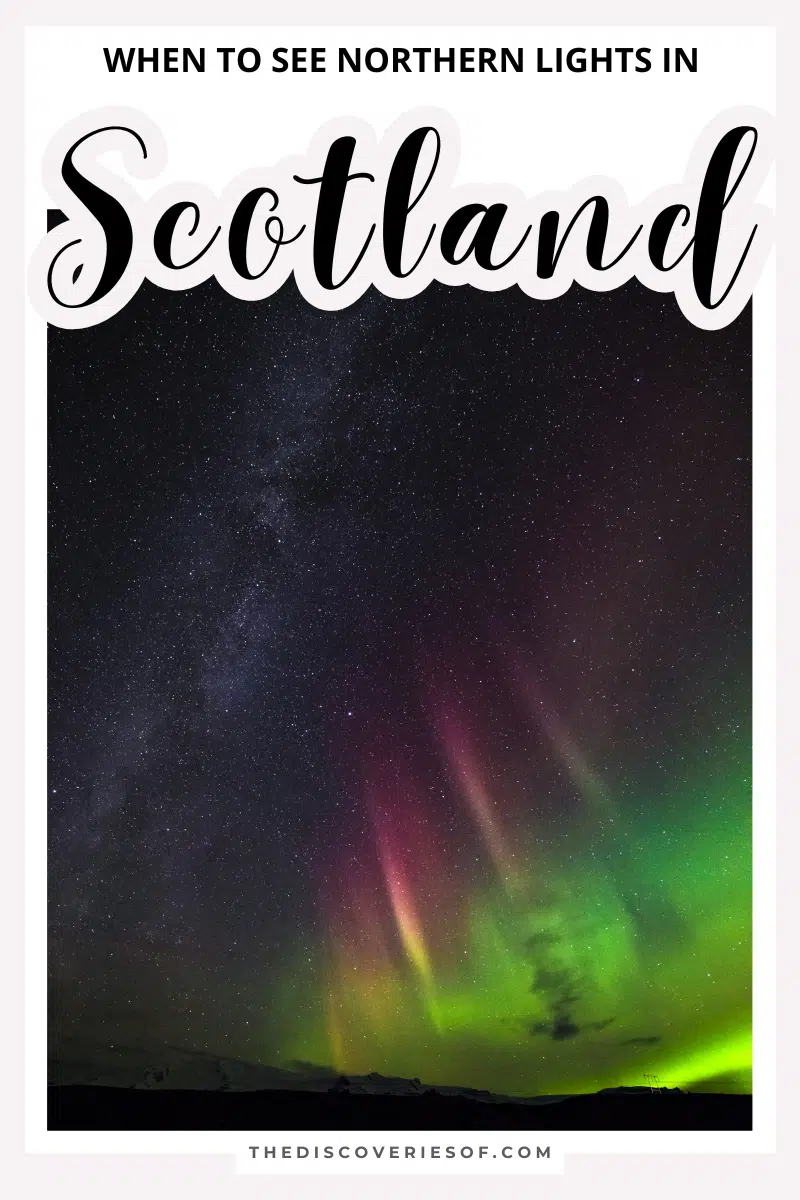
I’m Julianna Barnaby - a professional travel writer and geek extraordinaire. I started The Discoveries Of to help you to discover the best of new destinations from around the world.
Discovering new places is a thrill - whether it’s close to home, a new country or continent, I write to help you explore more and explore differently.
Related Posts
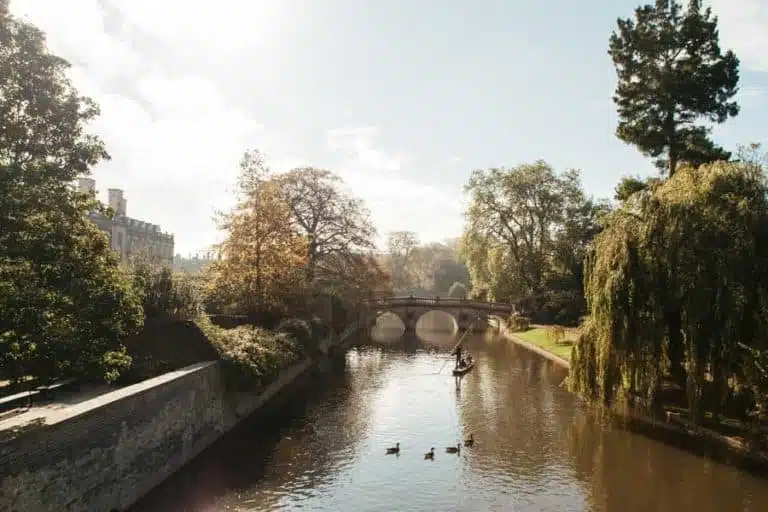
The Best Things to do in England: Discovering England’s Timeless Charm
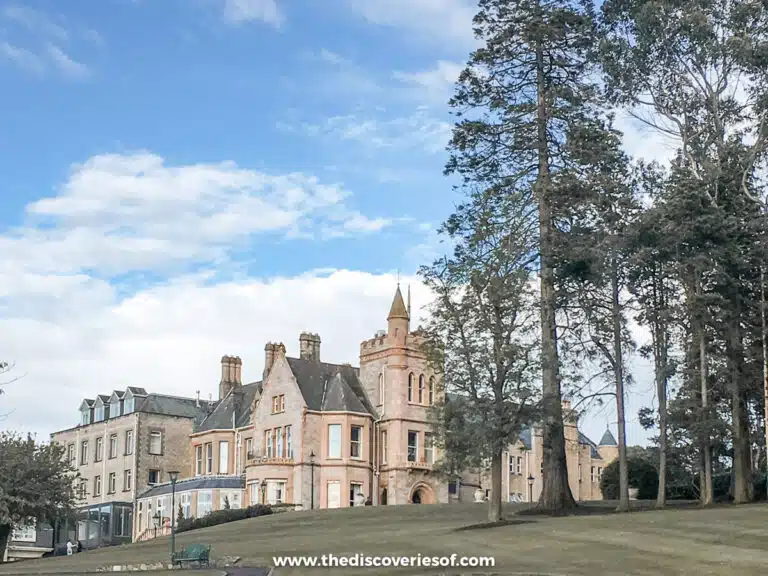
The Culloden Estate & Spa Review: A Luxury Hotel Stay in Northern Ireland
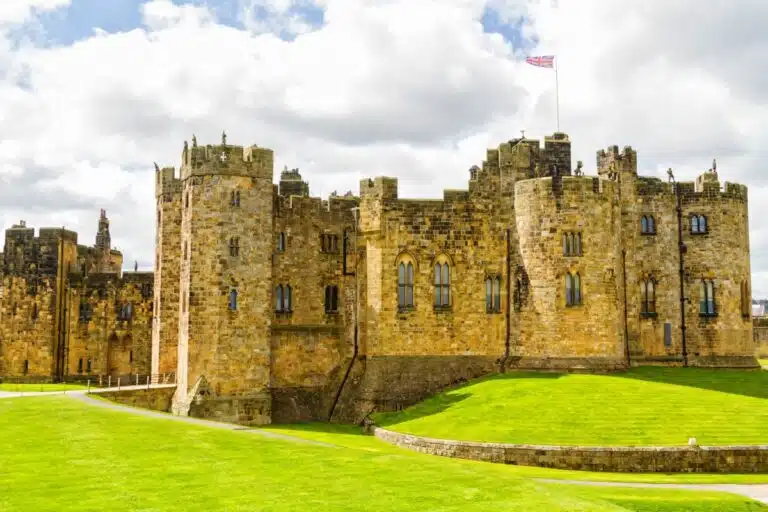
14 Stunning Castles in England You Have to Visit
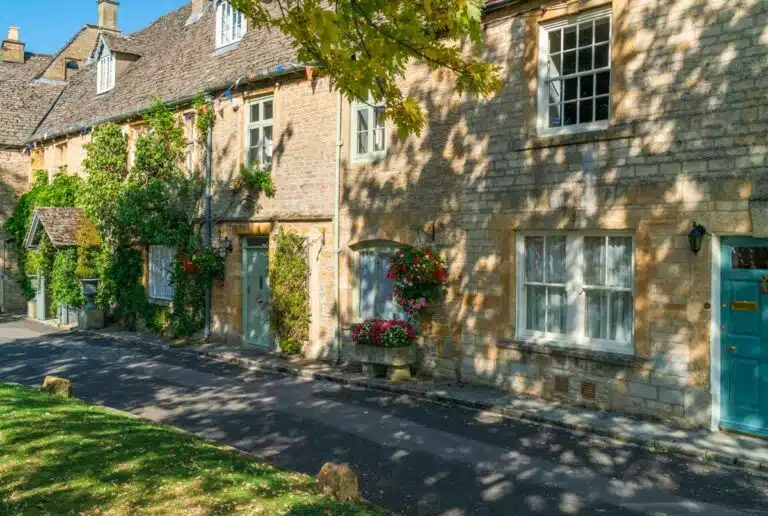
Pretty Cotswolds Villages and Towns You Have to Visit

Follow me on Instagram for travel inspiration, tips, and guides.

- > Outdoor Scotland
- > Where To Spot The Northern Lights In Scotland
Where To Spot The Northern Lights In Scotland
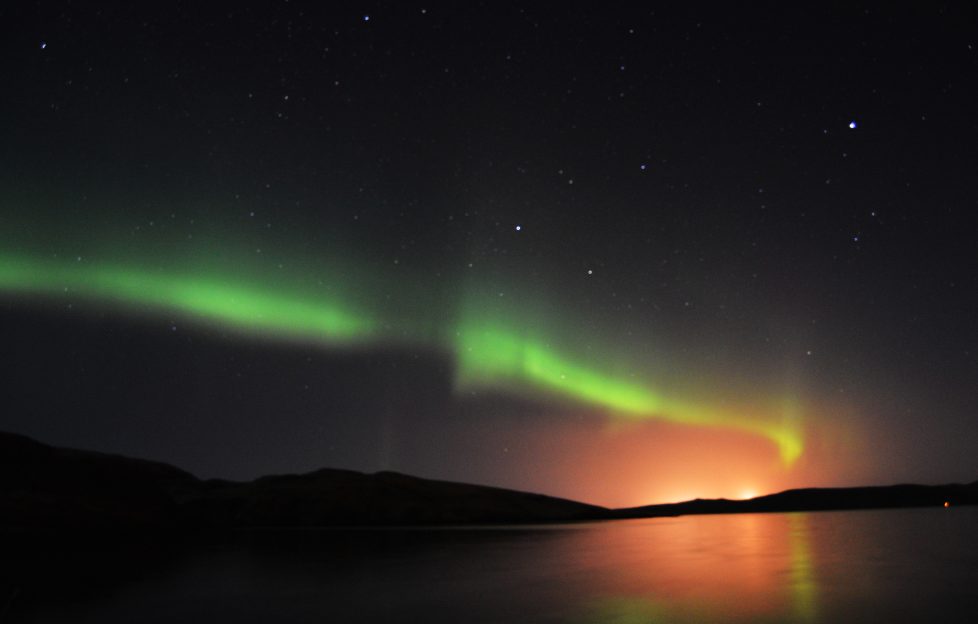
You don’t have to go to Iceland to see the northern lights, it’s possible to catch a glimpse here in Scotland! Here are some of the best places to spot them…
Scotland offers some spectacular opportunities to witness the mesmerizing Northern Lights.
While sightings of the Aurora Borealis are never guaranteed due to the natural variability of the phenomenon, certain locations increase your chances of catching this celestial display.
It must be a dark, clear night and often the illumination of a full moon helps. While the best time of year is during the winter months from September to March.
Shetland Islands
The most northerly part of the UK, Shetland provides an ideal location for observing the Northern Lights. Being the closest you’ll get to the North Pole in Scotland, Shetland’s clear, unpolluted skies create a perfect canvas for the dancing colours of the auroras.
Galloway Forest Park
Designated as an International Dark Sky Park, Galloway Forest Park in southwest Scotland minimizes light pollution, providing a tranquil setting to witness the Northern Lights. Various dark sky tours are on offer which if timed perfectly may include a northern lights sighting.
Isle of Skye
The Isle of Skye, with its remote and unspoiled landscapes, provides a dark sky away from light pollution. The Old Man of Storr or the Quiraing are excellent spots for capturing the auroras against stunning natural backdrops.
Cairngorms National Park
As one of the darkest places in Scotland, Cairngorms National Park offers optimal conditions for photographing and viewing an aurora. The elevated terrain and lack of city lights enhance the visibility of this natural wonder.
Various online tools exist to track the likelihood of spotting the northern lights in Scotland. This is one of our favourites (CLICK HERE)
Discover more of Scotland’s perfect stargazing skies >>
Related posts.
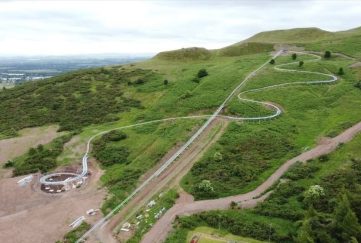
Scotland’s First-ever Alpine Coaster Opens This Weekend

Top 9 Scottish Podcasts
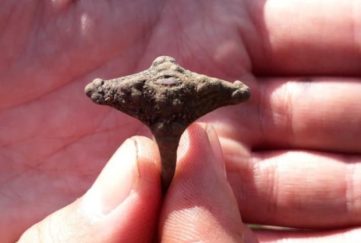
Rare Pictish Ring Discovered In Excavation Of Moray Fort

Find a Stockist
Enter your postcode below (with a space) and click "Find" to search for your local stockist.

- Explore Stays
- Tips & Articles
Can you see the Northern Lights in Scotland? (2024/2025)
Can you see the Northern Lights in Scotland? When can you see the Northern Lights in Scotland? What are the Northern Lights? When is the best time to see the Northern Lights in 2024 or 2025? Where is the best place to see Northern Lights in Scotland? Want tips on how to improve your chances of viewing the aurora borealis in Scotland? Why do you need a torch with a red light like this one from Amazon?
Photo: Maria Macdonald, South Uist
Read our top tips on how to view the Northern Lights and then take a holiday to Scotland to see this breath-taking natural spectacle.
Make 2024 or 2025 the year you see the Northern Lights in Scotland.
What time of year is best to see the Northern Lights in Scotland?
The best time of year to see the Northern Lights in Scotland is the autumn and winter months when the nights are longer and darker. They don’t appear on set dates each year and are only visible in dark skies.
Can you see the Northern Lights in the summer?
During the summer months it’s virtually impossible to see the Northern Lights because summer nights are very light in the north of Scotland (and the rest of the aurora-watching places). The Northern Lights can happen at any time of year but you need dark skies to see them.
Best months to see the Northern Lights in Scotland
A clear, dark winter night can give you breath-taking views of this display. There can be up to 18 hours of darkness in winter which increases your chance of seeing the aurora. As a general guide, we recommend the following months:
- December – the shortest day is 21 December so there are more hours of darkness at this time of year which could increase your chance of seeing the Northern Lights
We don’t suggest you plan a holiday to see the Northern Lights in the months of:
- May – although May 2024 had some amazing northern lights despite the reduced hours of darkness
- June – the longest day is 21 June when there is very little darkness
There is still a chance you may see the aurora if it’s dark enough at night during the spring or autumn. But if your main aim is to see them, you’re best to avoid these months. If you visit Scotland in August, you’ll find it’s only truly dark for several hours. This means you have almost no chance of seeing the Northern Lights in August in Scotland.
How often do you see the Northern Lights in Scotland?
There is no easy answer to this question as it depends on factors such as the right solar conditions, clear skies and it needs to be in the autumn or winter.
Best places to see the Northern Lights in Scotland
So where can you see the Northern Lights in Scotland? In theory, the Northern Lights can be seen anywhere within the UK if geomagnetic conditions are very active.
Usually, it’s the north of the UK which gives you the best chance of seeing the “mirrie dancers”. This is why Scotland’s Highlands and Islands are such a great place to stay to see the Northern Lights. Spending your holiday as far north as you can, could increase your chances too.
Northern Lights accommodation in Scotland
You don’t need to go on a special “Northern Lights holiday” in Scotland. We’ve seen them just from the garden or window of the holiday cottages we’ve been staying in.
This means there are potentially lots of chances to see them. We recommend booking your accommodation in a remote area of Scotland with little or no light pollution so you might be able to see the Northern Lights from where you’re staying. It’s also important to remember that there’s no guarantee of seeing them so choose a destination that interests you in other ways too.
Some of the best places to see the Northern Lights in Scotland’s Highlands and Islands are:
Outer Hebrides
The Outer Hebrides is a fantastic place to see the Northern Lights in Scotland and I’ve been fortunate to see them several times whilst on holiday on North Uist. This island chain has little light pollution so take your pick from Lewis, Harris, South Uist, North Uist, Benbecula, Barra and Eriskay.
The Northern Lights are called Na Fir Chlis (the Nimble Men) in Scottish Gaelic folklore.
See places to stay on the Outer Hebrides
View this post on Instagram A post shared by CJ Macleod (@calcomacleod) on Mar 23, 2018 at 5:47pm PDT
Isle of Skye
There are 9 Dark Skye discovery sites on Skye so you’re spoilt for choice when it comes to finding somewhere without light pollution.
See places to stay on the Isle of Skye
Isle of Mull
See places to stay on the Isle of Mull
Caithness coast and Sutherland
As the most northerly part of the mainland, Sutherland and Caithness are a good place to stay to increase your chance.
See places to stay in Caithness and Sutherland
Orkney Isles
Orkney is off the north coast of Scotland so another good place for Northern Light hunting. Try setting up watch on the beach at Dingieshowe, the coast at Birsay, or the top of Wideford Hill.
See places to stay on Orkney
Moray coast
The area of Moray is one of the more southerly areas where you might have a good chance of seeing the Northern Lights in Scotland. Moray’s Astronomy Club, Sigma , sometimes runs public aurora watching sessions.
See places to stay in Moray
Wester Ross coast (including Gairloch and Ullapool)
See places to stay in Wester Ross
View this post on Instagram A post shared by Graham Bradshaw (@bradders_72) on Jul 4, 2018 at 12:16pm PDT
See places to stay in the Cairngorms and Aviemore
Fort William and Lochaber
It’s possible to see the Northern Lights from Fort William even though it’s a busy town with street lights.
See places to stay in Fort William and Lochaber
The islands of Shetland are the most northerly part of the British Isles so they are a good place to see the Northern Lights. Avoid places with street lights, such as Lerwick, as this can reduce your chances.
In Shetland they call the Northern Lights the “mirrie dancers” which is a perfect name for these dancing ribbons of light.
See places to stay on Shetland
Scotland Northern Lights holidays
Check out our directory for some stunning holiday accommodation in the Scottish Highlands & Islands to see the Northern Lights.

See: 15 stunning photos of the Northern Lights in Scotland
Northern Lights Scotland forecast 2024/2025 – will I see the Northern Lights tonight?
For a Northern Lights forecast in the UK, there is AuroraWatch UK, part of Lancaster University, which provides free alerts when the aurora borealis may be visible from the UK including Scotland’s Highlands and Islands. I use their free smartphone app. AuroraWatch UK share it’s data so you can monitor geomagnetic activity in real time.
If you want to know whether you’ll see the Northern Lights in Scotland or the UK tonight, check out the latest info below which is direct from the AuroraWatch website.
Please remember that the Northern Lights are unpredictable and even if they are forecast, you may not see them.
How to view the Northern Lights – our tips to increase your chances of seeing the Northern Lights
Solar activity.
It needs to be a night with increased solar activity – we list some ways to find out when the Northern Lights may be seen below.
Clear night
It needs to be a clear night – you may be able to still see them through broken cloud but if you can’t see the stars then you won’t see the northern lights .
No light pollution
Find a dark location away from light pollution from street lights, cars and buildings. The lack of large cities and towns in the Highlands and Islands of Scotland means you won’t have to go far to find your perfect spot .
Not a full moon
A full moon can make the northern lights difficult to see .
Look all around you
Look north but be aware that if there are high levels of geomagnetic activity you should check in all directions . Use a compass to make sure you know where north is. A smartphone normally has a compass.
Make an effort
It takes a bit of dedication to see the Northern Lights. We are not great at staying up late. If there’s been an aurora alert but we can’t stay up any later, we go to bed set our alarm every hour so we (it’s normally down to me!) can check out the window to see if anything is happening. If you get up in the night for the loo or to get a drink, don’t miss the opportunity to look outside.
Choosing accommodation with large windows can help you do this without having to actually go outside in your pyjamas.
Scotland’s winters can be cold. A clear night sky will be ideal for watching the Northern Lights but the temperature will drop even more. Dress in your warmest outdoor clothing including gloves and a hat.
Wrap up warm and take a flask of tea or a hip flask of your favourite single malt (as long as you don’t have to drive!).
Preserve your night vision with a red light torch
Preserve your night vision by using a torch with a red light instead of white light. White light negatively affects your night vision. Torches with red lights are available from Amazon .
The best times to view are generally between 9pm and 12am so be prepared to wait. There will be some incredible night skies and shooting stars to look at while you wait .
It’s worth checking at any time though if it’s dark.
Be vigilant
They don’t usually exhibit for long so you need to keep looking. A northern lights display could last only a few minutes. A good display may last for no longer than 15-30 minutes. Displays could continue for several hours if you’re very lucky.
Know what the Northern Lights look like
This may sound obvious but if you’ve only seen them in stunning photos, you may not know that they don’t always look like that.
The Northern Lights are created by the Earth’s spectra of gases and the height in the atmosphere where the collision of particles from the sun and the Earth’s gases takes place.
Our naked eye can most easily see the green-yellow part of the spectrum where the sun emits most of it’s light. You’re most likely to see green but the they can also appear white/grey. If you’ve never seen them before and are looking on a cloudy night, you might not be sure what you’re seeing.
We have seen them as wispy grey or white clouds, which can be easy to miss. It was only when they started moving in a strange way, we realised that they were actually the Northern Lights.
Your camera sees more than you can
Our eyes don’t see such bright, vivid colours that are captured by a camera. This means photos of the aurora are normally more impressive than what you will see live. They can also be happening but not visible to the naked eye.
Taking photos can make you miss out
Although everyone would love to capture amazing images of the Northern Lights we suggest that you don’t be too fixated on taking photos, just enjoy watching the magical, shifting ribbons of colour , especially if it’s your first time.
Never give up
Don’t give up. If you don’t see them the first time, keep on trying. When you do see them it will be worth it!
Places to stay with dark skies
The Scottish Highlands and Islands have some of the darkest skies in Scotland. Choose somewhere away from the lights of towns and cities to increase your chances of seeing the northern lights in Scotland. These holiday cottages might be in a good location.
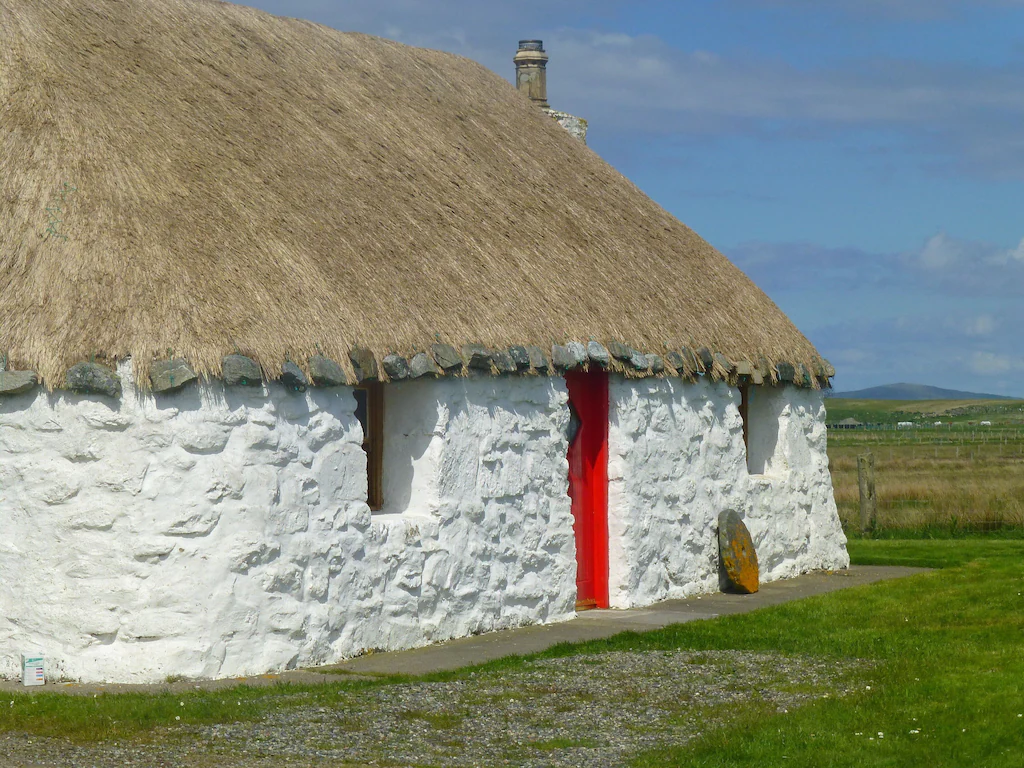
- Create collection
- {{ item.title }}
Blackhouse, North Uist
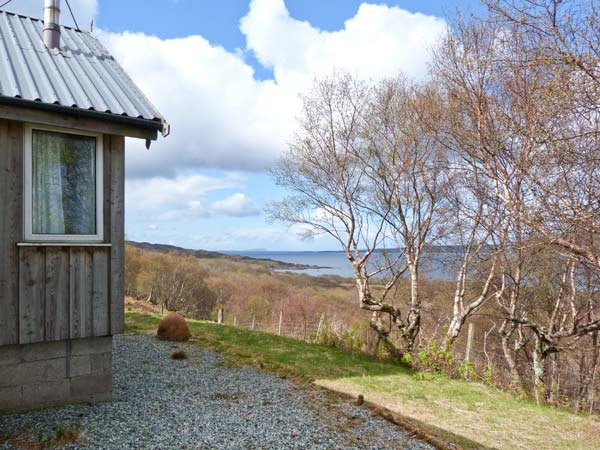
Thorsvik, Tokavaig, Sleat Peninsula
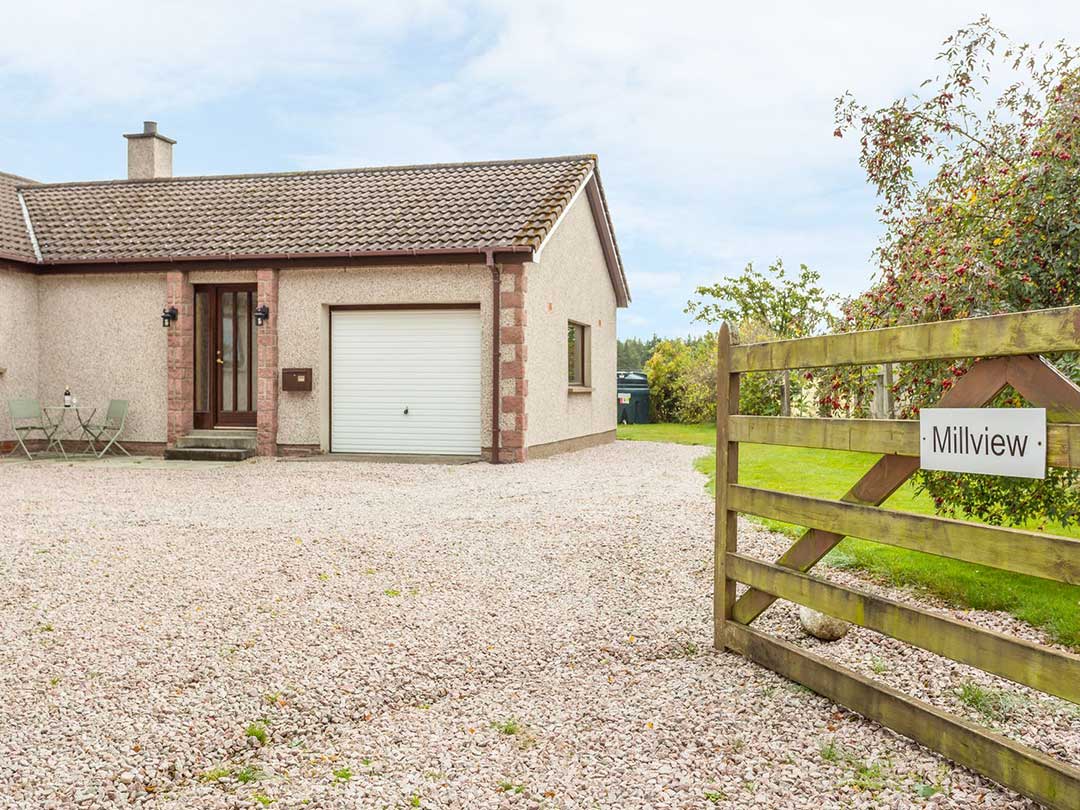
Millview, Boat of Garten
No results available
Northern Lights: Interesting books
- The Northern Lights: Celestial Performances of the Aurora Borealis
- Aurora: In Search of the Northern Lights
- Northern Lights: The Science, Myth, and Wonder of Aurora Borealis
Video – See the Northern Lights in Scotland
How to photograph the Northern Lights
- Northern Lights Photography – the definitive guide by Dave Morrow
- How to photograph the Northern Lights – a good beginner’s guide from Photography Life
Resources and further reading
- Follow @AurorawatchUK on Twitter for alerts and news
Found this post interesting?
You may also be interested in….
Check out our other posts about the Northern Lights in Scotland including:
- What causes the Northern Lights?
- 15 stunning photos of the Northern Lights in Scotland
- Back to top
©2024 — All rights reserved
- Skip to main content
- Skip to secondary menu
- Skip to primary sidebar
- Skip to footer
Scotland Info Guide
A Guide to the Scottish Highlands Islands and Mainland
Chasing Northern Lights in Scotland
February 3, 2017 By Ron 29 Comments
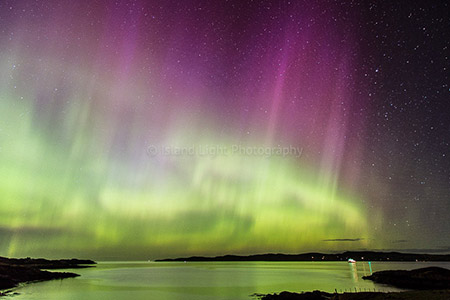
Related info
Scottish Weather and Climate Daylight Hours – Annual Calendar of Sunsrise and Sunset Times
Solar flares and possible Aurora’s occur throughout the year but in the summer it is simply not getting dark enough to be able to witness it. The winter is therefore the best period for the Northern Lights, roughly from early October to end of March. By the way, if you’re in Shetland the Northern Lights are also referred as Mirrie Dancers.
Chasing the Northern Lights in Scotland
More and more folk book expensive trips and travel from all over the world to Iceland, Alaska, Norway or Finland for instance to try and get a glimpse of the Aurora and to hopefully take a few pictures. These trips however don’t guarantee success as the Aurora is somewhat unpredictable, after all it depends on solar activity. So before you spend all your money on an expensive trip north you might want to consider staying closer to home where the chances of an Aurora might be somewhat slimmer than in Alaska, but where you still have a fairly decent chance of seeing them. So how about chasing the Northern Lights in Scotland? I myself live in the south west of Scotland and have seen the Aurora several times from close to my home and a few times from the north-west of Scotland. And I could have seen it more often if only I hadn’t been so lazy when I went to bed instead of staying up and going outside to watch the lights.
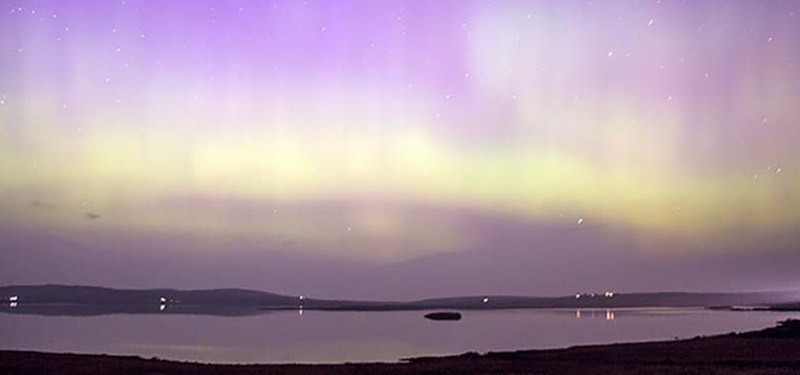
How do you know there is an Aurora expected?
In order to be able to watch the Aurora a few conditions have to be met. First of all the Aurora has to be active, I’ll let you know later on how to find that out. Second of all it has to be an almost cloudless night. It’s also important not to have full moon. You also have to be in a very dark place with as little light pollution as possible and you need to have a clear horizon towards the north as that’s where you are likely to see it first before eventually it becomes strong enough to see it overhead, that is if you’re lucky!
Aurora Alerts
To find out if there is an Aurora expected, or happening right now, make sure to be prepared properly. The first thing you need is to be able to receive alerts when there are chances of seeing the Northern Lights. For an excellent resource with email alerts please visit www.aurorawatch.lancs.ac.uk . Another, more comprehensive website with alerts, live information and maps, is www.softservenews.com . On the latter you will also read about KP numbers which say something about the strength of the Aurora. KP Numbers can be between 0 and 9 and indicate the most southerly latitude where the Aurora can be seen. So an Aurora with KP3 might be visible as far south as the middle of Norway where KP5 might be visible as far south as the north of Scotland. KP9 can potentially be visible as far south as the south of England.
An Aurora alert from www.aurorawatch.lancs.ac.uk looks like this:
Amber alert: possible aurora. Aurora is likely to be visible by eye from Scotland, northern England and Northern Ireland; possibly visible from elsewhere in the UK. Photographs of aurora are likely from anywhere in the UK. Viewing aurora requires clear, dark skies away from light pollution. To monitor current activity see http://aurorawatch.lancs.ac.uk.”
Aurora Smartphone Apps
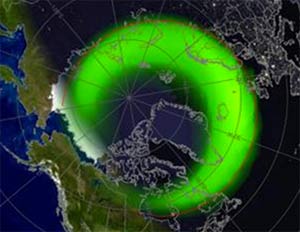
Getting to a good location
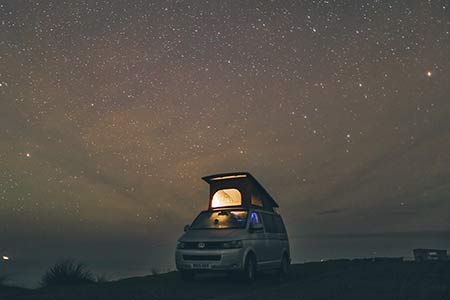
Seeing and Recognising the Aurora
Now that we have the alerts covered it’s time to get prepared to go out and actually try and see the Aurora. If you have mobile data coverage in the location where you are planning to watch the Aurora you can follow live alerts via email and twitter. Unfortunately it’s my experience that the places which are the darkest and most remote are lacking just that so you have to rely on eyesight as well as have a LOT of patience.
The start of the Aurora can come sudden or can gradually build up. I’ve seen on several occasions a whitish arch on the northern horizon which later seemed to climb higher and resulted in a visible Aurora KP 6. I’ve also seen grey and whitish curtains hanging in the sky which suddenly started to blink and turned greenish, that was KP 7. Most times however I’ve seen a distant green glow on the Northern Horizon of Aurora’s with a KP number of 4 or 5.
What you See is NOT always what you Get
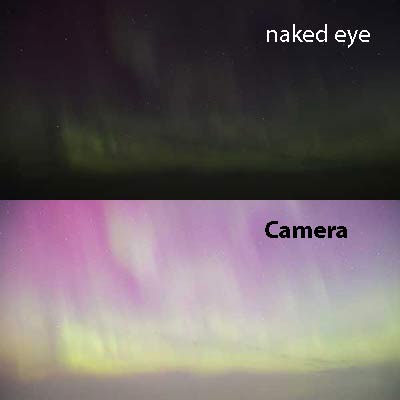
I must admit that I, like many others, haven’t seen the bright green, purple and red colours of the Aurora with the naked eye the same as my camera did record them. For that to happen the Aurora needs to be much stronger to actually witness more than a green glow and greyish mist with the naked eye. That’s something I’d love to see as well.
How to photograph the Aurora
I don’t think there is one fixed rule for photographing the Aurora. What you definitely need is a sturdy tripod, a DSLR with a wide angle lens of at least 35mm, the knowledge to focus your camera in the dark, which is not always easy but Live View and a bright star can help here, and a tool to remotely release the shutter to avoid camera shake. The settings below are a guideline and will vary depending on type of camera and lens. Set the ISO to 1600 Set the camera to M for manual Set the lens to the widest aperture f2.8 or f4.0 Use a shutter speed of 15 seconds to start with.
Check the photos in the viewer and play around with some of the settings if you have under or over exposure. You’ll be surprised of the stunning colours in your viewer compared to what you see with the naked eye.
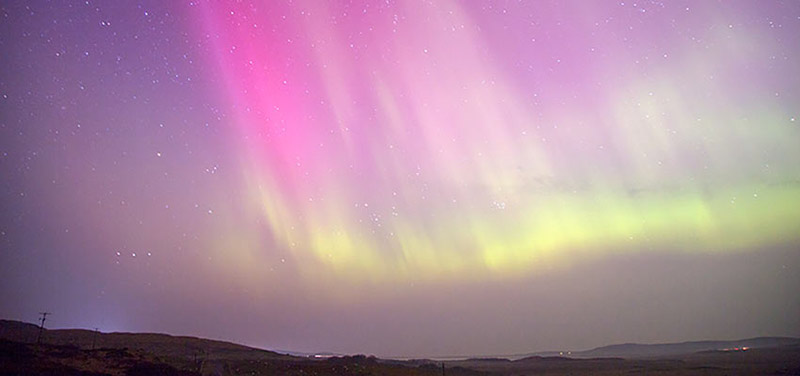
I hope the information I’ve provided here will help you to see the Aurora Borealis yourself. I’m in no way an expert in Aurora watching, neither am I an expert in Aurora photography. I’m just a passionate photographer with a great interest in the natural world around us and a particular interest in what must be one of the worlds most spectacular phenomenons, the Northern Lights.
HAPPY AURORA HUNTING 🙂
Reader Interactions
May 11, 2017 at 4:20 pm
Hi! This is a really great post, very informative! Are there any aurora hunting tours in Scotland? I tried Googling but nothing came up..
May 12, 2017 at 10:42 am
Not that I’m aware of but that could change soon of course. Hopefully the blog post provided enough info to go out on your own 🙂 And when tours do become available we will update our info too 🙂
October 7, 2022 at 9:03 am
Yes there are tours.
Caledonian travel Tartan travel There is also a northern lights flight from Glasgow or Edinburgh Airport
August 20, 2017 at 1:24 pm
Great post! I’ll definitely go Aurora hunting next time I’m in Scotland!
October 28, 2017 at 11:44 pm
Hi Ron, after reading your great post, I have decided to travel to Scotland, and if we are lucky we will see Aurora Borealis. Our trip will be in February, What area do you advise me to stay in order to have a better chance of seeing it ?. Thank you so much for everything. Maria.
October 29, 2017 at 7:10 pm
We were planning a trip to Finland/Iceland to see the northern lights (long story) but the prices for just a ridiculous. Someone said about seeing them in Scotland. We’re coming at the beginning of February with 2 nights in Edinburgh and hope to travel around weather depending. I know it’s a natural thing and nothing is guaranteed but can you tell me they can be seen and where’s best. Many Thanks
October 29, 2017 at 7:20 pm
Although there are chances of seeing the lights as far south as the North of England, I would say go as far north as possible (Sutherland, Caithness) and search for really dark places without light pollution and uninterrupted views north. And like you said, fingers crossed for clear skies and the Aurora. I really hope you’ll be able to see them and hopefully you can let us know if you have succeeded 🙂
July 14, 2018 at 3:04 pm
So is there next to no chance of seeing them in the summer? the tail end of August? Just trying to plan next years holiday, and due to term times, would ideally like to RV it around the north coast.
July 16, 2018 at 6:37 am
Chances are very slim indeed but not impossible. From October/November onwards it will be better…
August 5, 2018 at 5:32 pm
I am thinking of coming up end of December in to January’19 . Any thoughts on where best to stay / head to for best change and ease of travelling by car . Thanks Helen
August 6, 2018 at 5:28 am
I would say any place which is dark enough, has no light pollution and has a good view of the northern horizon will do. If you’re planning something you might want to skip the days with full moon 🙂
September 13, 2018 at 1:20 am
Are there organized tours where we can be driven out to an area to see the northern lights? We are going to be in Edinburgh on 10/8 and 10/9. If so, are the tours overnight or could we drive out for one night and then go back to Edinburgh. I’ve seen so many conflicting things on this. Thank you for your help!
September 13, 2018 at 2:49 pm
Hi Joanne, I’m personally not aware of any organized northern lights tours, especially not from Edinburgh. If you do happen to find one please let me know ok? Thanks! Enjoy your trip 🙂
November 6, 2018 at 8:53 am
Hi Ron. I will be in Aberdeen with a friend at the end of November and we would like to try and see the lights. Where do you suggest we go? I am also trying to find a tour guide to take us. Do you know anyone? Thanks.
November 6, 2018 at 9:51 am
Hi Flavia, if I was to pick a good spot I’d try it between Fraserburgh and Macduff. There are many very dark places there with excellent uninterrupted views towards the North. Another nice spot could be Slains Castle north of Cruden Bay as it’s in a very dark spot as well. I don’t know any guides in that area I’m afraid. I hope this helps!
December 31, 2018 at 7:12 am
Hi I’m stayein Edinburgh 17th-20th Feb 2019……can you plz recommend the best spot for viewing the aurora….. Perhaps I will. Be able to travel for an hours worth.. Distance wise from Edinburgh. Many thanks lisa
January 4, 2019 at 9:21 am
Hi Lisa, best to head in the direction of North Berwick, plenty of Dark places there with a good view towards the North. Good luck 🙂
January 3, 2019 at 9:52 pm
Hi My partner and I are travelling to Nairn in February. Is there anywhere close that you would recommend for seeing the Northern lights? Many thanks Tracy
January 4, 2019 at 9:18 am
Hi Tracy, outside Nairn is a dune area which is very dark. I’m sure you would be able to see the lights from there when they occur as you have a good view towards the North! Fingers crossed 🙂
April 22, 2019 at 7:35 am
Hi We’re from Barcelona and we will travel to Scotland from 25 december to 30 december. Which is the best place to stay for seeing Northern light??? Inverness….Skye..Thurso.
It’s possible to book a local guide for searching them?
May 9, 2019 at 9:21 am
Hi Teresa, I would say Thurso, the further north the better. But you don’t get guarantees! Sometimes you won’t see anything for weeks and this year has been particularly quiet.
May 8, 2019 at 1:04 pm
Hi I’m looking to book a trip for my mum and dad to Edinburgh in November and they also want to try and see the northern lights!! Anywhere near Edinburgh they could go?! Can’t find any tours!! Would Fife be good or north Berwick?
May 9, 2019 at 9:19 am
Hi Sarah, North Berwick seems a great location to me, especially if you find a dark spot somewhere along the coastline, perhaps towards Tantallon Castle! I don’t think there are any “Northern Light Tours” as they don’t happen that frequently. You just have to be lucky enough to have the right conditions. Hope this helps!
July 27, 2019 at 5:05 pm
We are coming to Scotland for last 3 weeks in September middle week we’ll be in Wick…last week on Mull…A bit early I know but do you think we’ll stand a chance to see the Aurora in Wick?…any actual best place to head for in the immediate area?
July 28, 2019 at 7:44 am
Hi Sue, it won’t be easy to see the Aurora end of September as nights are still relatively short but it’s not impossible. Check out the apps in the article to find out if there is a chance and if there is find a very dark place, shouldn’t be a problem in Wick 🙂
October 24, 2019 at 9:01 am
Hi we are staying in navidale ,any ideas of where would be best place to go to attempt to see Norther n lights?
October 24, 2019 at 2:55 pm
Hi Janine, all you basically need is a clear view north, preferably from a hill, on a very dark place. I’m sure where you are staying there will be plenty of very dark places as you drive into the countryside. I’ve seen wonderful northern lights from a lay-bay on a single track road at an elevated position looking north. Most important is to stay up to date on the forecasts, the apps I’ve mentioned are very useful! Good luck 🙂
September 29, 2020 at 6:30 pm
We have a campsite in the Bays of South Harris called Lickisto Blackhouse Camping and are running Aurora Borealis hunting trips from here. The Solar minimum has just ended and they are becoming more and more frequent…..4 nights out of the last 7!
The accomodation options range from Glamping in Yurts, Bell tents or a Bothy all with log fires to tent pitches and electric hook up for campervans. (pick up from Stornoway airport or any ferry terminal also possible)
We lay on a minibus with up to the moment information on the night, a nourishing soup, hot toddys, portable fire and secret locations that are as idyllic as they are ideal to view the magic of the Northern Lights.
I hope this may be of help to some of the people and I would like to thank you for your very informative post.
Kind regards Jo and Greig
September 29, 2020 at 6:49 pm
Hi Jo, thanks for the additional info, this is very useful for our readers! Great location for Aurora hunting 🙂
Leave a Reply Cancel reply
Your email address will not be published. Required fields are marked *
Save my name, email, and website in this browser for the next time I comment.
Our Book Tip
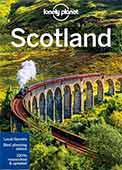
Recent Blog Posts
- A Tour of Jacobite Scotland
- Is Winter a Good Time to Visit Scotland?
- Autumn Tip: The Enchanted Forest
Recent Comments
- Matthew John Anderson on Pine Martens In Scotland
- Ross egan on Pine Martens In Scotland
- Steve Shields on Pine Martens In Scotland
- Become a Pilot
- Aeroplane Lessons
- Helicopter Lessons
- Microlight Lesson
- Gyrocopter Lesson
- Drone Lesson
- Flying experiences
- Introductory Flight
- Flight Simulators
- Boeing 737-800 Simulator
- Airbus A320 Simulator
- Sightseeing Tours
- Helicopter Tours Glasgow
- Helicopter Tours Edinburgh
- Helicopter Tours Stirling
- All Helicopter Tours
- Private Helicopter Tours
- Helicopter Charter
- View all in Flying
- Supercar Driving
- Supercar Self-Drive Hire
- Supercar track days
- Ingliston Circuit
- Fife Airport Circuit
- East Fortune Circuit
- Crail Circuit
- Teen Supercar Drive
- Extreme Machines
- Tank Driving
- Tractor Driving
- Off Road Driving
- Quad Biking
- Lorry Driving
- Junior Driving Lessons
- Segway Tours
- Supercar Passenger Experiences
- Classic Car Hire
- Electric Trial Bikes
- View all in Driving
- Loch Lomond
- Champagne Cruise on Loch Lomond
- Kayaking on Loch Lomond
- White Water Rafting
- Speedboats & Jet Skis
- Paddle Sports
- Sailing Experiences
- Historic Steamship Cruises
- Loch Tay Sightseeing Cruise
- Edinburgh Sailing Trip
- View all in Boating
- Outdoor Adventure
- Extreme Sports
- Watersports
- Sphereing Adventure
- Bungee Jumping
- Water-skiing
- Coasteering in Dunbar
- Unique Days
- Shark Diving at Deep Sea World
- Husky Sled Riding
- Snow Sports
- Family Adventures
- Zip Wire Trips
- Mountain Bike Trails
- View all in Adventure
- Grand Days Out
- A Day At the Races
- Sightseeing Trips
- Fishing Experiences
- Learn a New Skill
- Photography Experiences
- Pottery & Ceramics
- Floristry & Plant Workshops
- Kiltmaking Experiences
- stone-lettering-carving
- Arts & Crafts
- Luxury Lifestyle
- Music & Recording Studio
- Jewellery Workshops
- Casino Experiences
- Luxury Trips
- Beauty & Make-up Lessons
- View all in Lifestyle
- Cook Schools
- Vintage Bus Dining
- Perfect Beverages
- Cocktail Making
- View all in Gourmet
- Lodge on Loch Lomond
- Gleddoch House
- Cairndow Stagecoach Inn
- Hotel voucher
- Gleddoch Spa
- Rejuvenate Spa Experience
- Spa Hotel Break
- Restaurants
- Multi-choice Golf
- Train with a Pro
- Active Kids
- HGV Driving
- Junior Flying Experience
- Flight Simulator Experience
- Educational
- Family Alpaca Trek
- Family days
- Recording Studio Session
- Family Quad Biking
- View all in Family
- Open Value Voucher
- Open value voucher
- Revalidations
- Revalidate voucher
- Everything Else

1 Year validity
Changed your mind, free exchanges, scotland's biggest, guest support, northern lights sightseeing tour.
The voyage of a lifetime - depart from Edinburgh or Glasgow Airport and fly north on a hunt for the beautiful and mysterious Northern Lights. Find out why you should buy a gift from Experience Gift Scotland . Vouchers are delivered as Gift Voucher or instantly printable E-tickets .
Refine Products
- Less than £ 50
- £ 50 - £ 100
- £ 100 - £ 200
- £ 200 - £ 300
- More than £ 300
Can't find a gift you like?
Give them a choice with a value voucher. With the same great validity as an experience voucher, they choose what they want to do from our catalogue of 593 experiences!
You can also earn Gift Rewards on this purchase

7 Day Northern Lights Tours & Trips
- Choose from 50+ tours
- 1,400+ verified reviews from TourRadar travelers
- 24/7 customer support
10 best 7 Day northern lights tour packages
Compiled by

Melissa travel expert at TourRadar
Epic of Sommarøy Island Tailor Made Private Tour
Golden triangle tour delhi agra jaipur 5n/6d, epic of nordic lights, new years land of the northern lights comfort - 5 days, 6 day guided tour | hidden powers & northern lights hunt - small group, norway's northern lights and huskies adventure, land of the northern lights - 5 days, nordlicht-kulturpaket, 5 day - snaefellsnes, south coast and northern lights, northern lights escape.
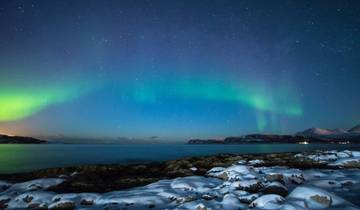
- Northern Lights
- Search for Northern Lights on a campfire tour
- Cruise under the Arctic skies for Northern Lights
- Join a husky safari outside Tromsø

- Christmas & New Year
- Explore the historic Red Fort in Delhi
- Experience a Rajasthani dinner and show
- Check into your hotel in Delhi
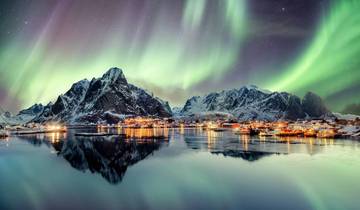
- Sail along the coast with the Hurtigruten
- Explore Lofoten's fishing villages on a guided tour
- Experience husky sledding and meet puppies
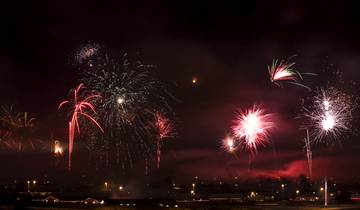
- Visit Eyjafjallajokull and Skogafoss waterfall
- Experience New Year's Eve by Icelandic bonfires
- Tour the Golden Circle and dine on local cuisine

- Coach / Bus
- Sightseeing
- Meet Icelandic horses and taste local treats
- Explore the Aurora at Northern Lights Centre
- See icebergs at Jokulsarlon Glacier Lagoon
“Iceland is filled with beautiful sights. Our guide tour Haruno was excellent.”
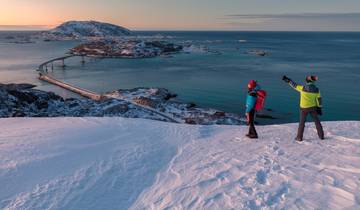
- Cable car ride to the top of Mount Storsteinen
- Hear the story of seafaring in Tromsø while tasting local produce
- Reindeer sledding and Sami culture evening

- Unwind and rejuvenate in the mineral-rich waters of the infamous Blue Lagoon
- Explore Iceland's colourful capital, where every street bursts with cool Nordic style
- Spend your nights in the stunning countryside, the ideal spot for the Northern Lights
“We did see the Northern Lights two nights in a row. The company accommodated us and amended the tour.”

- Stop at Deildartunguhver, a hot spring in Reykholtsdalur
- Capture the incredible Northern Lights on camera
- Hike one of the largest glaciers in Europe, the Vatnajokull
“It was packed with so many things to do. This tour was a great mix of action and sightseeing.”
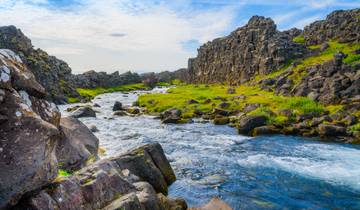
- Be spellbound by the beauty of the Strokkur geyser
- Spend the night on a traditional Icelandic farm
- Admire the spectacular dancing green Northern Lights
“Fantastic trip, great opportunity to see Iceland in a relaxed way, couldn't recommend Intrepid more!”
Travel Styles
Discover TourRadar
Thanks for visiting nordicvisitor.com! For the very best browsing experience on our website, we urge you to upgrade to the most recent version of your browser . Some of our site features may not function properly on older versions.
- Search Suggested Results View All Results
- EUR (€)
- GBP (£)
- Self-Drive i
- Privately Guided i
- Guided Small Groups i
- Northern Lights i
- Honeymoon & Romance i
- Ice & Snow Hotels i
- Multi-Country Tours i
- All Travel Styles
- Show all tours
- Best Sellers
- Special Offers
- Scandinavia
- Switzerland
- United Kingdom
- Book With Confidence i
- Why book with us i
- Travel Update
- Booking Terms i
- Sustainability Policy i
- Manage Booking
- Privacy policy
Iceland Bíldshöfði 20 110 Reykjavík +354 578 20 80 View Map
Sweden Scotland View Details
Northern Lights Tour Packages
Venture to the northern hemisphere to hunt for the aurora borealis and see this breathtaking natural phenomenon first hand. Your northern lights tour package with Nordic Visitor comes with accommodation, activities and transport included.

Witness the aurora borealis dancing above you and explore jaw-dropping landscapes in the Land of Fire and Ice.
Why choose northern lights tours in Iceland?
- Chase the lights on guided excursions from Reykjavík
- Stay at remote lodges with dark skies for aurora viewing
- Discover natural wonders like glaciers and ice caves
- Bathe in hot springs surrounded by wintry scenery
Golden Circle Classic - Winter
Golden circle, blue lagoon & northern lights, northern lights circle tour, iceland's famous ring road.

Winter Highlights & Northern Lights
Ice cave & glacier lagoon.

Hunt for the aurora borealis in Norway and admire the dramatic mountains, coastline and islands of the north.
Why go aurora-hunting in Norway?
- Marvel at the lights on an aurora coastal cruise
- Embark on a dog sledding northern lights safari
- Enjoy guided aurora excursions from Tromsø
- Stay at the extraordinary Kirkenes Snow Hotel
Northern Lights by Train and Cruise
Tromsø, flåm & the fjords, best of northern norway classic - 71° north cape, northern lights & cruise, northern lights norway classic.
Experience snowy scenery, Sami culture and winter activities in Finnish or Swedish Lapland on a northern lights adventure.
Why chase the northern lights in Lapland?
- Enjoy an enchanting aurora tour by snowmobile
- Gaze up at the northern lights from a cosy glass igloo
- Stay in a room made of ice at the legendary ICEHOTEL
- Witness the aurora dancing above Abisko National Park
Best of Lapland - Guaranteed Departure
December 18, 2024, best of rovaniemi - classic, santa claus village & dog sledding, lapland adventure - aurora sky station & icehotel.
Journey to a remote land and seek out the northern lights in Svalbard, an Arctic archipelago at the edge of the world.
Why look for the northern lights in Svalbard?
- Experience the mesmerising light of the polar night
- Visit the world’s northernmost town, Longyearbyen
- Go on thrilling dog sledding and snowmobiling tours
- See polar bears and seals in the wild
Best of Svalbard Winter - Express
Best of svalbard winter - classic, need any help so far get in touch with us.
Live chat with travel consultants
Send your queries using our contact form
Call us toll-free to ask your questions
About Your Northern Lights Vacation
Discover the magic of the aurora borealis* on an unforgettable northern lights tour. Explore beautiful destinations in the Nordics on an itinerary that local travel experts have meticulously organised for you.
When you book a northern lights tour package with Nordic Visitor, you get:
• An authentic travel experience planned by an established and trusted agency • A dedicated travel consultant to organise your tour • All relevant bookings for your chosen package • A detailed online personal itinerary • Handpicked accommodation for a relaxing stay • 24/7 emergency phone support for peace of mind
Nordic Visitor has made it easy to start planning your winter tour. Simply follow these steps:
1. Pick your favourite Nordic Visitor tour 2. Confirm your package 3. Check your confirmation email 4. Book your flights 5. Get ready for your trip
*Please note, the northern lights are a natural occurrence and sightings cannot be guaranteed.
Why choose Nordic Visitor

Book With Confidence
Secure your trip your way with Nordic Visitor. Book a tour with as little as 10% deposit. With a 20% deposit or more, you will receive our Cancellation Protection free of charge. You can also pay the full price right away to guarantee today’s exchange rate. Terms & conditions apply.

Trusted local travel experts
Established in 2002, Nordic Visitor is a highly rated tour agency in Northern Europe. Our travel experts create authentic journeys filled with the best activities and destinations. They are locally based and add their in-depth knowledge to all northern lights itineraries.

Great reviews
Nordic Visitor is dedicated to the best service quality, and this is reflected year after year when Tripadvisor awards us with their Certificate of Excellence. We also take great pride in our customer feedback: 97% of our travellers say they would recommend us to friends and family.

Stress-free experience
Our travel consultants will plan and book your trip on your behalf. You’ll receive a personalised itinerary with your accommodation and activities all arranged for you. That way you can leave all the practicalities to someone else, while you relax and look forward to your northern lights adventure.
Flexible tour options
The Nordic Visitor travel team has designed our northern lights packages to include the very best routes and experiences. However, if you’d like to add extra nights, attractions or destinations, your personal travel consultant will happily tailor your northern lights package.

You are in good hands
Should you encounter any unexpected weather or events during your tour, don’t worry. Nordic Visitor will be there for you throughout your trip. We will take care of reworking your itinerary while keeping you safe and informed. You’ll also have access to our 24/7 emergency helpline for peace of mind.

Full financial protection
With Nordic Visitor, you have peace of mind knowing your tour arrangements with us are 100% financially protected. Your payments are safeguarded as we comply with European Union laws on Package Travel regulations. This guarantees you a refund in the unlikely event of insolvency.
NORTHERN LIGHTS TOUR REVIEWS
Here’s what our wonderful customers liked about their northern lights experiences.
Larus made the whole experience of organising the holiday very enjoyable. We are not seasoned travellers but... read more
Larus made the whole experience of organising the holiday very enjoyable. We are not seasoned travellers but this experience has given me no doubt in using Nordic Visitor again to book a holiday in the future to another Nordic destination.
Kim Singapore
Overall an amazing experience, accommodation were excellent, transfers and check-in were smooth. Will certainly use... read more
Overall an amazing experience, accommodation were excellent, transfers and check-in were smooth. Will certainly use Nordic Visitor again for future vacations.

Northern Lights Vacation Highlights
Picture yourself in a stunning winter landscape in the northern hemisphere. You’re wrapped up warm and the world’s greatest light show is about to begin. Opt for a Nordic Visitor northern lights tour, and you could…
- Take a guided tour from Reykjavík to hunt for the northern lights in Iceland
- Explore ice caves on a guided glacier hike in Vatnajökull , home to Europe’s largest glacier
- Venture to the remote Westfjords to chase the aurora and try snowshoeing
- Go dog sledding and snowmobiling in Tromsø , Norway, or Longyearbyen , Svalbard
- Discover charming fishing villages, mountains and marine wildlife in the Lofoten Islands
- Sample Norwegian delicacies in Kirkenes , such as red king crab, Arctic char and cloudberries
- Join an unforgettable snowmobiling , dog sledding or snowshoeing aurora safari in Lapland
- Visit the Aurora Sky Station in Abisko National Park for dinner with a view of the northern lights
- Admire the auroras from a glass igloo in Lapland, or sleep in an ice hotel in Kiruna or Kirkenes
Frequently asked questions about Northern lights tours
For tips on viewing the northern lights, read on. We’ve answered the most commonly asked questions about Nordic aurora borealis tours here to help you make your dream trip a reality.
Alternatively, find out how to make a booking , have a look at our FAQs , or learn about our Book With Confidence travel plan.
1. ARE THE NORDICS SAFE TO TRAVEL TO?
Yes, the Nordics are widely regarded as safe for visitors. Actually, the Nordic nations – Iceland, Sweden, Norway, Denmark and Finland – continually rank among the top 10 safest places in the world . This is because they have low crime rates, good standards of healthcare, and excellent road safety.
2. WHAT ARE THE NORTHERN LIGHTS?
The northern lights, or aurora borealis, are a natural phenomenon. You can see them illuminating the sky when charged particles from solar flares collide with atoms in the Earth’s atmosphere, near the North Pole. This collision creates varied shapes and colours that ripple, flash or glow in the sky.
3. WHAT MONTHS CAN YOU SEE THE AURORA BOREALIS?
You have the best chance of spotting the aurora borealis in the winter months – October to April. To make out the colours of the aurora, you need dark winter nights. In the summer, daylight hours are so long that you’ll find the sky is too bright to see the glowing lights.
As it is a natural occurrence, spotting the northern lights is not guaranteed. But you can increase your chances of witnessing them by visiting the Arctic Circle in winter.
4. WHEN IS THE BEST TIME TO SEE THE NORTHERN LIGHTS?
As you need a dark sky to distinguish the aurora, the best time to see the northern lights is at night. The peak hours tend to be between 11 PM and 2 AM, which is why your guided tour will likely depart after 9 PM.
You could also stay at a hotel with an aurora wake-up service. The staff will let you know if the lights come out late in the night, so you don’t have to stay up waiting for them!
The best time of year to see the northern lights is winter, between October and April. This is when Nordic nights are the longest and darkest, which means you have higher chances of catching sight of the aurora.
Winter is a great time to visit the Nordics for other reasons too. Check out these guides to the top winter activities you can enjoy:
- • Things to do in Norway in winter
- • Things to do in Iceland in winter
- • Things to do in Lapland in winter
5. WHERE IS THE BEST PLACE TO SEE THE NORTHERN LIGHTS?
You can see the aurora borealis at high northern latitudes, especially around the Arctic Circle, as this is where solar activity is strongest. That’s why the Nordic region is the best place to see the northern lights. Iceland, Norway, Sweden, Finland and Svalbard all lie within or near the Arctic Circle.
In fact, Iceland and the northern regions of Norway, Sweden and Finland are located within the “aurora zone”. Also known as the “northern lights belt”, this is a latitudinal band between 65-72°N where high auroral frequency and intensity occurs. Visit this zone for the best chance of seeing the aurora.
Read these expert guides to learn where and when to see the northern lights in:
- • Europe
- • Iceland
- • Norway
- • Finland
- • Sweden
6. WHERE CAN YOU SEE THE AURORA BOREALIS IN SCANDINAVIA?
Norway, Sweden and Denmark are the countries that make up Scandinavia. If you want to go to Scandinavia to hunt for the aurora borealis, your best bet is to visit the northern parts of this region – Swedish Lapland and Northern Norway. It is unlikely you’ll see the aurora in Denmark.
You can witness the northern lights in the neighbouring Nordic nations of Finland and Iceland too. Although these countries aren’t technically part of Scandinavia, they have many similarities and also happen to be great places to catch the aurora borealis!
Lapland – an area covering northern Sweden and Finland – is a fantastic destination for aurora chasing. You could head to Rovaniemi in Finnish Lapland, or Abisko National Park near Kiruna in Swedish Lapland.
Or visit Northern Norway for your aurora borealis tour. Take your pick from Norwegian destinations such as Tromsø, Svalbard, Kirkenes, the Lofoten Islands and Nordkapp (North Cape).
Alternatively, go in search of the aurora borealis in Iceland. With its wide open skies and location near the Arctic Circle, you could see the lights from anywhere in the country. For your best chances though, head away from towns with street lights so you can spot the colours more easily.
In Scandinavia you could seek out the aurora borealis in the countryside or on the coast. Plus, not only can you enjoy northern lights tours, but also bucket list activities like dog sledding, snowmobiling, and staying in an ice hotel.
Discover more reasons to visit Norway, Sweden, Denmark and Finland on our ultimate Scandinavia guide .
7. HOW TO SEE THE NORTHERN LIGHTS?
To see the aurora borealis, you need to be in a northern country on a clear, dark night, away from artificial lights. Although the aurora don’t show up on demand, these top tips will give you the best chances of witnessing them.
Firstly, make sure you visit northern regions close to the Arctic Circle. Iceland, Northern Norway, Svalbard and Lapland are the best destinations to see the northern lights in Europe.
Secondly, time your aurora borealis tour for the European winter. The long, dark nights will help you spot the colours lighting up the sky.
Thirdly, avoid light pollution found in built-up areas. This means heading into the countryside where there is less artificial light compared to towns and cities. You could spend some days out in remote areas, or opt for guided evening tours from your city base instead.
Another thing you can do for northern light viewings is check the weather and aurora forecast . Although you can’t do this very far in advance, during your trip you’ll be able to find out if the evening will be clear of cloud or rain and if solar activity will be strong.
You’d also increase your chances of seeing the aurora borealis by taking a guided tour. A local expert would accompany you and take you to all the best spots, sharing their insider knowledge with you.
Read our article on how to see the northern lights for more viewing tips.
8. HOW LONG DO THE NORTHERN LIGHTS LAST?
When the aurora borealis are treating you to their glorious light show, you might find they glow for a few minutes. The lights can show up several times in one night, or last for a couple of hours in one go.
There is no rule as to how long the aurora borealis last, of course, as they are a natural occurrence. If you see them for yourself, no doubt you’ll cherish every second of their beautiful magic.
9. HOW DO YOU PHOTOGRAPH THE AURORA BOREALIS?
The northern lights can be tricky to capture on camera, but with some preparation and the right equipment you can do it. Here are some top tips for photographing the northern lights:
- Use an SLR camera with manual focus
- Bring a tripod as you’ll need to do a long exposure shot
- Get a remote shutter release so you don’t have to touch the camera at all
- Use a slow shutter speed of between 15 and 30 seconds
For more tips on photographing the aurora, see our northern lights travel guide .
10. WHAT SHOULD YOU WEAR TO SEE THE NORTHERN LIGHTS?
It can get rather cold in the Nordic winter, especially if there’s a cool wind. The last thing you want is to feel the chill while you hunt for the aurora borealis at night. That’s why it’s important you pack the right clothing before your trip.
Many northern lights tours will provide you with thermal suits to help you stay warm while you’re out chasing the aurora. It’s also recommended that you wear warm layers underneath.
Here is an essential packing list:
- Insulated jacket and trousers (windproof and waterproof)
- Thermal wool underlayers
- Warm hat, gloves and scarf
- Warm and sturdy boots
Get more packing advice by reading our experts’ tips and tricks on dressing for northern lights viewing .
11. CAN I CHOOSE THE ARRIVAL DATE?
Yes, you can select your chosen arrival date online when reserving your Nordic Visitor tour. For northern lights packages, the arrival dates are between October and April as this is the aurora viewing season.
12. CAN I EXTEND MY TOUR BY A DAY OR TWO?
Absolutely! If you’d like to spend more time in a particular destination, you can request this when booking your tour online. Your dedicated travel consultant will get in touch to confirm the extra days with you.
If you are taking a small group tour, you can add extra nights to the start or end of your trip. This is because the group tour itself is fixed as you will be exploring with fellow visitors on a fixed itinerary.
13. WHEN SHOULD I BOOK MY FLIGHT TICKETS?
You should book your flights once your Nordic Visitor package is confirmed. We recommend you check flights beforehand to find appropriate dates and prices, but only purchase them after your travel consultant has secured your northern lights tour.
Your Nordic Visitor consultant will send you a confirmation email with all the details you need to buy suitable flights.
14. WHAT SHOULD I PACK FOR MY TRIP?
The weather is somewhat unpredictable in the Nordics, no matter the time of year you visit. In winter you should always come prepared for cold temperatures, which means bringing warm clothing. Here are the essential items that we recommend you pack for your trip:
- Warm jumpers or fleeces
- Waterproof and thermal jackets
- Gloves, scarves and hats
- Insulated, waterproof boots
- Thermal underlayers
- Waterproof trousers
For more detailed information on what to pack for your Nordic tour, read our travel guides for Iceland , Norway and Lapland .
Get in touch with us to start planning your trip or for more advice on how to see the aurora borealis. Our travel experts will be delighted to arrange an unforgettable northern lights tour for you.
Our main phone number is +354 578 20 80
How about a live chat with one of our local travel experts
Blog Articles
How to see the northern lights: viewing tips, best times & places to see the northern lights in europe, best times and places to see the northern lights in iceland, a little something about the northern lights.
Whether you have a single question or a special request, we're here for you.
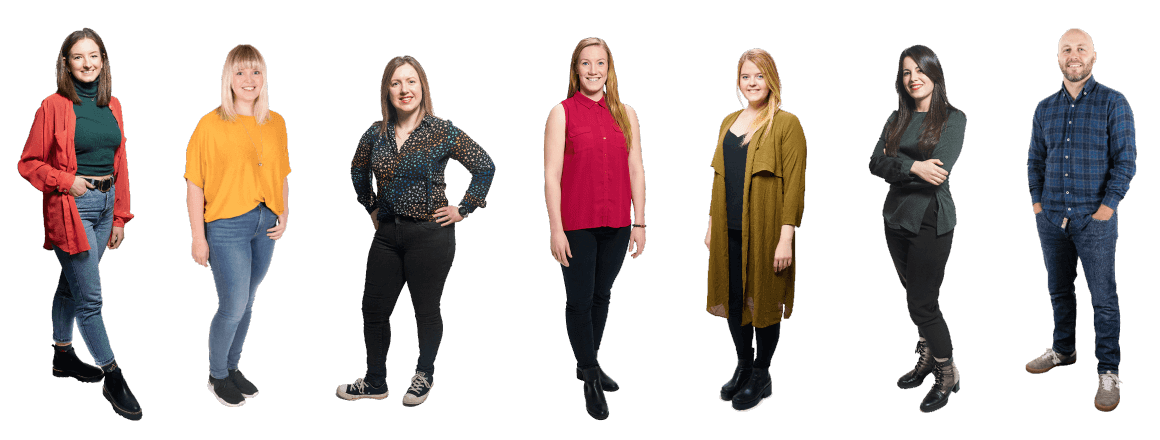
Northern Lights Escape
6 days | travel to iceland and experience its astounding natural features.

Gurgling hot springs, majestic waterfalls, volcanoes alive and extinct, Europe’s biggest glacier – Iceland, where adventures a la naturale await. Discover the raw natural beauty of this spectacular Nordic wonderland on a 6-day trip that will have you stalking close to epic glacial sheaths, feeling the icy spray of the Gullfoss waterfall and becoming acquainted with the culture and cuisine of an Arctic island outpost unlike any other.
Trip overview
- On this trip we are travelling in our own private minibus as this allows us to reach some more off the beaten path destinations and gives us flexibility which would not be possible by public transport. And on top of that all our vehicles in Iceland have complimentary Wi-Fi.
- There's a lot more to Iceland than ice and vikings. Follow the scenic 'Golden Circle', visiting geothermal springs and geysers, the mighty waterfall of Gullfoss and the site of the nation's first parliament at Thingvellir
- Drive along the island’s spectacular South Shore past the Reynisdrangar Rocks and volcanic black sand beaches
- Head to Skaftafell National Park and get adventurous with a hike to Vatnajokull, Europe's largest glacier
- The aurora borealis is the best lightshow on Earth, and this trip is your ticket. Stay up late to see the northern sky dance with green light (subject to weather conditions and activity)
- The Northern Lights (also known as the Aurora Borealis) are a natural display of coloured lights in the night sky of the northern hemisphere. While Northern Light displays can never be guaranteed, as they are a natural phenomenon, you have a higher chance of seeing them in locations at high latitudes, such as Iceland. Please note that weather conditions and overall activity can affect visibility.
- Iceland can be an expensive destination in many ways, from museum entrance fees to visiting a cafe, but especially in terms of eating out. To provide you with an example, a main meal outside of Reykjavik can be around the ISK 4,500 mark. Your leader will be able to advise on how to save money. In remote areas the only option for dinner will be at the guesthouse we are staying at. Please stock up on food at a supermarket prior to arrival if you would like to opt out eating at the guesthouses' restaurants.
- Iceland can be extremely cold at this time of year. Please bring appropriate clothing for adverse weather conditions. There may be the rare occasion where your leader has to alter the itinerary and activities due to the weather which can cause roads being blocked, sites closure etc. Your leader will discuss the necessary changes and alternatives where possible.
- Due to the remote locations we visit, there are a few long drives on this trip. This is a great opportunity to enjoy the scenery and spend some time getting to know the other members of your group.
View the itinerary for departures between 01 January 2023 - 31 December 2024
Hallo! Welcome to Iceland. The world's northernmost capital of Reykjavik lies just below the Arctic Circle. The city sees around four hours of sunlight a day in winter and 22 hours or more in summer. Surrounded by volcanic peaks and crystalline ocean, and boasting a vibrant arts and nightlife scene, Reykjavik's contrasts are utterly beguiling. Why not arrive early and head to the National Museum, which depicts the history of Iceland from the 9th century, when the first Vikings from mainland Scandinavia arrived and settled, to the present day, or join locals who gossip and chatter in the Laugardalslaug Geothermal Pool.
- Hotel (1 night)
There are no meals included on this day.
Your adventure begins with a Welcome Meeting at 6pm today – see reception for more details. If you can't arrange a flight that will arrive in time, you may wish to arrive a day early. We'll be happy to book additional accommodation for you (subject to availability). If you're going to be late, please inform the hotel reception. We'll be collecting your insurance details and next of kin information at this meeting, so please have these on hand. You can check in at the joining point hotel anytime after 2pm. While early check-in is not guaranteed, feel free to store your luggage until needed.
Depart Reykjavik early this morning and follow the route of the 'Golden Circle'. Visit Þingvellir National Park, the site of Iceland's first parliament, founded in AD930, and a geological wonder where the American and Eurasian tectonic plates are pulling apart. If you notice a big ridge of water in the landscape, you’re probably looking at the Silfra fissure. Next, head to Iceland's Geysir geothermal area, where you'll see the Strokkur geyser shoot water 30 metres into the air. Be spellbound by the immense beauty and sheer power of the Gullfoss Waterfall, also know as Golden Falls, before continuing on to the Hvolsvollur Valley, where you'll spend the night on an Icelandic farm that has been converted into a guesthouse. Far away from the city lights, the guesthouse is an ideal Northern Lights base. If the skies are clear tonight, why not take a stroll out into the snow and look skywards for the dancing green lights.
- Guesthouse (1 night)
- Golden Circle - Thingvellir National Park
- Golden Circle - Strokkur Geysir
- Golden Circle - Gullfoss Waterfall
- Fludir - Secret Lagoon - ISK3600
Total driving distance approximately 250 kilometres / 4 hours. Please note that while there is a good chance of seeing the lights of the aurora this far north, there is no guarantee, as they are a natural phenomenon and weather conditions and overall activity can affect visibility. There are a number of apps you can download that show current and forecast activity of the aurora around the world. Some of these apps have a function that allow you to be alerted at night when the aurora becomes visible in your current location. Remember to pack warm clothes, as temperatures can drop to below –5°C.
Start the day with a trip to the eerily beautiful Skógafoss waterfall, one of the biggest waterfalls in Iceland. Skógafoss is a giant of a waterfall, 25 metres wide and also dropping down 60 metres. You can get up close and feel its power, and also climb a (long) windy set of stairs up to a stunning viewpoint. On a sunny day you should be able to spot a rainbow or two in the spray. Continue along Iceland's South Shore to take in more of the country’s renowned natural wonders. From the stepping-stone rock formations of Reynisdrangar, the promontory of Dyrhólaey, and the night black sand beach of Reynisfjara, this is one of the country's most scenic regions. En route you will pass the lava of the Laki eruption of 1782 to 1783. In the afternoon, you will visit the famous Jokulsarlon Glacier Lagoon, a stunning sea of floating icebergs whose blue contrast with the charcoal coloured sand of the beach. Stop for the night at a farm stay on the South Coast. Weather permitting, there will be another opportunity to step outside and witness the natural wonders of the Northern Lights tonight.
- Jokulsarlon - Glacier Lagoon
- Skogafoss - Waterfall Visit
- South Coast - Dyrholaey Viewpoint
Total driving distance approximately 350 kilometres / 5 hours
Today you'll take a walk on Europe's biggest ice cap – Vatnajokull – which has around 30 glaciers flowing out from it. No experience is necessary to partake in the hike. It’s sobering to think that the glacier is retreating due to rising world temperatures, and in some years the glacier may be gone. Alternatively, if you would like to opt out, just embark on a hike to the glacier's tongue or return to the glacier lagoon at Jokulsarlon or Fjallsarlon. If you prefer a relaxing morning you can explore the surroundings of the farmstay and head to the Thorbergur Centre. Later on today, journey on to the black sand seaside town of Vik. With the sea on one side and high cliffs on the other, this dramatically positioned quaint little village is Iceland's most southerly mainland settlement.
- Vatnajokull - Glacier Hike
Total driving distance approximately 250 kilometres / 3-4 hours. Please note that today's glacier walk, it's length and distance covered is dependent on weather conditions. In order to be able to fit the ice crampons you will need to wear ankle high shoes.
This morning we make our way to the beautiful waterfall of Seljalandsfoss, and then back to Reykjavik. Upon arrival take a short guided walk of Reykjavik to get an enhanced appreciation of the city around its landmark attractions and points of interest. Visit the old harbour, the city center and the famous Hallgrimskirkja church. Iceland's capital has an eclectic arts and music scene, an abundance of quirky cafes and a laid-back vibe. Perhaps browse some of the city's great art galleries. If you haven't had enough of the Northern Lights yet, you could head out of town to chase them again this evening, or while away the hours with a soak in the geothermal waters of the famous Blue Lagoon. Whatever you choose, tonight perhaps gather together your fellow Icelandic adventurers and celebrate the end of this Northern Lights Escape.
- Reykjavik - Leader-led walking tour
- Reykjavik - Settlement Exhibition - ISK2900
- Reykjavik - Saga Museum - ISK3600
- Reykjavik - Whales of Iceland Museum - ISK4300
- Reykjavik - Maritime Museum - ISK2350
- Reykjavik - Harpa Concert Hall - Free
- Reykjavik - Perlan Museum - ISK5390
Total driving distance approximately 200 kilometres / 3 hours. Please note that arrival back into Reykjavik is usually at around 3pm. Due to frequent delays during winter it is recommended you do not book any time slots for the Blue Lagoon before 6pm (or preferably tomorrow). Please also keep in mind that the Blue Lagoon has limited availability, and during peak times tickets sell out far in advance. We recommend you book your time slot online in advance if you would like to be sure of a certain time/date for your visit: bluelagoon.com.
Today is departure day and time to say 'sjaumst'. As there are no activities planned, you are able to depart the hotel at any time. Check out time is at midday. If you are departing later, you can arrange to store your luggage at the hotel. If you would like to stay longer, we are happy to book additional accommodation for you (subject to availability). Perhaps browse some of the city's great art galleries. If you feel like something more active, book yourself on a Silfra Fissure snorkelling adventure, where you’ll discover this underwater ridge with water visibility of up to 120 metres.
- Reykjavik - Silfra Fissure Snorkelling Day Trip inc return transfer from Reykjavik - ISK28490
- Nauthólsvík - Thermal Beach - Free
- Reykjavik - Lava Tunnel Tour - ISK13900
- Reykjanes Peninsula - Blue Lagoon inc return transfer - ISK18980
5 breakfasts
Private minibus with free Wi-Fi
Guesthouse (3 nights), Hotel (2 nights)
Dates and availability
Important notes.
1. A single supplement is available if you’d prefer not to share a room on this trip. The single supplement applies to all nights of your trip and is subject to availability. Please note that due to the small properties we use in Europe there is only a limited amount of single supplements available per trip departure. Please speak to your booking agent for further information. 2. Iceland can be an expensive destination in many ways, from museum entrance fees to outdoor activities, but especially in terms of eating out. Your leader will be able to advise on how to save money. In remote areas the only option for dinner will be at the guesthouse we are staying at. Stock up on food at a supermarket prior to arrival if you would like to opt out eating at the guesthouse's restaurant. Please make sure you read the trip notes carefully in order to know what is and what isn't included in the trip price.
Want an in-depth insight into this trip? Essential Trip Information provides a detailed itinerary, visa info, how to get to your hotel, what's included - pretty much everything you need to know about this adventure and more.
Filter by rating

IMAGES
VIDEO
COMMENTS
Northern Lights. The Northern Lights - also called the Aurora Borealis - are nature's very own theatrical performance. It may be a surprise to you, but northern Scotland actually lies at the same latitude as Stavanger in Norway and Nunivak Island in Alaska, which means that you're in with a good chance of spotting the 'Mirrie Dancers'.
When to see the aurora borealis in Scotland. The northern lights don't show up regularly in Scotland, however much we wish they did. Timing is everything, although nothing is guaranteed when it comes to natural phenomena like this. You are more likely to see the northern lights in Scotland between September and March.
Other Possible Aurora Spots in Scotland. Photo credit: Paul Wordingham via Flickr. In addition to the above listed, there are a few other spots you might add to your list while trying to see the northern lights in Scotland: Dunbar - East of Edinburgh along the coast. Caithness - Far northeastern Scotland.
If the aurora is particularly strong, it can be seen over the capital city when there is little moonlight, but only in those elevated areas that are away from street lights. The best locations for seeing the northern lights in Edinburgh are Calton Hill, Blackford Hill, and Holyrood Park.
Caithness is the northeastern region of mainland Scotland, making it one of your best options if you can't be bothered to trek to one of the islands. The best places to see the northern lights in Caithness include Noss Head, Duncansby Head, and Dunnet Head. All three are cliffy locations with unlit lighthouses.
Without a doubt, the best time of year to spot the Northern Lights in Scotland is between September and March. During these months, the nights are long and dark, giving you the best chance to catch a glimpse of the Aurora Borealis dancing across the night sky. Isle of Skye. The Isle of Skye, located off Scotland's west coast, is one of the best ...
3. Caithness and Sutherland: Wilderness and Wonder. For those seeking a truly wild and untouched Northern Lights experience, Caithness and Sutherland are the ideal destinations. These remote regions in the far north of Scotland boast vast open landscapes, rolling hills, and stunning coastlines.
Tour Essentials. Welcome to the Scotland Northern Lights tour. Get ready to experience the beautiful Scottish landscapes, history, and warm welcome everywhere you visit. Northern Lights are a natural astronomical phenomenon called polar lights (aurora polaris). Northern lights are called by their scientific name, aurora borealis, but we cannot ...
1. Shetland Islands - The Shetland Islands, located off the north coast of Scotland, are one of the best places in the country to see the Northern Lights. The islands' remote location and clear skies make it an ideal spot to catch the aurora borealis in action. 2. Caithness - The county of Caithness in the Scottish Highlands is another great ...
Located in the Inner Hebredies, the Isle of Mull is a wonderful spot to see the Northern Lights. Just off the west coast of Mainland Scotland, a short ferry ride away from Oban, this gorgeous island has the ideal conditions to spot the Northern Lights. With a small population and little light pollution, the regular clear dark skies make it the ...
While the best time of year is during the winter months from September to March. Shetland Islands. The most northerly part of the UK, Shetland provides an ideal location for observing the Northern Lights. Being the closest you'll get to the North Pole in Scotland, Shetland's clear, unpolluted skies create a perfect canvas for the dancing ...
Certainly, the best time to see Northern Lights in Scotland is during long, clear, winter nights. Take a compass with you and point north, or look for the North Star (Polaris) and point in that direction. To find the north star look for the Plough and line up the outer edge and draw a line towards the edge of the Little Plough.
About. This is an unique tour to Scotland Dark Skies. Enjoy the winter landscape of Scotland while chasing the elusive Aurora Borealis on one of our Northern lights tours of Scotland. Read more. Ages 8-99, max of 12 per group. Duration: 8 days. Start time: Check availability. Mobile ticket. Live guide: English.
3 Days/2 Nights. Prices from... £149.00. Description. Excursions. Accommodation. Tour Dates. Join us for a wee weekend break to the Highlands of Scotland this Winter to search for the magical Northern Lights. Our excursion on Sartuday will take you around the scenic Scottish Highlands, then return to the hotel in the evening for your delicious ...
Best months to see the Northern Lights in Scotland. A clear, dark winter night can give you breath-taking views of this display. There can be up to 18 hours of darkness in winter which increases your chance of seeing the aurora. As a general guide, we recommend the following months: October. November.
Top tips for viewing the northern lights. Firstly, you need almost complete darkness with the sky free of clouds. Scotland's remote villages on the north coast are perfect, with no light pollution obstructing views of the aurora. Websites such as AuroraWatchUK are well worth keeping an eye on, as they provide regular updates on any ...
2. Edinburgh. Whilst the city of Edinburgh might not be the most obvious choice for spotting the Northern Lights in Scotland, the capital offers a magical blend of the natural and man-made. The urban landscape and light pollution can make spotting the Aurora Borealis a little more challenging.
So how about chasing the Northern Lights in Scotland? I myself live in the south west of Scotland and have seen the Aurora several times from close to my home and a few times from the north-west of Scotland. ... I don't think there are any "Northern Light Tours" as they don't happen that frequently. You just have to be lucky enough to ...
Northern Lights Sightseeing Tour. The voyage of a lifetime - depart from Edinburgh or Glasgow Airport and fly north on a hunt for the beautiful and mysterious Northern Lights. Find out why you should buy a gift from Experience Gift Scotland. Vouchers are delivered as Gift Voucher or instantly printable E-tickets. Price. Less than £50. £50 ...
The Northern Lights or "Aurora Borealis" is a phenomenon that draws travellers to the windswept wilds of the some of the northernmost places on the planet. Those lucky enough to witness Mother Nature's light show are in for a uniquely breathtaking experience. Best seen as high latitudes when the sky is dark and clear, the Northern Lights ...
The northern lights, or aurora borealis, are the world's greatest light spectacle, a testament to the Earth's raw and untamed beauty, an experience that transcends words. Imagine standing in silent reverence beneath the emerald, violet, and pink hues that paint the sky with luminous brushstrokes. The crisp Arctic air tickles your skin while ...
10 best 7 Day northern lights tour packages. Compiled by. Melissa travel expert at TourRadar. Golden Triangle Tour Delhi Agra Jaipur 5N/6D. Epic of Sommarøy Island Tailor Made Private Tour. Epic of Nordic Lights. New Years Land Of The Northern Lights Comfort - 5 days.
When you book a northern lights tour package with Nordic Visitor, you get: • An authentic travel experience planned by an established and trusted agency. • A dedicated travel consultant to organise your tour. • All relevant bookings for your chosen package. • A detailed online personal itinerary.
The Northern Lights (also known as the Aurora Borealis) are a natural display of coloured lights in the night sky of the northern hemisphere. While Northern Light displays can never be guaranteed, as they are a natural phenomenon, you have a higher chance of seeing them in locations at high latitudes, such as Iceland.